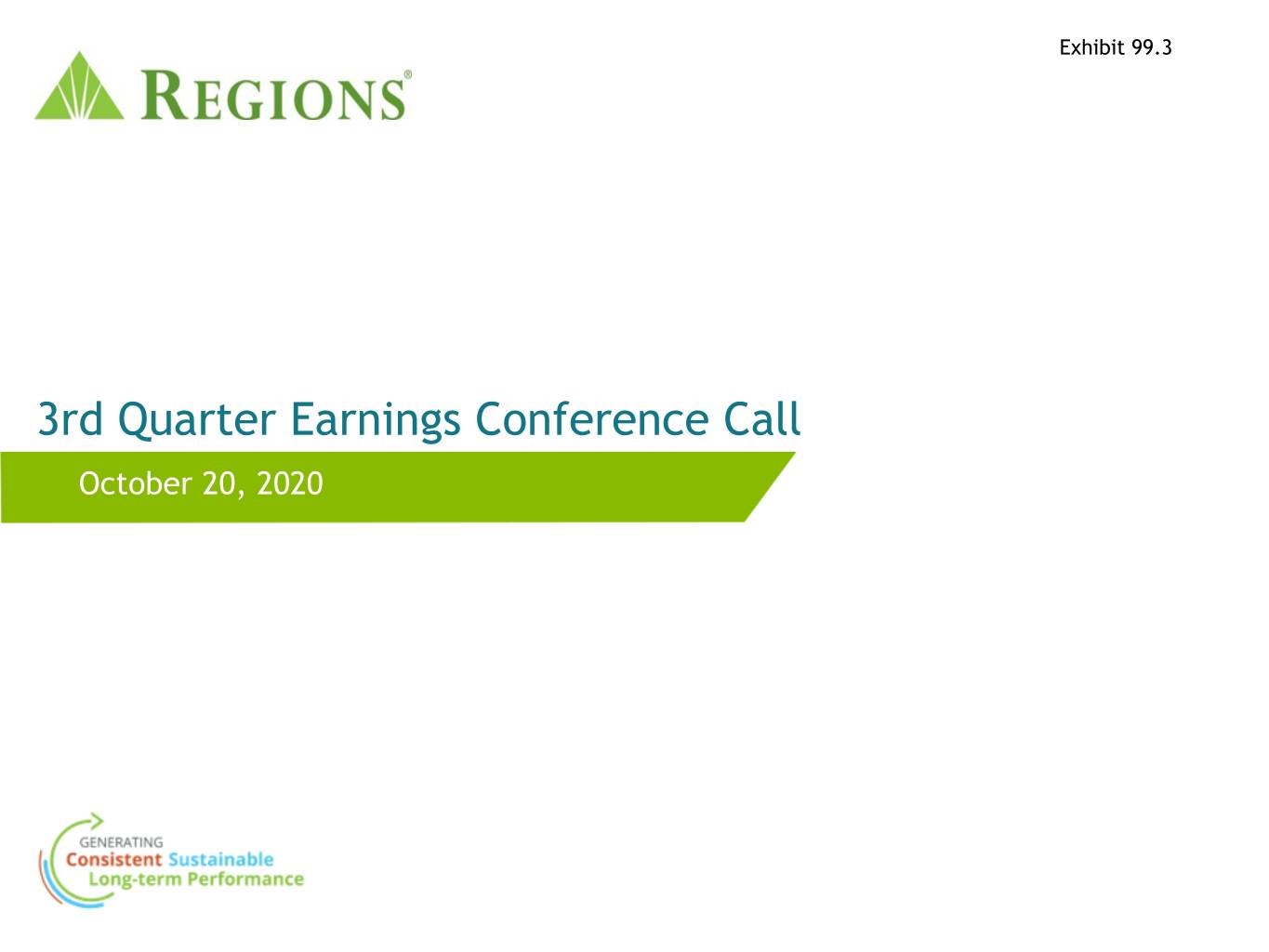
Exhibit 99.3 3rd Quarter Earnings Conference Call October 20, 2020
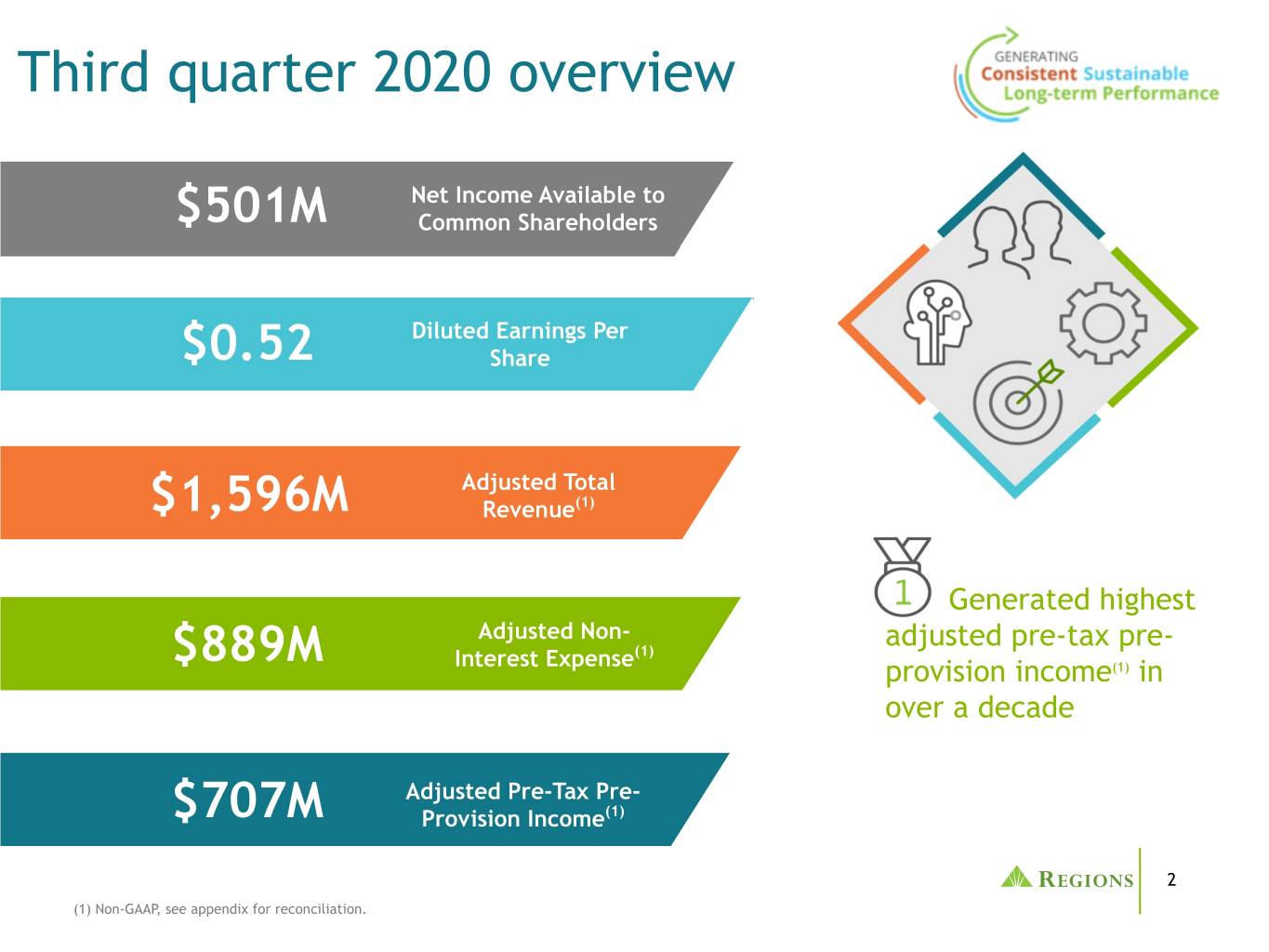
Third quarter 2020 overview Net Income Available to $501M Common Shareholders Diluted Earnings Per $0.52 Share Adjusted Total $1,596M Revenue(1) Generated highest Adjusted Non- adjusted pre-tax pre- $889M Interest Expense(1) provision income(1) in over a decade Adjusted Pre-Tax Pre- $707M Provision Income(1) 2 (1) Non-GAAP, see appendix for reconciliation.
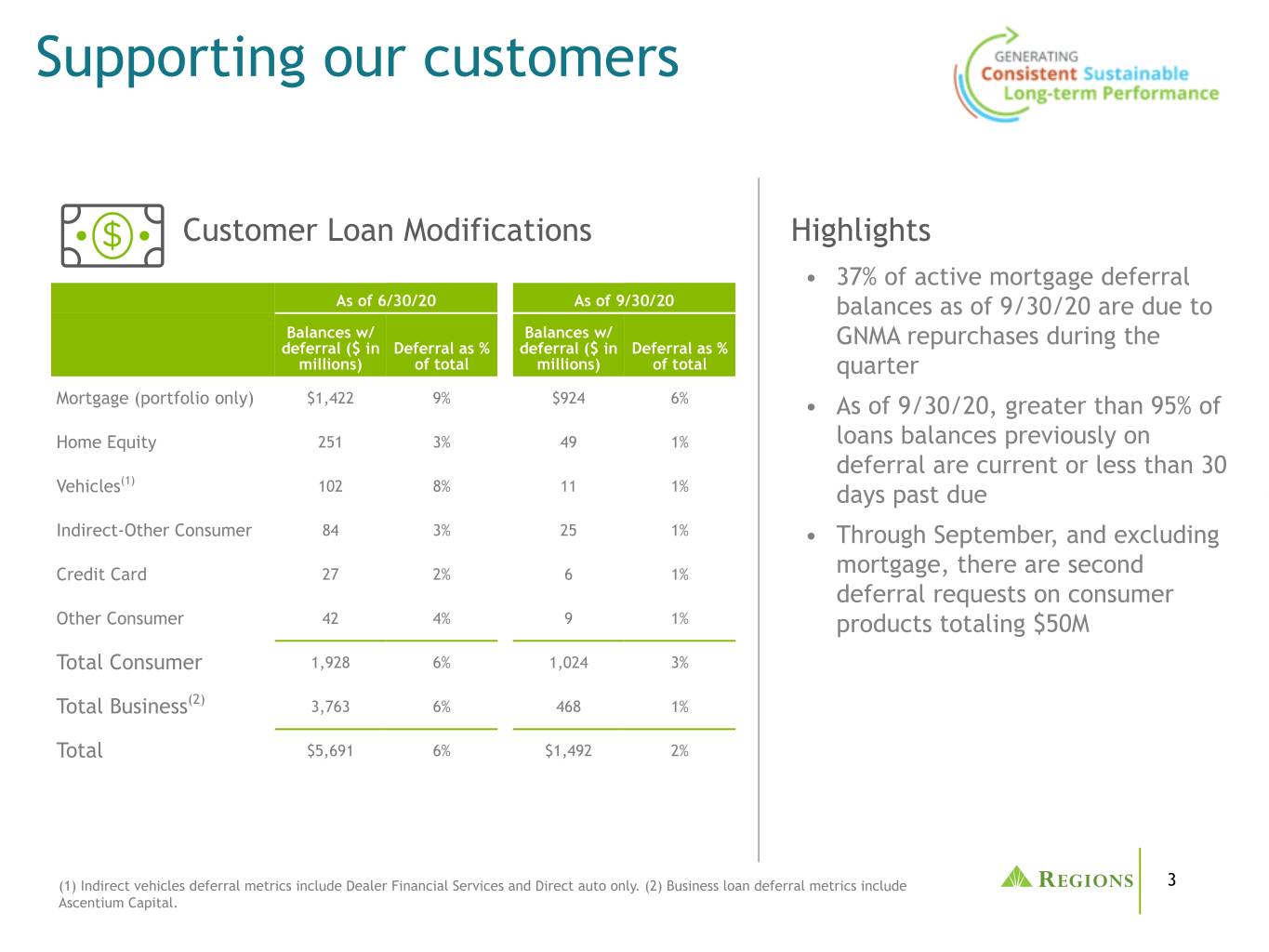
Supporting our customers Customer Loan Modifications Highlights • 37% of active mortgage deferral As of 6/30/20 As of 9/30/20 balances as of 9/30/20 are due to Balances w/ Balances w/ deferral ($ in Deferral as % deferral ($ in Deferral as % GNMA repurchases during the millions) of total millions) of total quarter Mortgage (portfolio only) $1,422 9% $924 6% • As of 9/30/20, greater than 95% of Home Equity 251 3% 49 1% loans balances previously on deferral are current or less than 30 (1) Vehicles 102 8% 11 1% days past due Indirect-Other Consumer 84 3% 25 1% • Through September, and excluding Credit Card 27 2% 6 1% mortgage, there are second deferral requests on consumer Other Consumer 42 4% 9 1% products totaling $50M Total Consumer 1,928 6% 1,024 3% Total Business(2) 3,763 6% 468 1% Total $5,691 6% $1,492 2% (1) Indirect vehicles deferral metrics include Dealer Financial Services and Direct auto only. (2) Business loan deferral metrics include 3 Ascentium Capital.
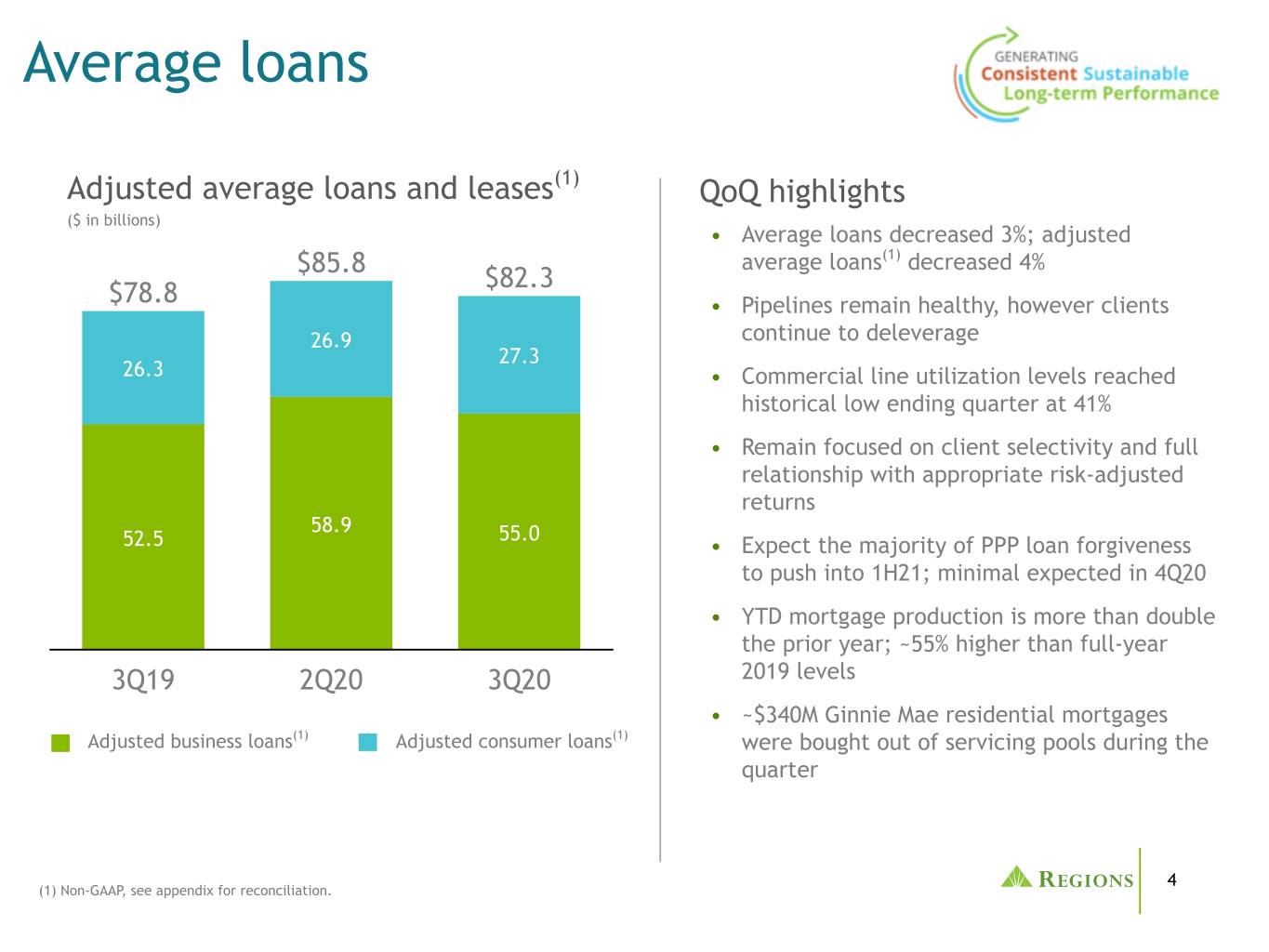
Average loans Adjusted average loans and leases(1) QoQ highlights ($ in billions) • Average loans decreased 3%; adjusted $85.8 average loans(1) decreased 4% $82.3 $78.8 • Pipelines remain healthy, however clients 26.9 continue to deleverage 27.3 26.3 • Commercial line utilization levels reached historical low ending quarter at 41% • Remain focused on client selectivity and full relationship with appropriate risk-adjusted returns 58.9 55.0 52.5 • Expect the majority of PPP loan forgiveness to push into 1H21; minimal expected in 4Q20 • YTD mortgage production is more than double the prior year; ~55% higher than full-year 3Q19 2Q20 3Q20 2019 levels • ~$340M Ginnie Mae residential mortgages Adjusted business loans(1) Adjusted consumer loans(1) were bought out of servicing pools during the quarter 4 (1) Non-GAAP, see appendix for reconciliation.
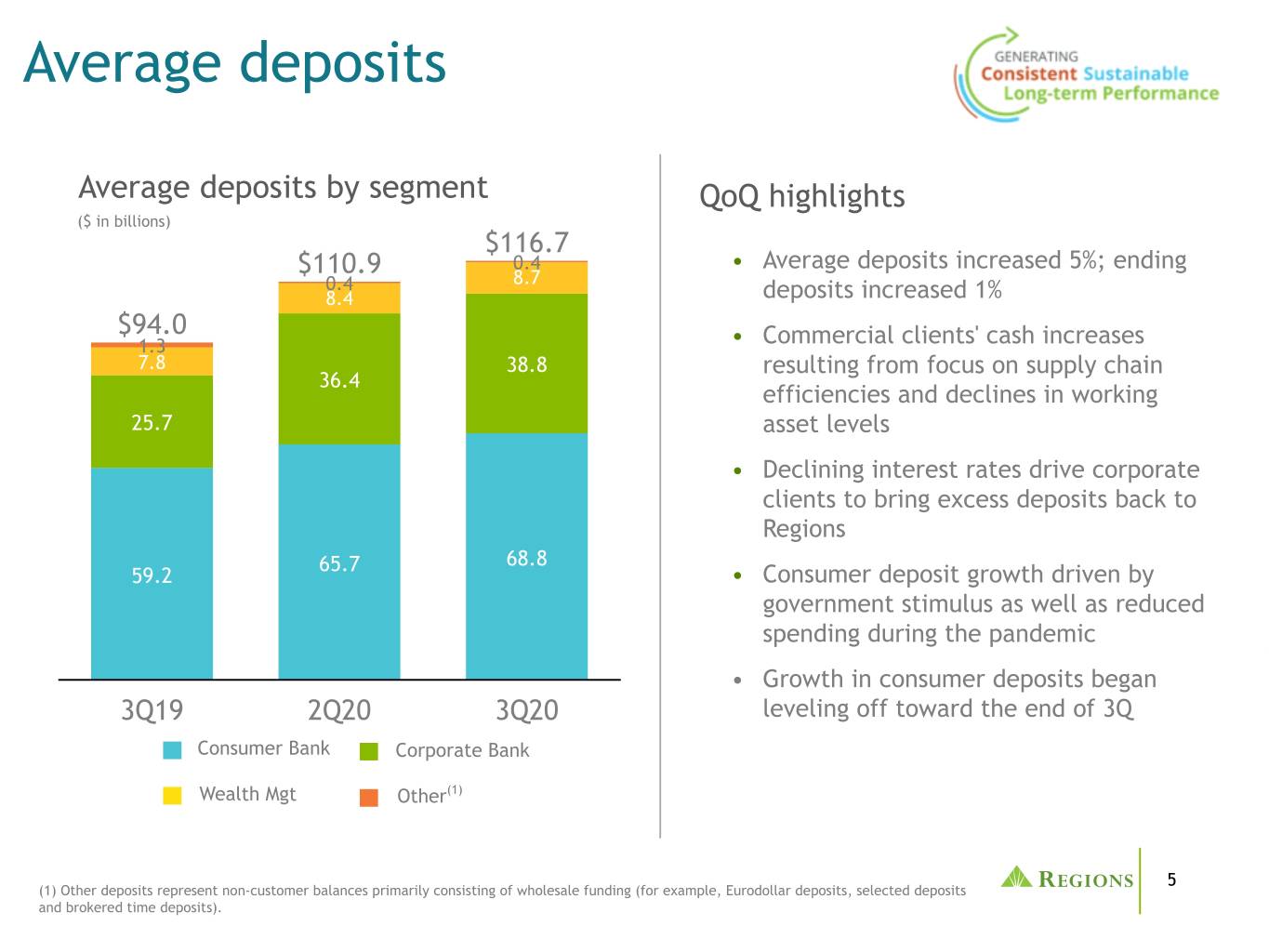
Average deposits Average deposits by segment QoQ highlights ($ in billions) $116.7 $110.9 0.4 • Average deposits increased 5%; ending 0.4 8.7 8.4 deposits increased 1% $94.0 1.3 • Commercial clients' cash increases 7.8 38.8 resulting from focus on supply chain 36.4 efficiencies and declines in working 25.7 asset levels • Declining interest rates drive corporate clients to bring excess deposits back to Regions 65.7 68.8 59.2 • Consumer deposit growth driven by government stimulus as well as reduced spending during the pandemic • Growth in consumer deposits began 3Q19 2Q20 3Q20 leveling off toward the end of 3Q Consumer Bank Corporate Bank Wealth Mgt Other(1) 5 (1) Other deposits represent non-customer balances primarily consisting of wholesale funding (for example, Eurodollar deposits, selected deposits and brokered time deposits).
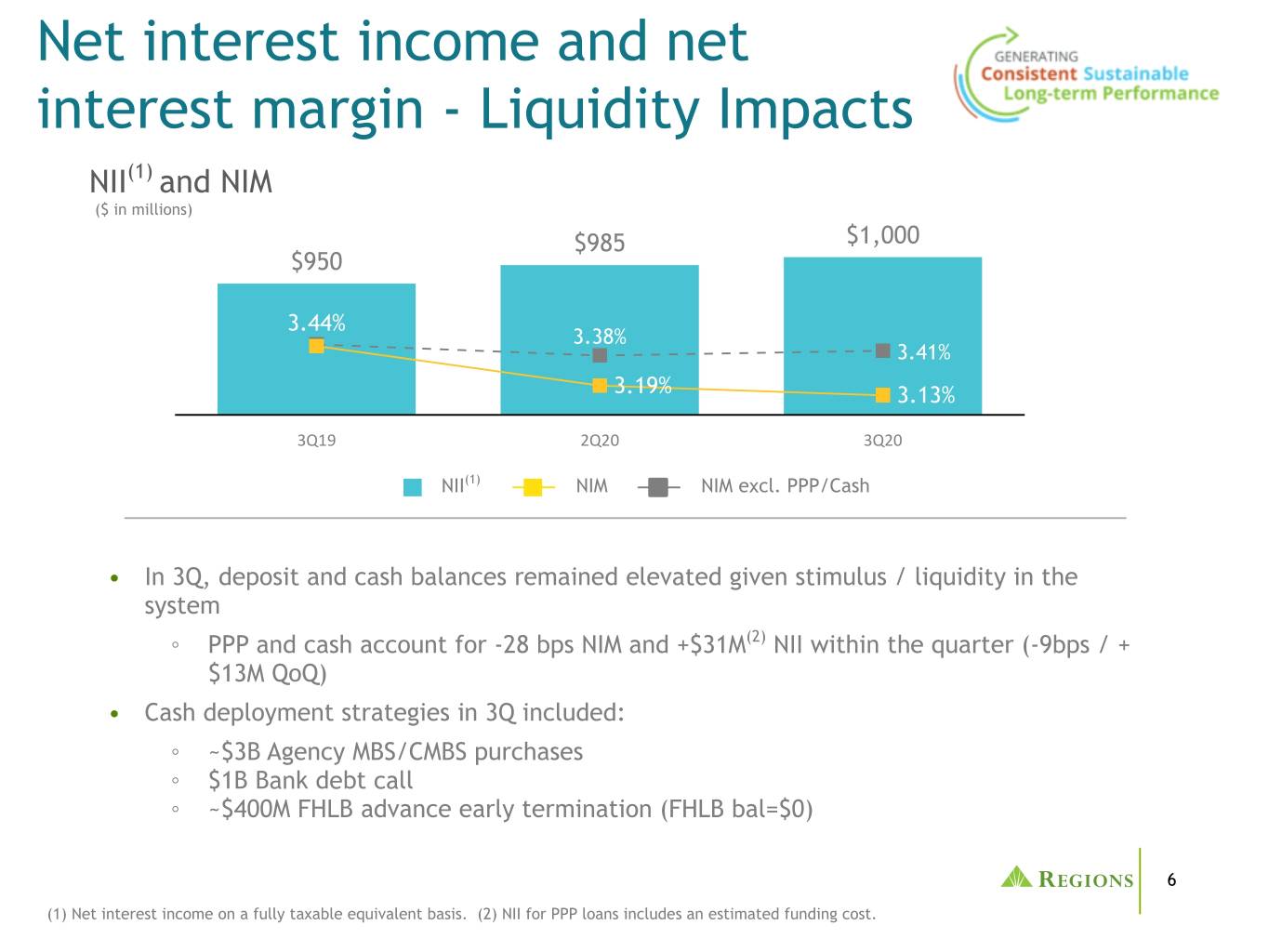
Net interest income and net interest margin - Liquidity Impacts NII(1) and NIM ($ in millions) $985 $1,000 $950 3.44% 3.38% 3.41% 3.19% 3.13% 3Q19 2Q20 3Q20 NII(1) NIM NIM excl. PPP/Cash • In 3Q, deposit and cash balances remained elevated given stimulus / liquidity in the system ◦ PPP and cash account for -28 bps NIM and +$31M(2) NII within the quarter (-9bps / + $13M QoQ) • Cash deployment strategies in 3Q included: ◦ ~$3B Agency MBS/CMBS purchases ◦ $1B Bank debt call ◦ ~$400M FHLB advance early termination (FHLB bal=$0) 6 (1) Net interest income on a fully taxable equivalent basis. (2) NII for PPP loans includes an estimated funding cost.

Net interest income and net interest margin - Core Drivers Core(1) NIM Attribution Core Drivers of NIM and NII • 3Q benefits from +$3B forward starting hedge 3.41% notional becoming active; additional benefit from 3.38% lower short-term rates offsets a portion of the long-term pressure: ◦ Hedging program; $94M NII in 3Q(3) ◦ Deposit pricing advantage; Sept total deposit costs at 10 bps - all-time low • Residual exposure to long-term rates at low levels Non- Lower 2Q20 excl. Hedge Market Cash Days/ 3Q20 excl. recurring loan ◦ Fixed rate loan/securities production at PPP/cash notional rates mgmt other PPP/cash items(2) bals lower rates NIM +2bps +3bps +3bps -2bps -2bps -1bps ◦ Premium amortization; from $33M 2Q to (4) NII +$7M +11M -$18M -$8M +$4M +$7M $46M 3Q Long-term rate and balance sheet • Loan balance declines mostly attributable to C&I deleveraging pressure will persist; loan line normalization and the strategic reduction of balance declines expected to moderate indirect loans 4Q 2020 Expectations • 3Q NII elevated by non-recurring items(2); after normalizing for this, 4Q NII expected to be relatively flat to modestly lower(5) ◦ NII and NIM in 4Q will be pressured by the continued turnover of assets at lower market interest rate levels, and lower loan balances/mix ◦ 4Q hedge benefit estimated at $97M; uncertain timing of PPP fee acceleration to benefit NII/NIM - currently assume no benefit until 2021 • Excluding PPP/cash, NIM expected to remain in the 3.30%s (1) Core NIM excludes PPP and excess cash over $750M. (2) Items that may not repeat include bond call benefits, loan prepayment penalties, 7 other loan yield adjustments, and bond premium amortization associated with elevated Ginnie Mae buy-outs. (3) Hedges remain active; $1.8B unrealized, pre-tax gain, to be amortized into NII over the remaining life of hedges ~4.5 years. (4) Ginnie Mae buy-outs add ~$4M. (5) Assumes Fed Funds Target remains 0%-0.25%, 1m LIBOR 0.12%-0.20%, and 10yr US Treasury is range-bound 0.50% - 0.90%.
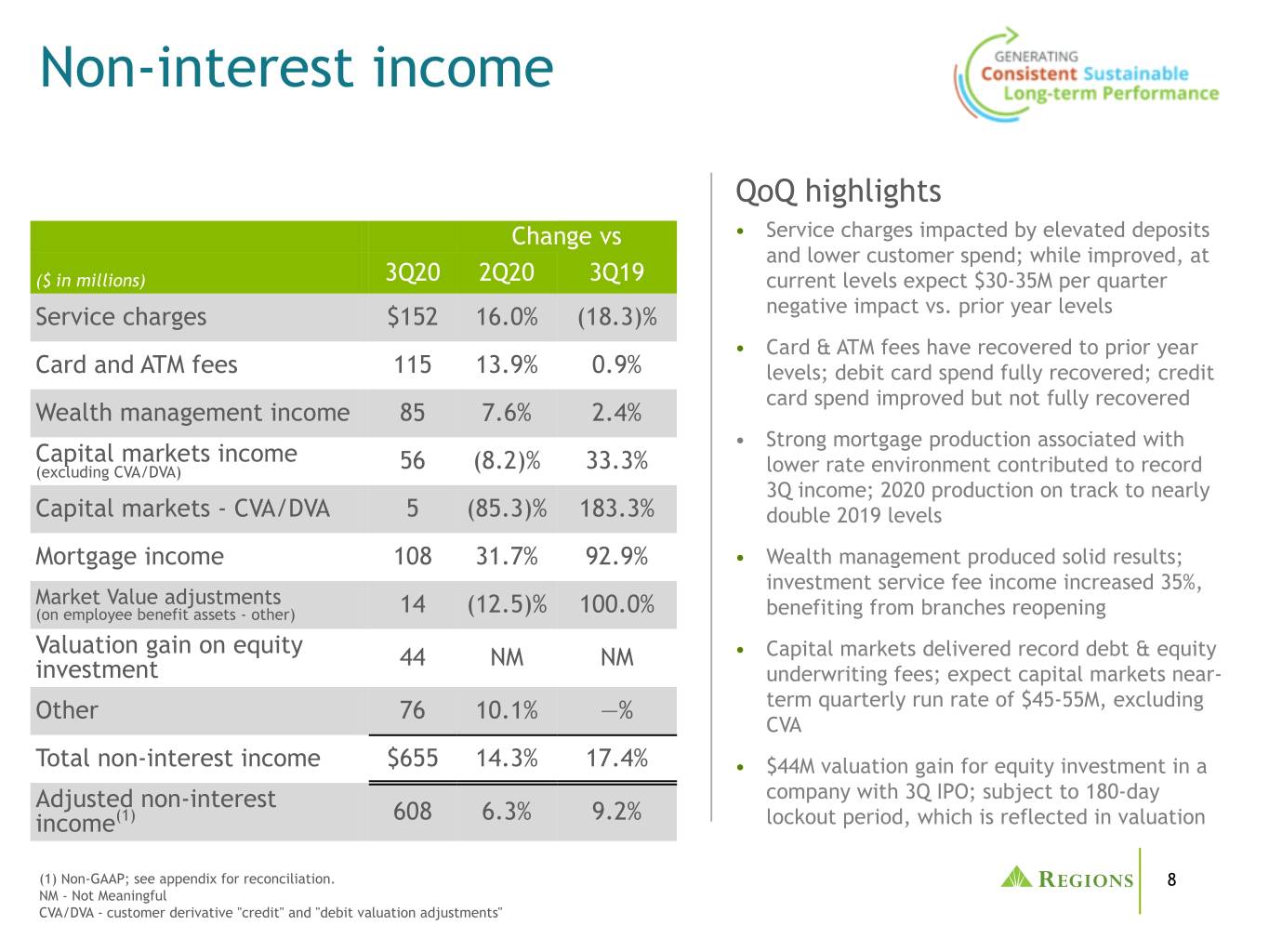
Non-interest income QoQ highlights Change vs • Service charges impacted by elevated deposits and lower customer spend; while improved, at ($ in millions) 3Q20 2Q20 3Q19 current levels expect $30-35M per quarter Service charges $152 16.0% (18.3)% negative impact vs. prior year levels • Card & ATM fees have recovered to prior year Card and ATM fees 115 13.9% 0.9% levels; debit card spend fully recovered; credit card spend improved but not fully recovered Wealth management income 85 7.6% 2.4% • Strong mortgage production associated with Capital markets income (excluding CVA/DVA) 56 (8.2)% 33.3% lower rate environment contributed to record 3Q income; 2020 production on track to nearly Capital markets - CVA/DVA 5 (85.3)% 183.3% double 2019 levels Mortgage income 108 31.7% 92.9% • Wealth management produced solid results; investment service fee income increased 35%, Market Value adjustments (on employee benefit assets - other) 14 (12.5)% 100.0% benefiting from branches reopening Valuation gain on equity 44 NM NM • Capital markets delivered record debt & equity investment underwriting fees; expect capital markets near- Other 76 10.1% —% term quarterly run rate of $45-55M, excluding CVA Total non-interest income $655 14.3% 17.4% • $44M valuation gain for equity investment in a Adjusted non-interest company with 3Q IPO; subject to 180-day income(1) 608 6.3% 9.2% lockout period, which is reflected in valuation (1) Non-GAAP; see appendix for reconciliation. 8 NM - Not Meaningful CVA/DVA - customer derivative "credit" and "debit valuation adjustments"
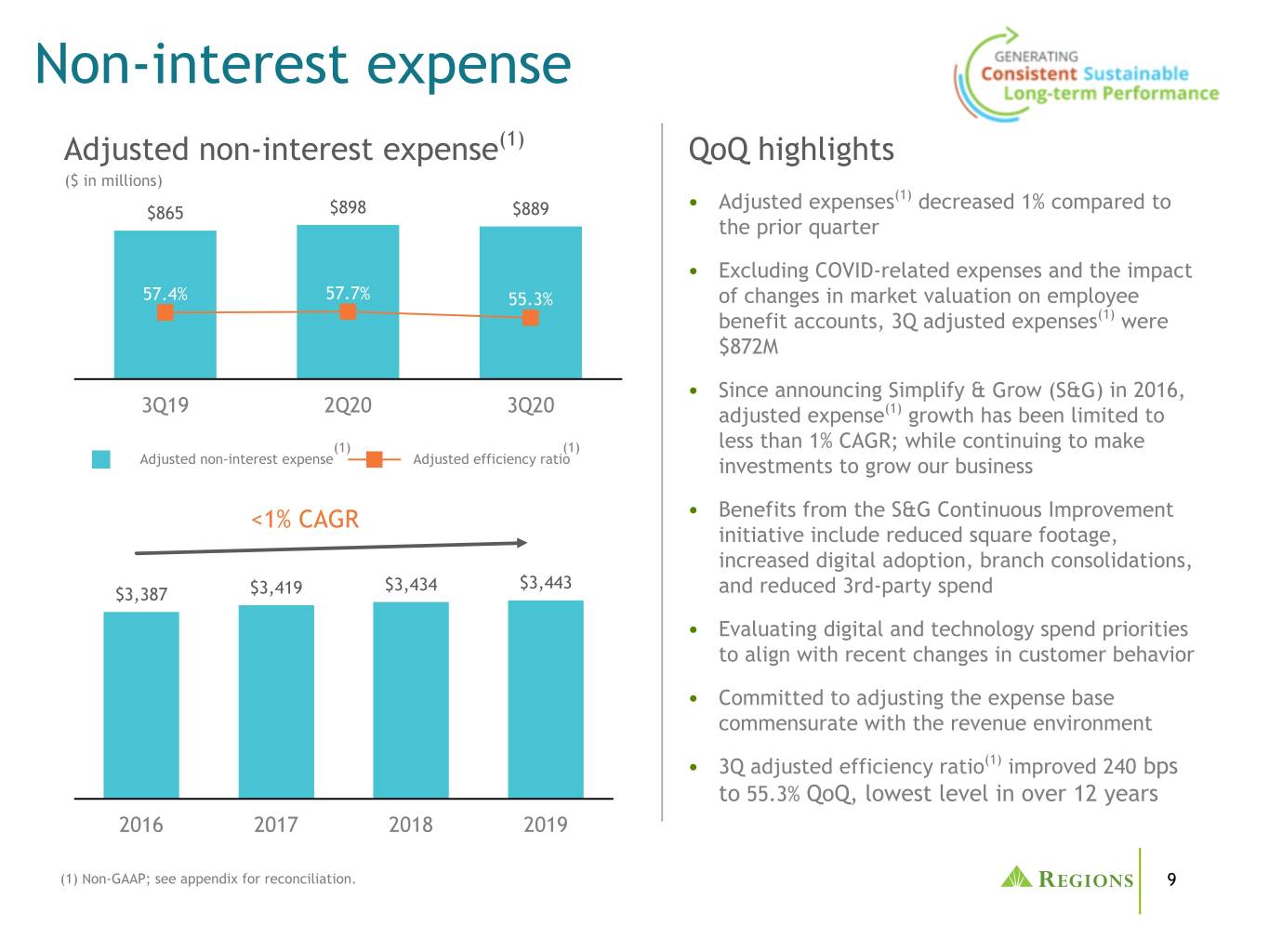
Non-interest expense Adjusted non-interest expense(1) QoQ highlights ($ in millions) • Adjusted expenses(1) decreased 1% compared to $865 $898 $889 the prior quarter • Excluding COVID-related expenses and the impact 57.4% 57.7% 55.3% of changes in market valuation on employee benefit accounts, 3Q adjusted expenses(1) were $872M • Since announcing Simplify & Grow (S&G) in 2016, 3Q19 2Q20 3Q20 adjusted expense(1) growth has been limited to (1) (1) less than 1% CAGR; while continuing to make Adjusted non-interest expense Adjusted efficiency ratio investments to grow our business <1% CAGR • Benefits from the S&G Continuous Improvement initiative include reduced square footage, increased digital adoption, branch consolidations, $3,434 $3,443 $3,387 $3,419 and reduced 3rd-party spend • Evaluating digital and technology spend priorities to align with recent changes in customer behavior • Committed to adjusting the expense base commensurate with the revenue environment • 3Q adjusted efficiency ratio(1) improved 240 bps to 55.3% QoQ, lowest level in over 12 years 2016 2017 2018 2019 (1) Non-GAAP; see appendix for reconciliation. 9
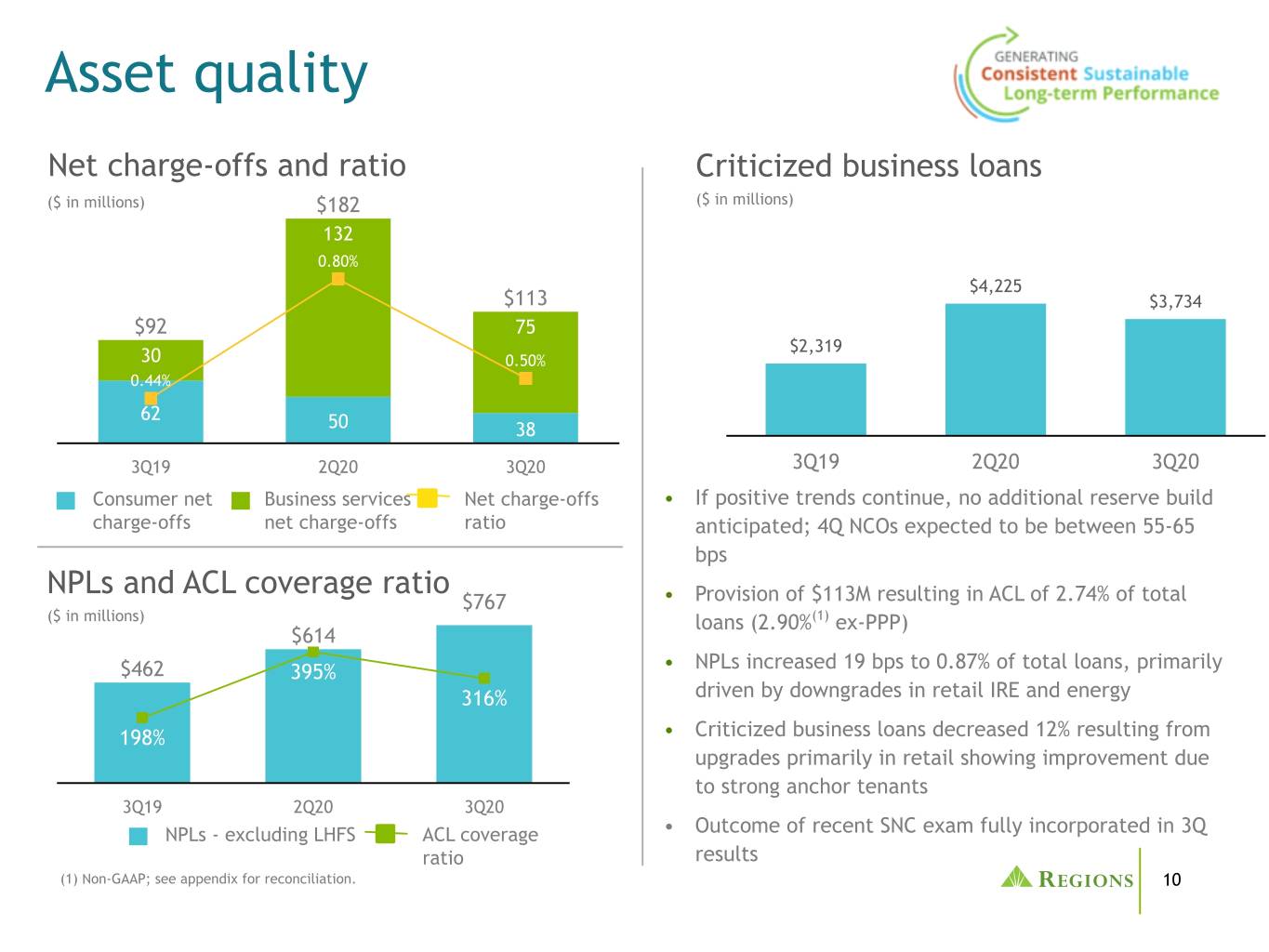
Asset quality Net charge-offs and ratio Criticized business loans ($ in millions) $182 ($ in millions) 132 0.80% $4,225 $113 $3,734 $92 75 $2,319 30 0.50% 0.44% 62 50 38 3Q19 2Q20 3Q20 3Q19 2Q20 3Q20 Consumer net Business services Net charge-offs • If positive trends continue, no additional reserve build charge-offs net charge-offs ratio anticipated; 4Q NCOs expected to be between 55-65 bps NPLs and ACL coverage ratio $767 • Provision of $113M resulting in ACL of 2.74% of total ($ in millions) loans (2.90%(1) ex-PPP) $614 $462 395% • NPLs increased 19 bps to 0.87% of total loans, primarily 316% driven by downgrades in retail IRE and energy 198% • Criticized business loans decreased 12% resulting from upgrades primarily in retail showing improvement due to strong anchor tenants 3Q19 2Q20 3Q20 NPLs - excluding LHFS ACL coverage • Outcome of recent SNC exam fully incorporated in 3Q ratio results (1) Non-GAAP; see appendix for reconciliation. 10
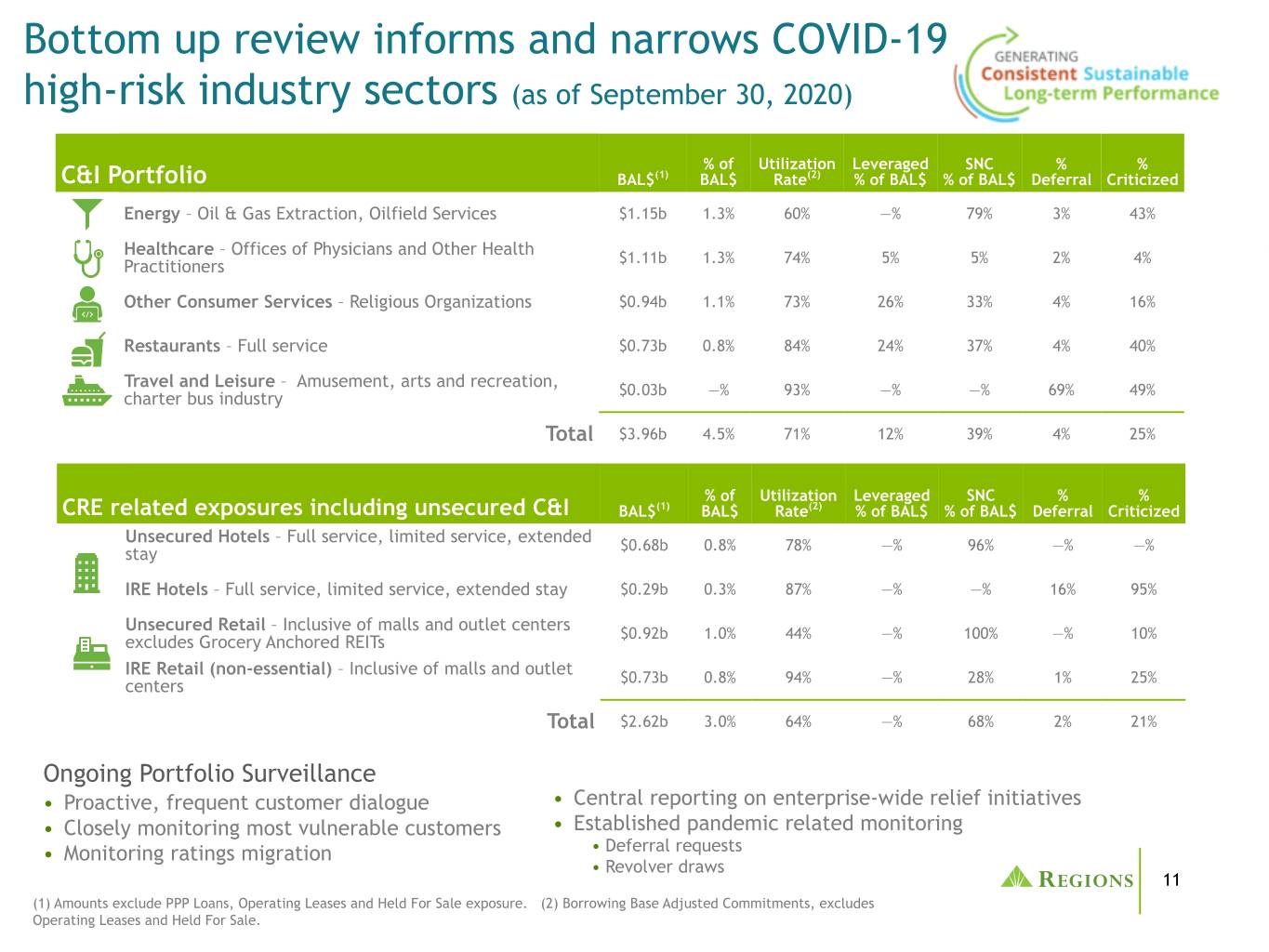
Bottom up review informs and narrows COVID-19 high-risk industry sectors (as of September 30, 2020) % of Utilization Leveraged SNC % % C&I Portfolio BAL$(1) BAL$ Rate(2) % of BAL$ % of BAL$ Deferral Criticized Energy – Oil & Gas Extraction, Oilfield Services $1.15b 1.3% 60% —% 79% 3% 43% Healthcare – Offices of Physicians and Other Health Practitioners $1.11b 1.3% 74% 5% 5% 2% 4% Other Consumer Services – Religious Organizations $0.94b 1.1% 73% 26% 33% 4% 16% Restaurants – Full service $0.73b 0.8% 84% 24% 37% 4% 40% Travel and Leisure – Amusement, arts and recreation, charter bus industry $0.03b —% 93% —% —% 69% 49% Total $3.96b 4.5% 71% 12% 39% 4% 25% % of Utilization Leveraged SNC % % CRE related exposures including unsecured C&I BAL$(1) BAL$ Rate(2) % of BAL$ % of BAL$ Deferral Criticized Unsecured Hotels – Full service, limited service, extended stay $0.68b 0.8% 78% —% 96% —% —% IRE Hotels – Full service, limited service, extended stay $0.29b 0.3% 87% —% —% 16% 95% Unsecured Retail – Inclusive of malls and outlet centers excludes Grocery Anchored REITs $0.92b 1.0% 44% —% 100% —% 10% IRE Retail (non-essential) – Inclusive of malls and outlet centers $0.73b 0.8% 94% —% 28% 1% 25% Total $2.62b 3.0% 64% —% 68% 2% 21% Ongoing Portfolio Surveillance • Proactive, frequent customer dialogue • Central reporting on enterprise-wide relief initiatives • Closely monitoring most vulnerable customers • Established pandemic related monitoring • Monitoring ratings migration • Deferral requests • Revolver draws 11 (1) Amounts exclude PPP Loans, Operating Leases and Held For Sale exposure. (2) Borrowing Base Adjusted Commitments, excludes Operating Leases and Held For Sale.
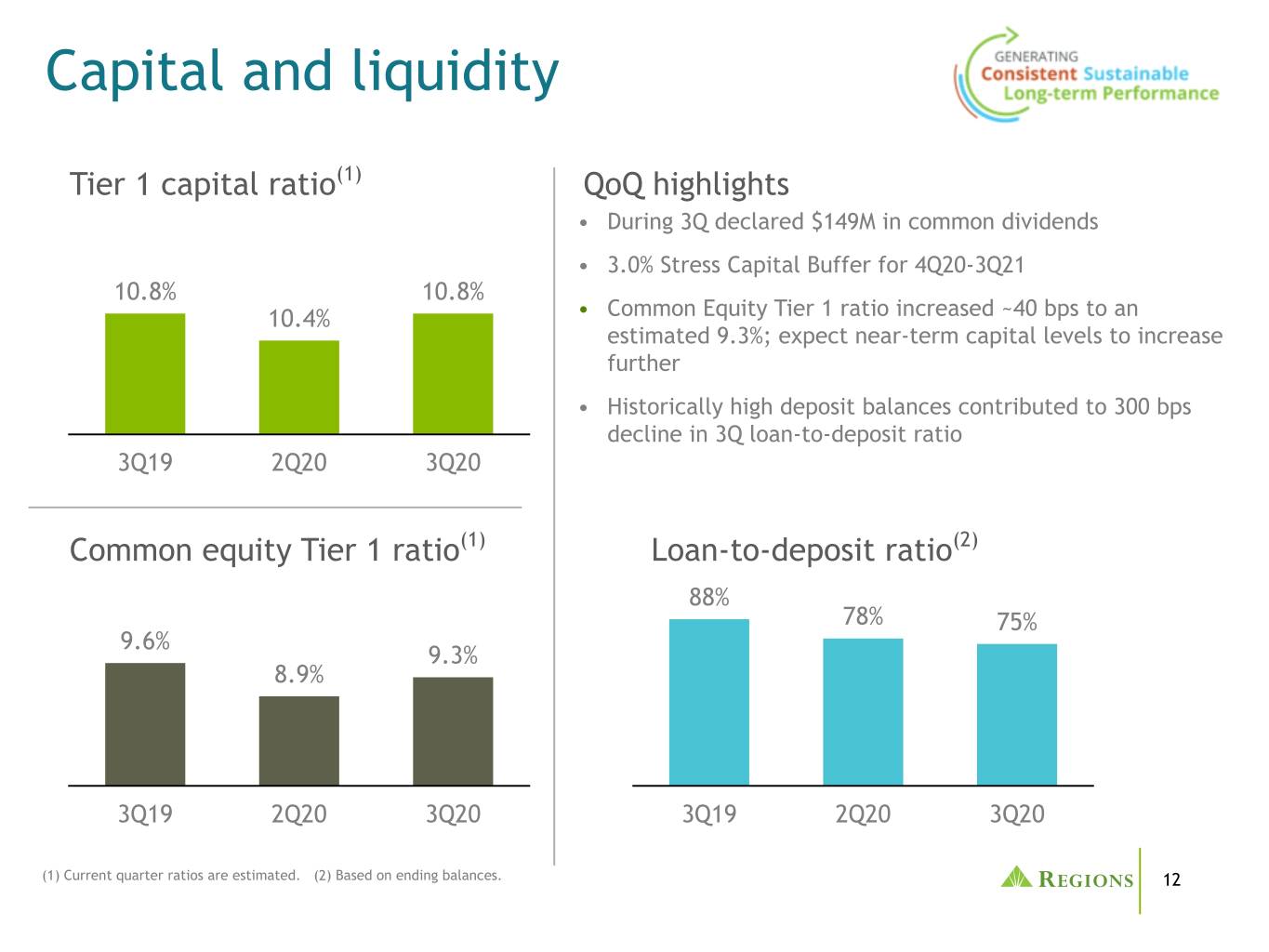
Capital and liquidity Tier 1 capital ratio(1) QoQ highlights • During 3Q declared $149M in common dividends • 3.0% Stress Capital Buffer for 4Q20-3Q21 10.8% 10.8% 10.4% • Common Equity Tier 1 ratio increased ~40 bps to an estimated 9.3%; expect near-term capital levels to increase further • Historically high deposit balances contributed to 300 bps decline in 3Q loan-to-deposit ratio 3Q19 2Q20 3Q20 Common equity Tier 1 ratio(1) Loan-to-deposit ratio(2) 88% 78% 75% 9.6% 9.3% 8.9% 3Q19 2Q20 3Q20 3Q19 2Q20 3Q20 (1) Current quarter ratios are estimated. (2) Based on ending balances. 12
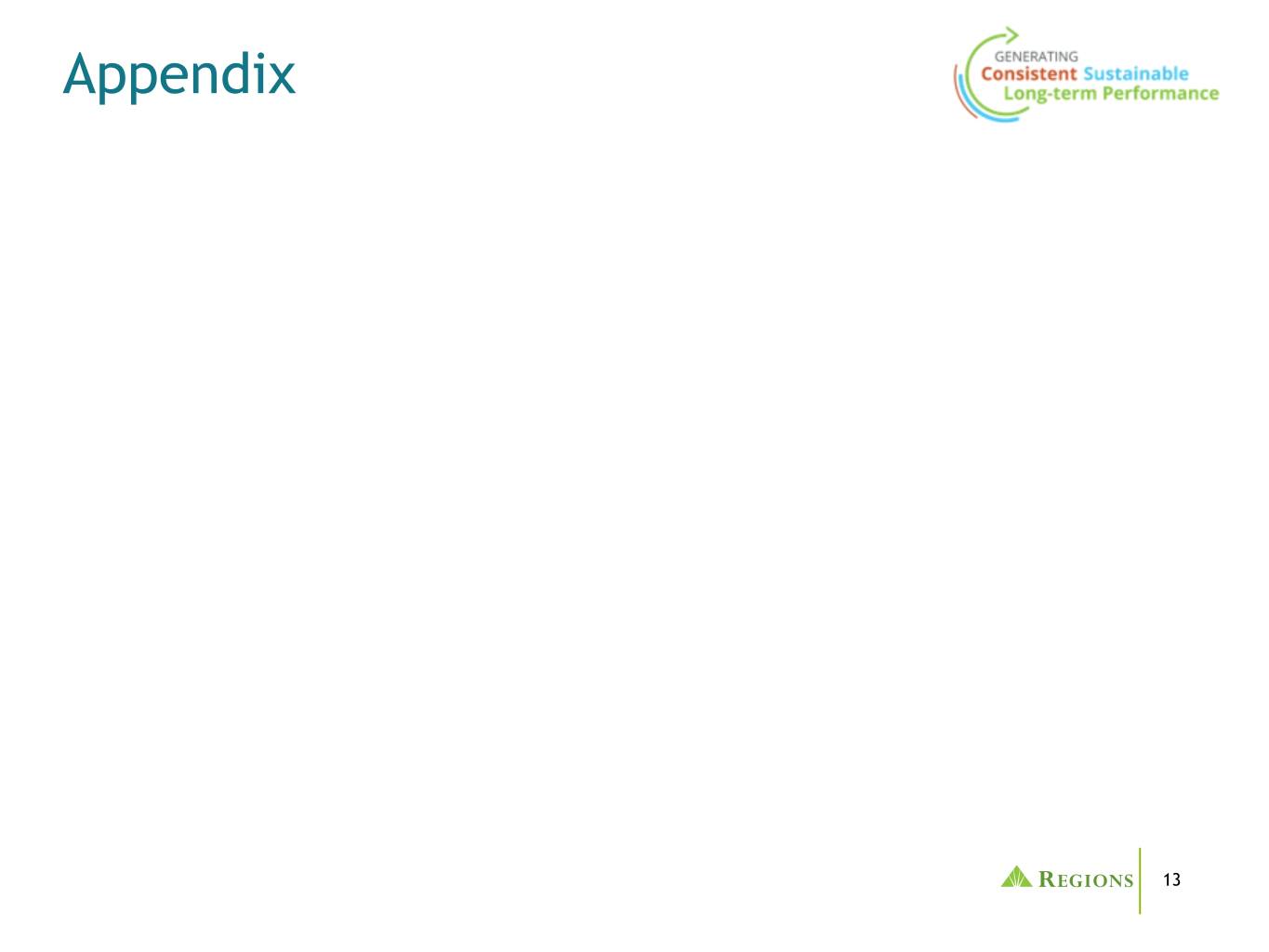
Appendix 13
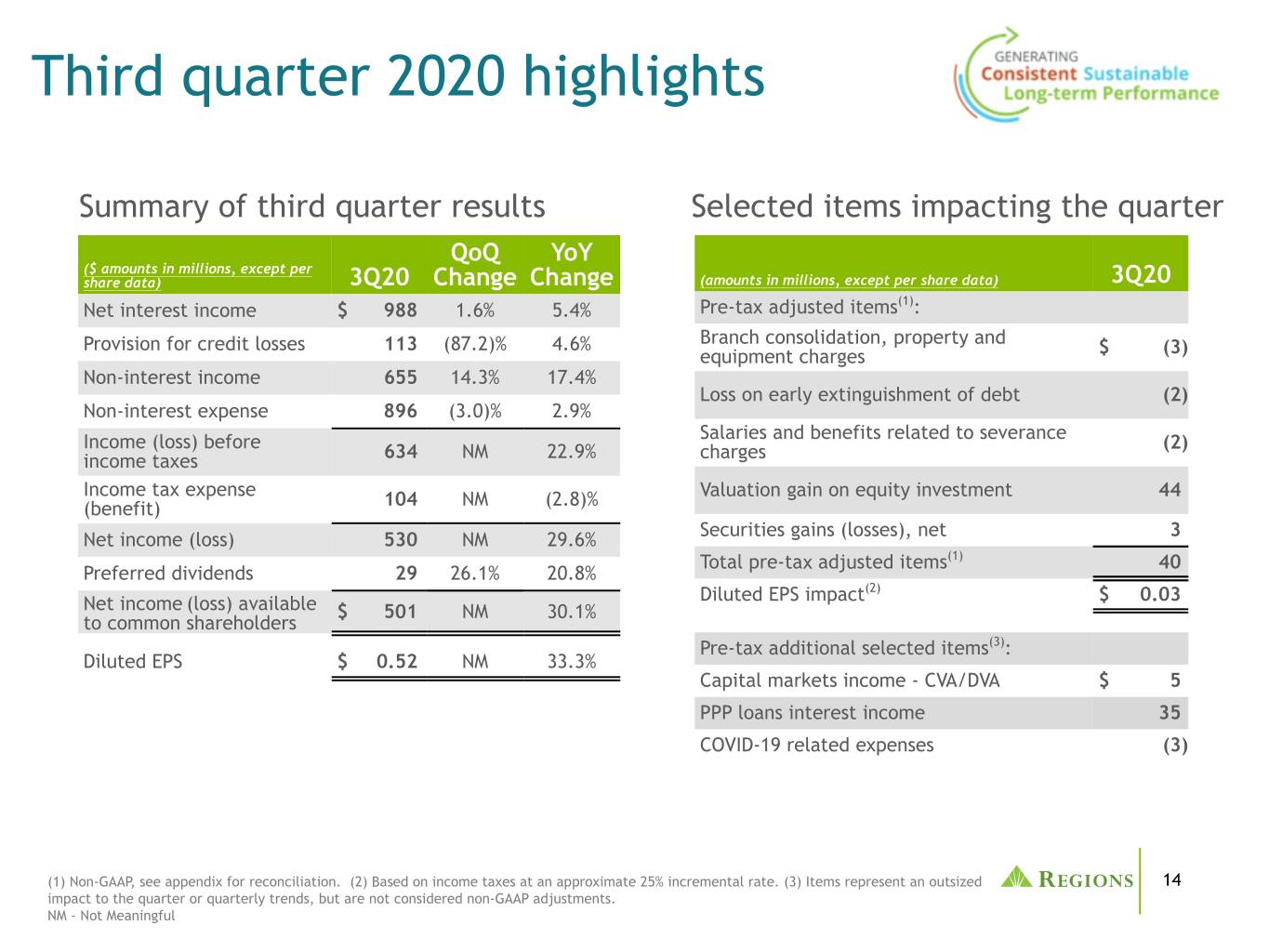
Third quarter 2020 highlights Summary of third quarter results Selected items impacting the quarter QoQ YoY ($ amounts in millions, except per share data) 3Q20 Change Change (amounts in millions, except per share data) 3Q20 (1) Net interest income $ 988 1.6% 5.4% Pre-tax adjusted items : Provision for credit losses 113 (87.2)% 4.6% Branch consolidation, property and equipment charges $ (3) Non-interest income 655 14.3% 17.4% Loss on early extinguishment of debt (2) Non-interest expense 896 (3.0)% 2.9% Salaries and benefits related to severance Income (loss) before (2) income taxes 634 NM 22.9% charges Income tax expense Valuation gain on equity investment 44 (benefit) 104 NM (2.8)% Securities gains (losses), net 3 Net income (loss) 530 NM 29.6% Total pre-tax adjusted items(1) 40 Preferred dividends 29 26.1% 20.8% (2) Diluted EPS impact $ 0.03 Net income (loss) available $ 501 NM 30.1% to common shareholders Pre-tax additional selected items(3): Diluted EPS $ 0.52 NM 33.3% Capital markets income - CVA/DVA $ 5 PPP loans interest income 35 COVID-19 related expenses (3) (1) Non-GAAP, see appendix for reconciliation. (2) Based on income taxes at an approximate 25% incremental rate. (3) Items represent an outsized 14 impact to the quarter or quarterly trends, but are not considered non-GAAP adjustments. NM - Not Meaningful
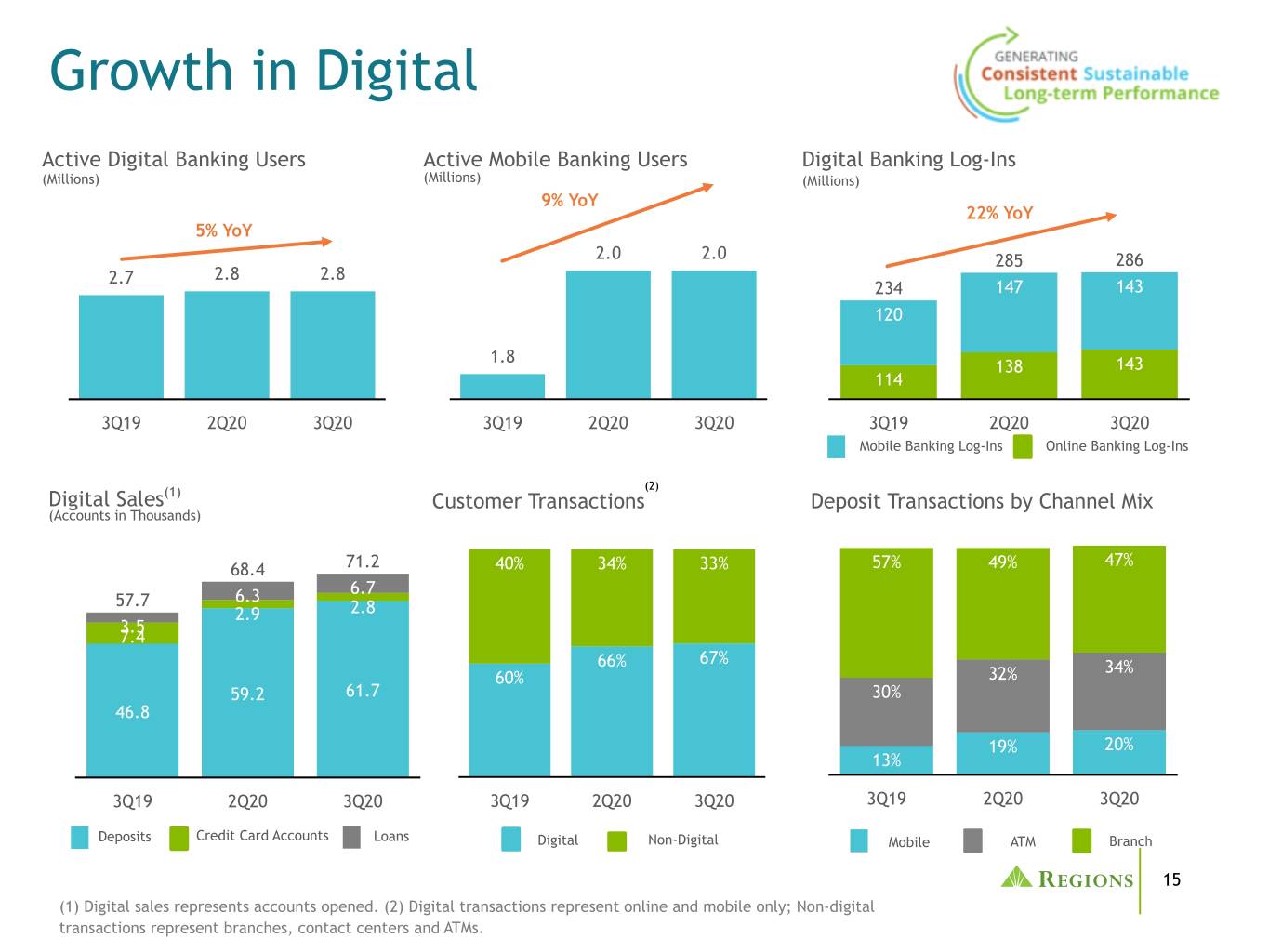
Growth in Digital Active Digital Banking Users Active Mobile Banking Users Digital Banking Log-Ins (Millions) (Millions) (Millions) 9% YoY 22% YoY 5% YoY 2.0 2.0 285 286 2.7 2.8 2.8 234 147 143 120 1.8 138 143 114 3Q19 2Q20 3Q20 3Q19 2Q20 3Q20 3Q19 2Q20 3Q20 Mobile Banking Log-Ins Online Banking Log-Ins (2) Digital Sales(1) Customer Transactions Deposit Transactions by Channel Mix (Accounts in Thousands) 47% 68.4 71.2 40% 34% 33% 57% 49% 6.7 57.7 6.3 2.9 2.8 3.5 7.4 67% 66% 34% 60% 32% 59.2 61.7 30% 46.8 19% 20% 13% 3Q19 2Q20 3Q20 3Q19 2Q20 3Q20 3Q19 2Q20 3Q20 Deposits Credit Card Accounts Loans Digital Non-Digital Mobile ATM Branch 15 (1) Digital sales represents accounts opened. (2) Digital transactions represent online and mobile only; Non-digital transactions represent branches, contact centers and ATMs.
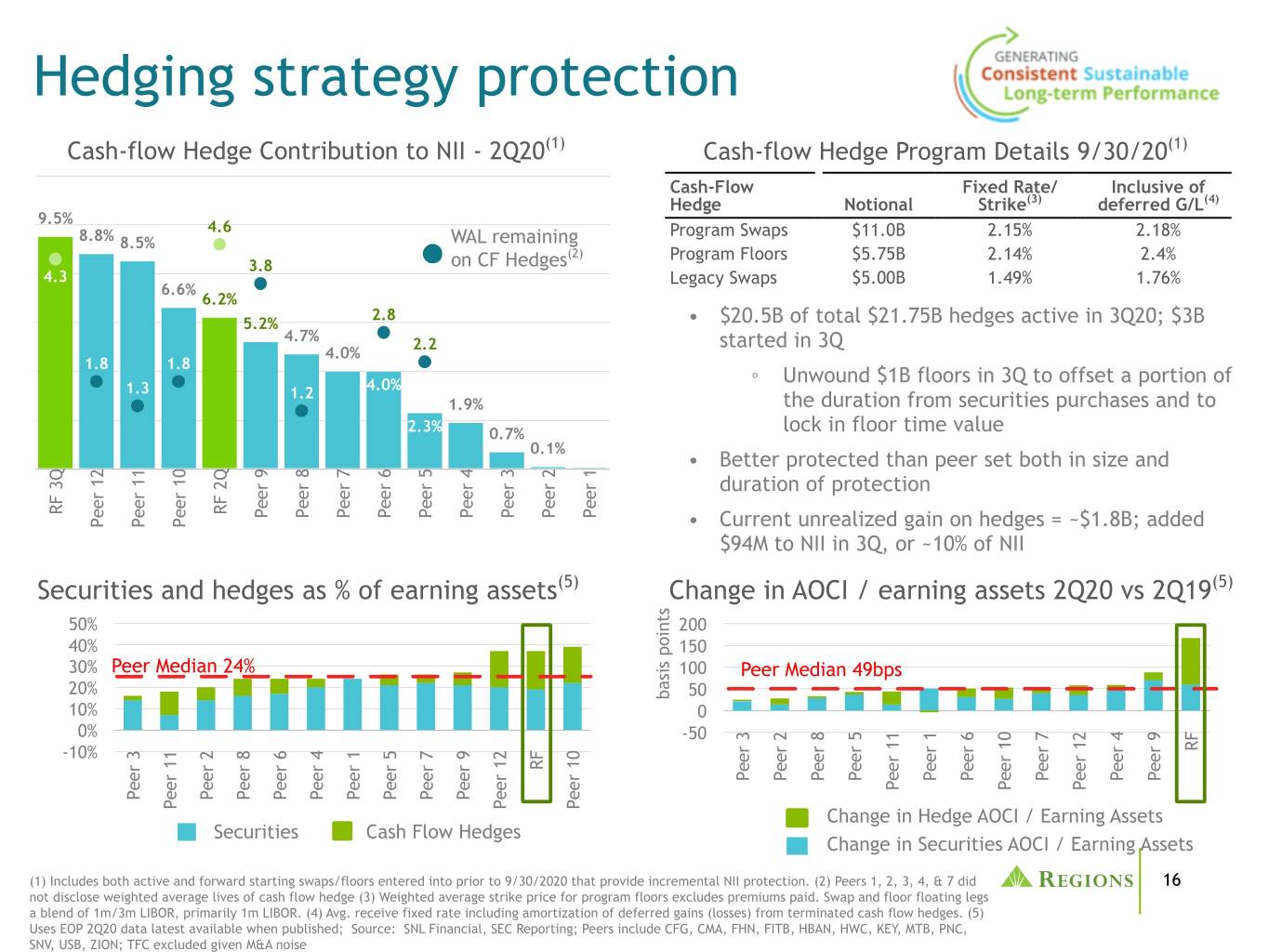
SNV, USB, ZION; TFC excluded given M&A noise Uses EOP 2Q20data latest available whenpublished; Source: SNL Financial, SECReporting; Peers include CFG,CMA, FHN, FITB,HBAN, HWC, KEY, MTB, PNC, a blendof 1m/3mLIBOR, primarily 1mLIBOR. (4) Avg. receive fixedrateincluding amortization ofdeferredgains (losses)from terminatedcash flowhedges.(5) not disclose weightedaverage livesofcash flowhedge(3)Weighted averagestrike priceforprogram floorsexcludes premiumspaid. Swapandfloorfloating legs (1) Includesboth active andforwardstartingswaps/floors enteredintopriorto9/30/2020 thatprovideincrementalNIIprotection. (2)Peers 1,2,3,4,&7 did Hedging strategyprotection Securities andhedgesas%ofearning assets 9 4 . . 5 3 - RF 3Q % Cash-flow HedgeContributiontoNII-2Q20 1 2 3 4 5 1 0 0 0 0 0 0 0 8 1 % % % % % % % . . 8 8 Peer 12 % Peer Median24% 8 1 . . 5 Peer 3 3 Peer 11 % 6 1 . . Peer 11 6 8 Peer 10 % 6 4 . Securities Peer 2 . 2 6 RF 2Q % 5 3 Peer 8 . . 2 8 Peer 9 % 4 Peer 6 1 . . 7 2 Peer 8 % Peer 4 4 . 0 Peer 7 % Peer 1 4 Cash FlowHedges 2 . . 0 8 Peer 5 Peer 6 % 2 2 . . 3 2 Peer 7 Peer 5 % 1 on CFHedges WAL remaining . 9 Peer 9 Peer 4 % 0 . Peer 12 7 Peer 3 % 0 . (1) RF 1 % (5) Peer 2 Peer 10 (2) Peer 1 Change in AOCI /earningassets2Q20 vs2Q19 basis points Legacy Swaps Program Floors Program Swaps Hedge Cash-Flow 1 1 2 - • • • 5 0 5 0 5 0 0 0 0 0 0 Cash-flow HedgeProgram Details9/30/20 $94M toNIIin3Q,or~10%of Current unrealizedgainonhedges=~$1.8B; added duration ofprotection Better protectedthanpeersetbothinsizeand started in3Q $20.5B oftotal$21.75Bhedgesactivein3Q20;$3B Peer Median49bps Peer 3 ◦ Peer 2 lock infloortimevalue the durationfromsecuritiespurchasesandto Unwound $1Bfloorsin3Qtooffsetaportionof Change inSecurities AOCI /Earning Assets Change inHedge AOCI /Earning Assets Peer 8 Notional Peer 5 $5.00B $5.75B $11.0B Peer 11 Peer 1 Peer 6 Fixed Rate/ Strike 1.49% 2.14% 2.15% Peer 10 (3) Peer 7 Peer 12 deferred G/L Peer 4 Inclusive of 1.76% 2.18% 2.4% 16 Peer 9 (1) RF (4) (5)
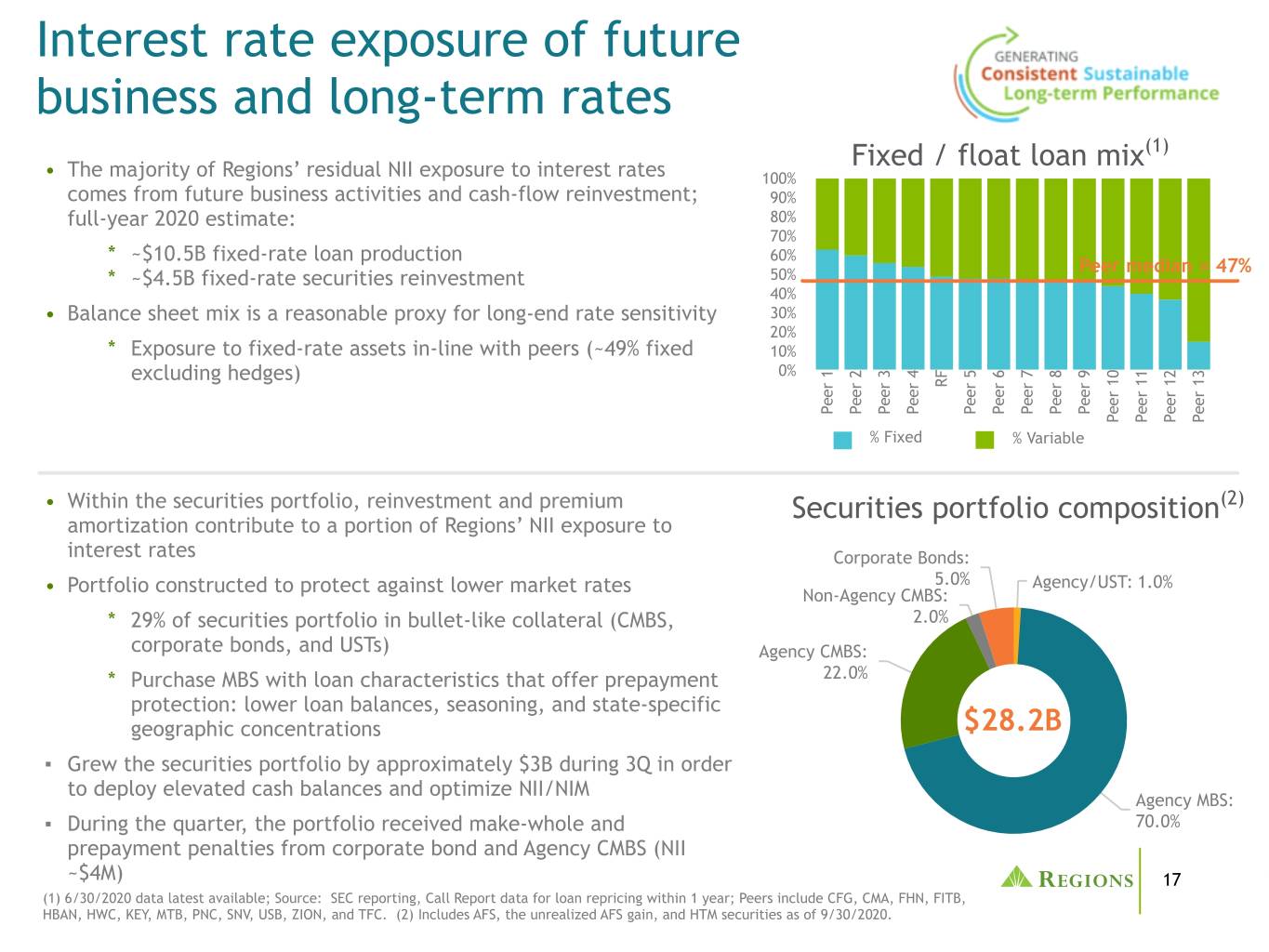
Interest rate exposure of future business and long-term rates Fixed / float loan mix(1) • The majority of Regions’ residual NII exposure to interest rates 100% comes from future business activities and cash-flow reinvestment; 90% full-year 2020 estimate: 80% 70% * ~$10.5B fixed-rate loan production 60% Peer median = 47% * ~$4.5B fixed-rate securities reinvestment 50% 40% • Balance sheet mix is a reasonable proxy for long-end rate sensitivity 30% 20% * Exposure to fixed-rate assets in-line with peers (~49% fixed 10% 0 1 2 3 1 2 3 4 5 6 7 8 9 excluding hedges) 0% F 1 1 1 1 R r r r r r r r r r r r r r e e e e e e e e e e e e e e e e e e e e e e e e e e P P P P P P P P P P P P P % Fixed % Variable • Within the securities portfolio, reinvestment and premium Securities portfolio composition(2) amortization contribute to a portion of Regions’ NII exposure to interest rates Corporate Bonds: 5.0% Agency/UST: 1.0% • Portfolio constructed to protect against lower market rates Non-Agency CMBS: * 29% of securities portfolio in bullet-like collateral (CMBS, 2.0% corporate bonds, and USTs) Agency CMBS: * Purchase MBS with loan characteristics that offer prepayment 22.0% protection: lower loan balances, seasoning, and state-specific geographic concentrations $28.2B ▪ Grew the securities portfolio by approximately $3B during 3Q in order to deploy elevated cash balances and optimize NII/NIM Agency MBS: ▪ During the quarter, the portfolio received make-whole and 70.0% prepayment penalties from corporate bond and Agency CMBS (NII ~$4M) 17 (1) 6/30/2020 data latest available; Source: SEC reporting, Call Report data for loan repricing within 1 year; Peers include CFG, CMA, FHN, FITB, HBAN, HWC, KEY, MTB, PNC, SNV, USB, ZION, and TFC. (2) Includes AFS, the unrealized AFS gain, and HTM securities as of 9/30/2020.
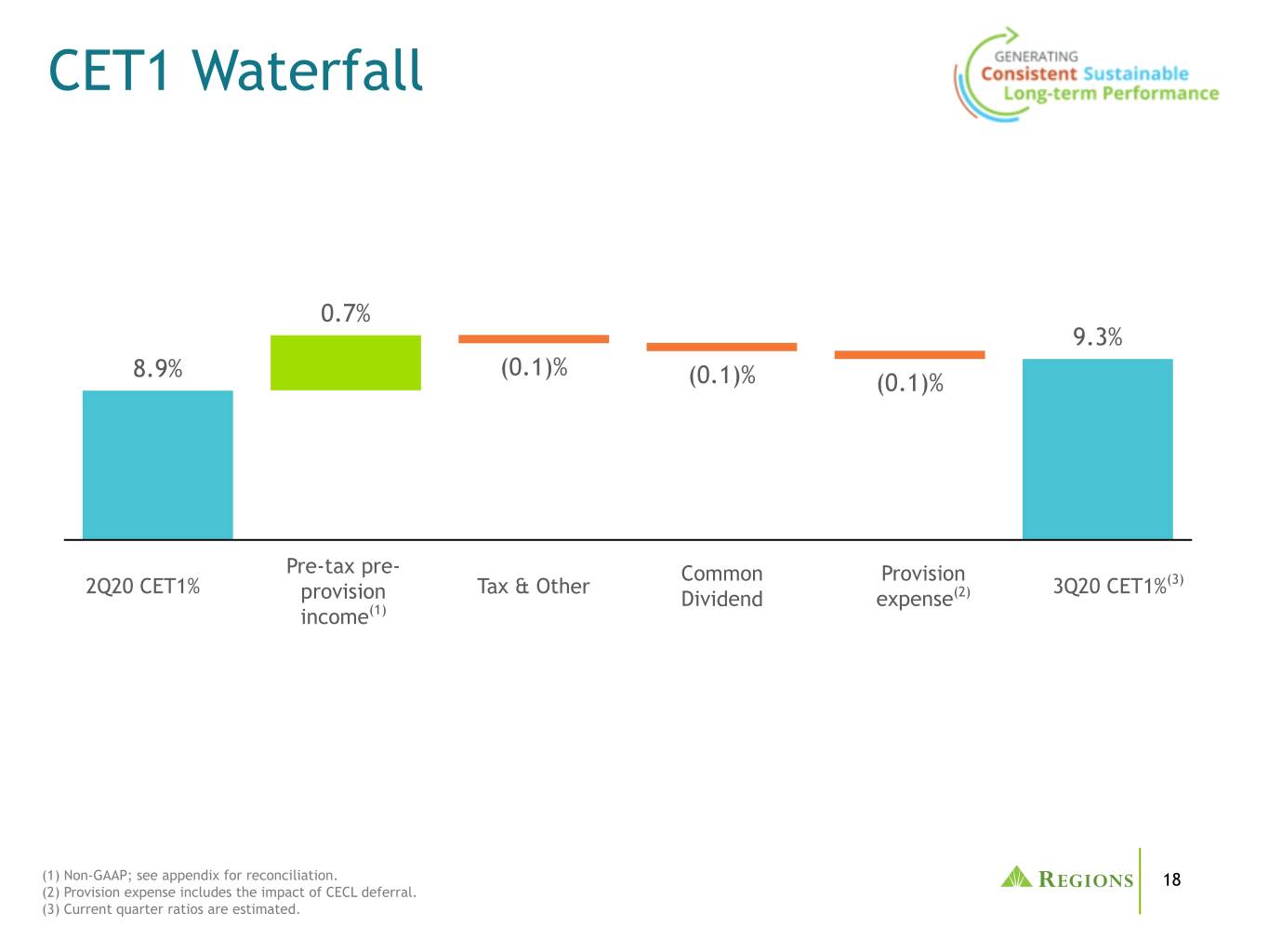
CET1 Waterfall 0.7% 9.3% 8.9% (0.1)% (0.1)% (0.1)% Pre-tax pre- Common Provision 2Q20 CET1% Tax & Other 3Q20 CET1%(3) provision Dividend expense(2) income(1) (1) Non-GAAP; see appendix for reconciliation. 18 (2) Provision expense includes the impact of CECL deferral. (3) Current quarter ratios are estimated.
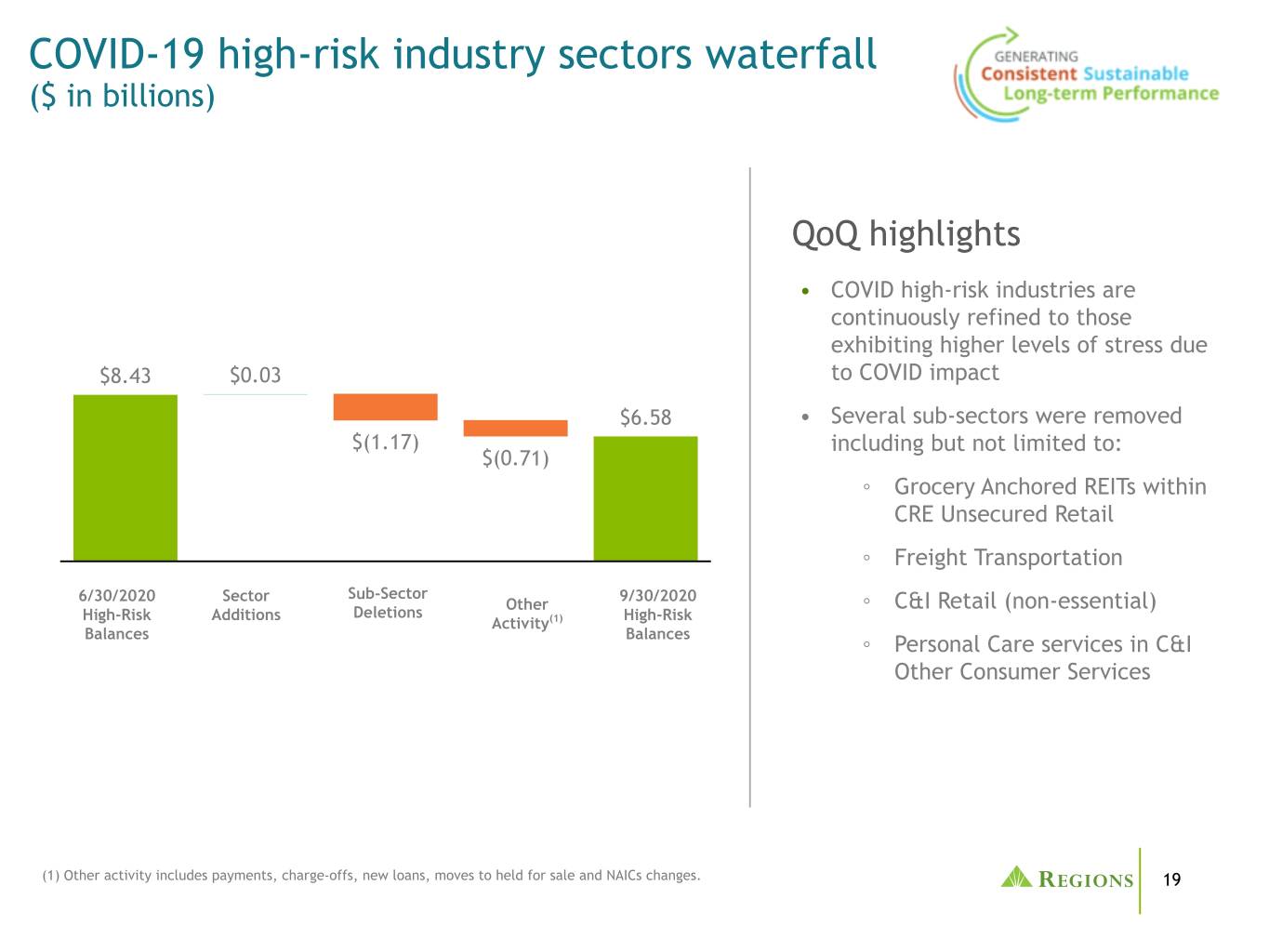
COVID-19 high-risk industry sectors waterfall ($ in billions) QoQ highlights • COVID high-risk industries are continuously refined to those exhibiting higher levels of stress due $8.43 $0.03 to COVID impact $6.58 • Several sub-sectors were removed $(1.17) including but not limited to: $(0.71) ◦ Grocery Anchored REITs within CRE Unsecured Retail ◦ Freight Transportation 6/30/2020 Sector Sub-Sector 9/30/2020 Other ◦ C&I Retail (non-essential) High-Risk Additions Deletions High-Risk Activity(1) Balances Balances ◦ Personal Care services in C&I Other Consumer Services (1) Other activity includes payments, charge-offs, new loans, moves to held for sale and NAICs changes. 19
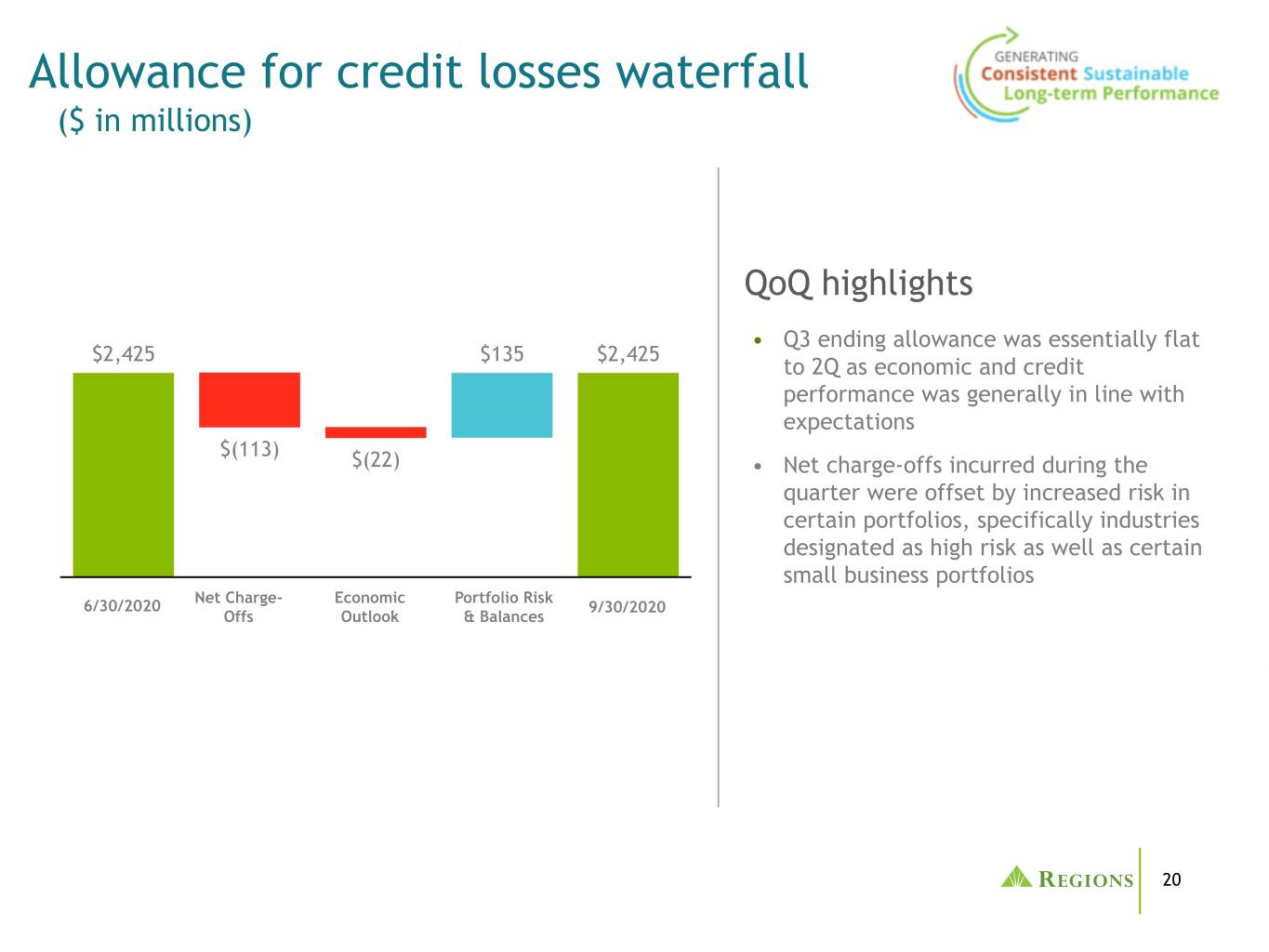
Allowance for credit losses waterfall ($ in millions) QoQ highlights • Q3 ending allowance was essentially flat $2,425 $135 $2,425 to 2Q as economic and credit performance was generally in line with expectations $(113) $(22) • Net charge-offs incurred during the quarter were offset by increased risk in certain portfolios, specifically industries designated as high risk as well as certain small business portfolios Net Charge- Economic Portfolio Risk 6/30/2020 9/30/2020 Offs Outlook & Balances 20
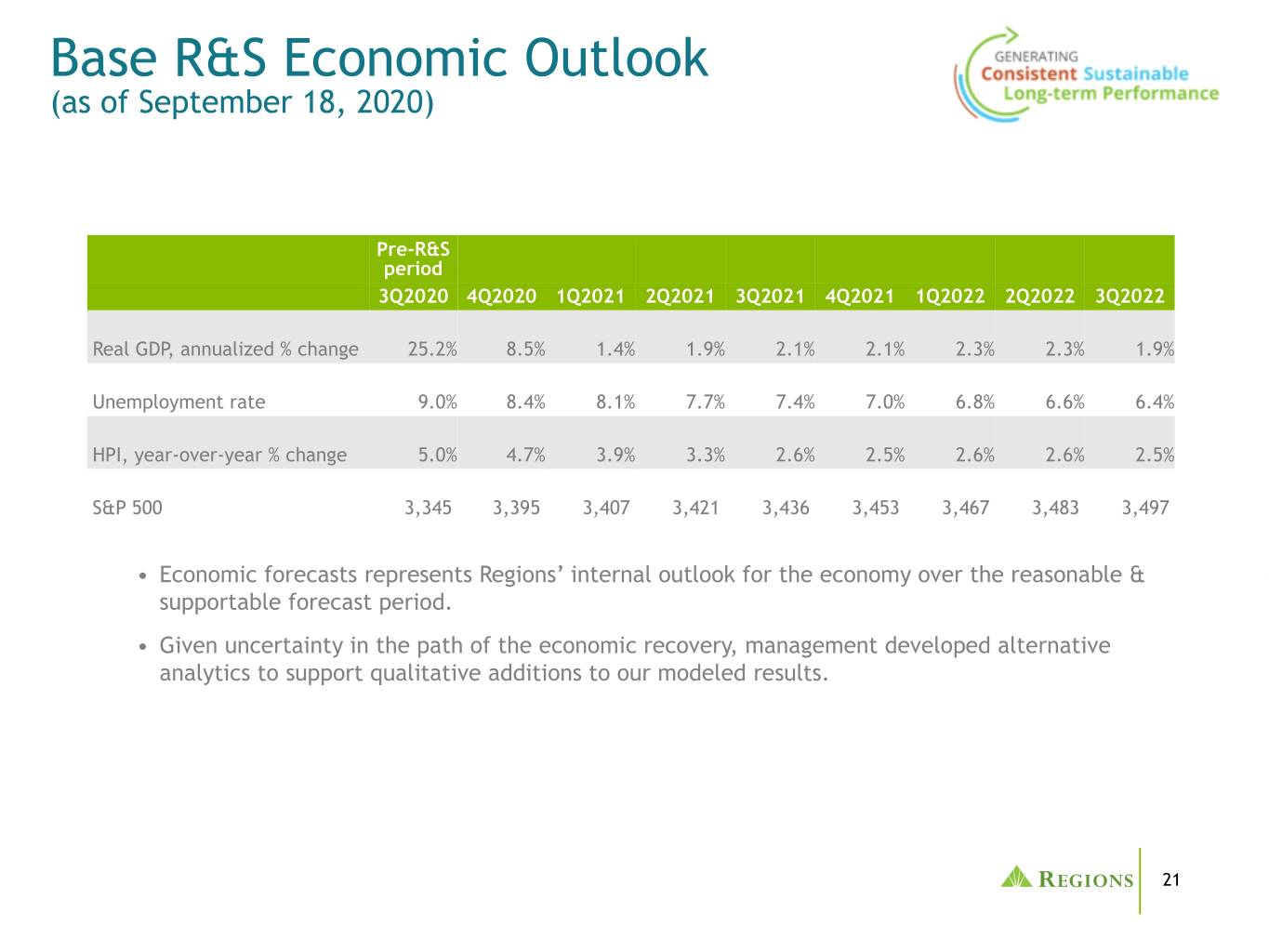
Base R&S Economic Outlook (as of September 18, 2020) Pre-R&S period 3Q2020 4Q2020 1Q2021 2Q2021 3Q2021 4Q2021 1Q2022 2Q2022 3Q2022 Real GDP, annualized % change 25.2% 8.5% 1.4% 1.9% 2.1% 2.1% 2.3% 2.3% 1.9% Unemployment rate 9.0% 8.4% 8.1% 7.7% 7.4% 7.0% 6.8% 6.6% 6.4% HPI, year-over-year % change 5.0% 4.7% 3.9% 3.3% 2.6% 2.5% 2.6% 2.6% 2.5% S&P 500 3,345 3,395 3,407 3,421 3,436 3,453 3,467 3,483 3,497 • Economic forecasts represents Regions’ internal outlook for the economy over the reasonable & supportable forecast period. • Given uncertainty in the path of the economic recovery, management developed alternative analytics to support qualitative additions to our modeled results. 21

Allowance Allocation As of 9/30/20 As of 6/30/20 (in millions) Loan Balance ACL ACL/Loans Loan Balance ACL ACL/Loans C&I $45,199 $1,119 2.48% $47,670 $1,109 2.33% CRE-OO Mortgage 5,451 247 4.53% 5,491 249 4.53% CRE-OO Construction 305 22 7.16% 314 20 6.25% Total Commercial $50,955 $1,388 2.72% $53,475 $1,378 2.58% IRE Mortgage 5,598 165 2.94% 5,221 132 2.53% IRE Construction 1,984 30 1.53% 1,908 55 2.89% Total IRE $7,582 $195 2.57% $7,129 $187 2.62% Residential First Mortgage 16,195 153 0.94% 15,382 151 0.98% Home Equity Lines 4,753 131 2.75% 4,953 146 2.95% Home Equity Loans 2,839 38 1.34% 2,937 42 1.43% Indirect- Vehicles 1,120 26 2.38% 1,331 34 2.58% Indirect- Other Consumer 2,663 258 9.70% 3,022 278 9.19% Consumer Credit Card 1,189 162 13.59% 1,213 143 11.74% Other Consumer 1,063 74 6.95% 1,106 66 5.97% Total Consumer $29,822 $842 2.82% $29,944 $860 2.87% Total $88,359 $2,425 2.74% $90,548 $2,425 2.68% Government Guaranteed PPP Loans 4,594 — — 4,498 — — Total, Excluding PPP Loans(1) $83,765 $2,425 2.90% $86,050 $2,425 2.82% (1) Non-GAAP; see appendix for reconciliation. 22 Note - All PPP loans are included in C&I. Excluding PPP loans from that category would increase the ACL ratio for C&I loans to 2.76%.
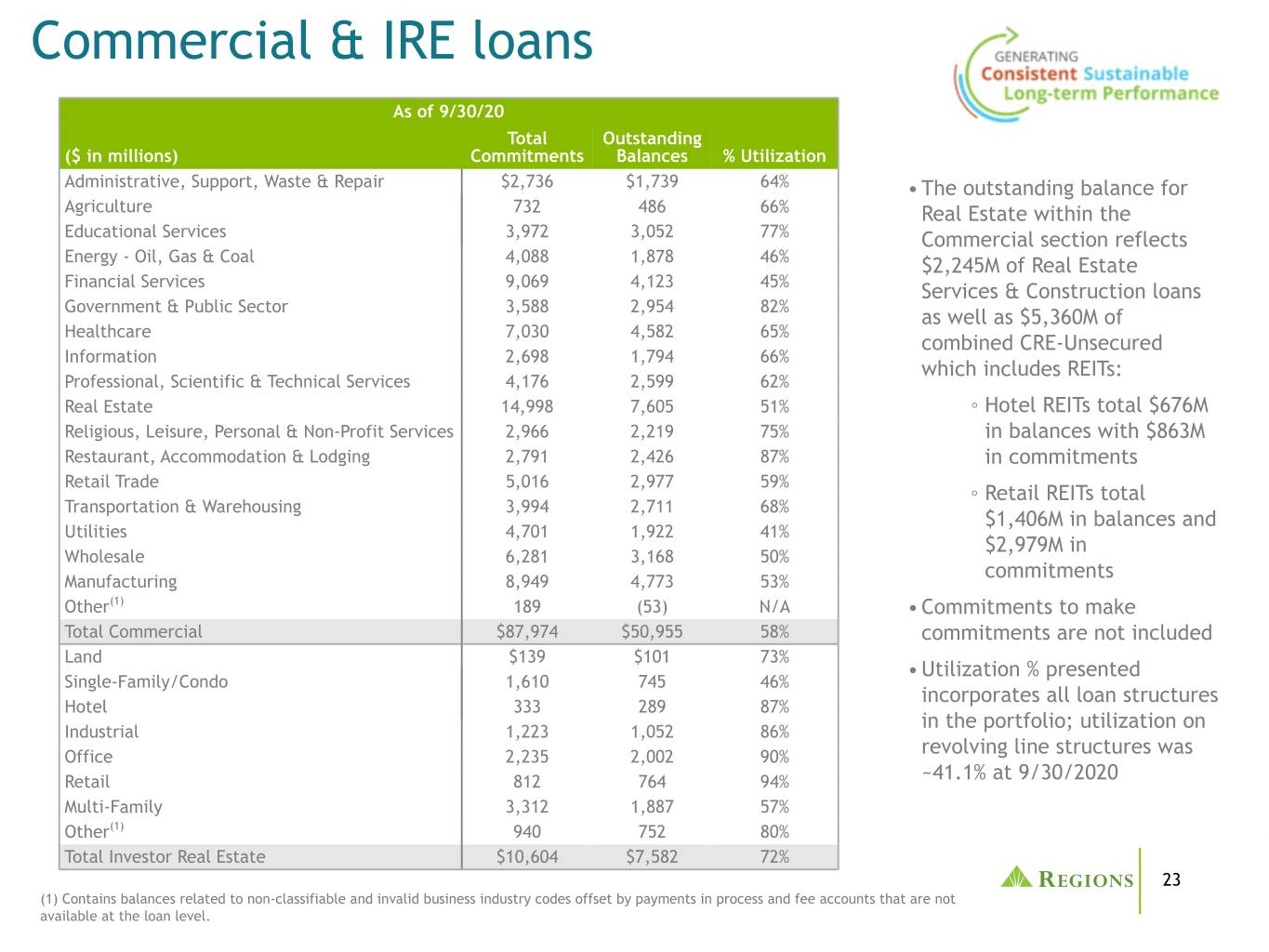
Commercial & IRE loans As of 9/30/20 Total Outstanding ($ in millions) Commitments Balances % Utilization Administrative, Support, Waste & Repair $2,736 $1,739 64% • The outstanding balance for Agriculture 732 486 66% Real Estate within the Educational Services 3,972 3,052 77% Commercial section reflects Energy - Oil, Gas & Coal 4,088 1,878 46% $2,245M of Real Estate Financial Services 9,069 4,123 45% Services & Construction loans Government & Public Sector 3,588 2,954 82% as well as $5,360M of Healthcare 7,030 4,582 65% combined CRE-Unsecured Information 2,698 1,794 66% which includes REITs: Professional, Scientific & Technical Services 4,176 2,599 62% Real Estate 14,998 7,605 51% ◦ Hotel REITs total $676M Religious, Leisure, Personal & Non-Profit Services 2,966 2,219 75% in balances with $863M Restaurant, Accommodation & Lodging 2,791 2,426 87% in commitments Retail Trade 5,016 2,977 59% ◦ Retail REITs total Transportation & Warehousing 3,994 2,711 68% $1,406M in balances and Utilities 4,701 1,922 41% $2,979M in Wholesale 6,281 3,168 50% commitments Manufacturing 8,949 4,773 53% Other(1) 189 (53) N/A • Commitments to make Total Commercial $87,974 $50,955 58% commitments are not included Land $139 $101 73% • Utilization % presented Single-Family/Condo 1,610 745 46% incorporates all loan structures Hotel 333 289 87% in the portfolio; utilization on Industrial 1,223 1,052 86% Office 2,235 2,002 90% revolving line structures was Retail 812 764 94% ~41.1% at 9/30/2020 Multi-Family 3,312 1,887 57% Other(1) 940 752 80% Total Investor Real Estate $10,604 $7,582 72% 23 (1) Contains balances related to non-classifiable and invalid business industry codes offset by payments in process and fee accounts that are not available at the loan level.
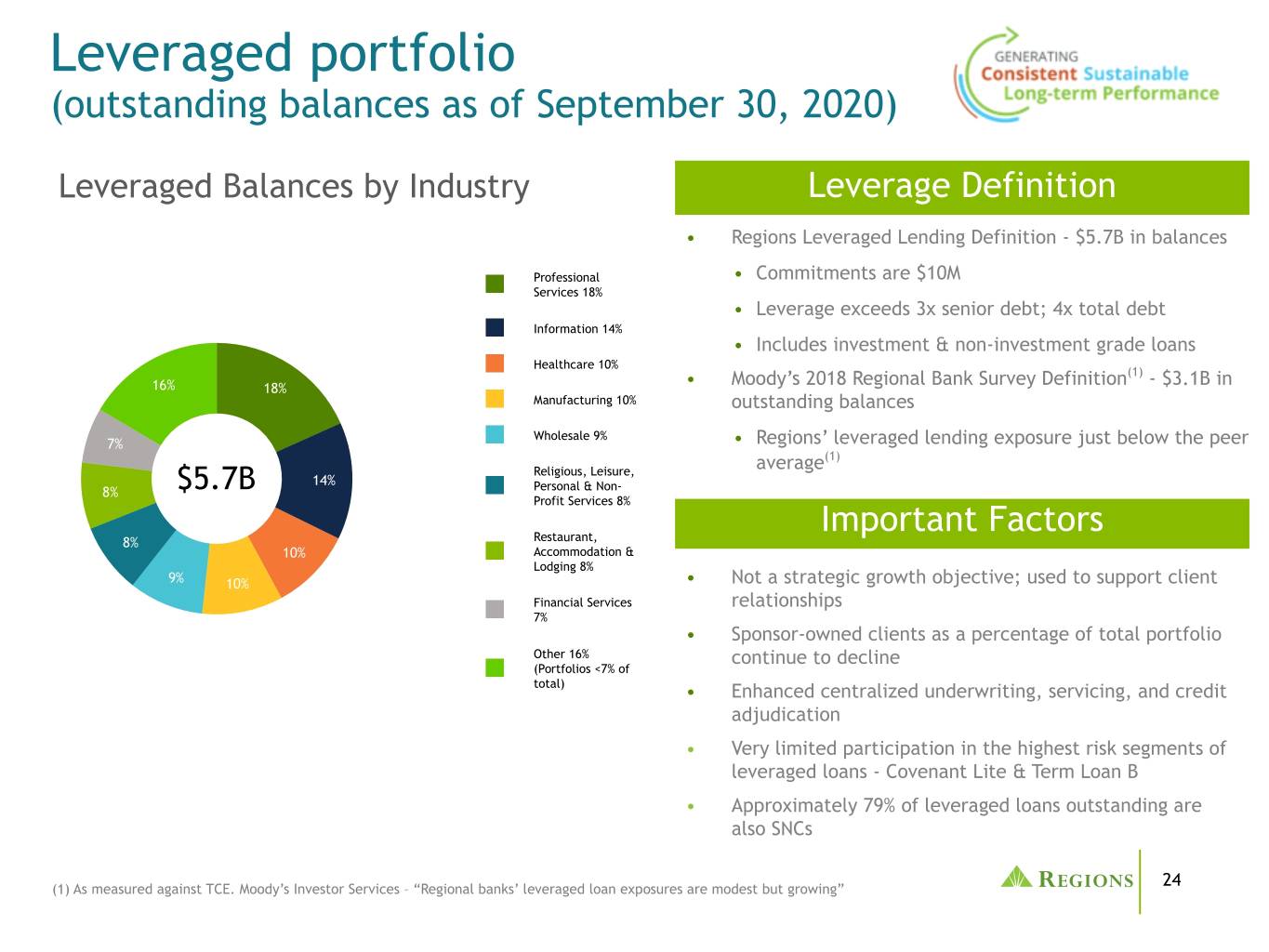
Leveraged portfolio (outstanding balances as of September 30, 2020) Leveraged Balances by Industry Leverage Definition • Regions Leveraged Lending Definition - $5.7B in balances Professional • Commitments are $10M Services 18% • Leverage exceeds 3x senior debt; 4x total debt Information 14% • Includes investment & non-investment grade loans Healthcare 10% • Moody’s 2018 Regional Bank Survey Definition(1) - $3.1B in 16% 18% Manufacturing 10% outstanding balances Wholesale 9% 7% • Regions’ leveraged lending exposure just below the peer (1) Religious, Leisure, average 14% 8% $5.7B Personal & Non- Profit Services 8% Important Factors 8% Restaurant, • 10% Accommodation & Lodging 8% 9% 10% • Not a strategic growth objective; used to support client Financial Services relationships 7% • Sponsor-owned clients as a percentage of total portfolio Other 16% continue to decline (Portfolios <7% of total) • Enhanced centralized underwriting, servicing, and credit adjudication • Very limited participation in the highest risk segments of leveraged loans - Covenant Lite & Term Loan B • Approximately 79% of leveraged loans outstanding are also SNCs 24 (1) As measured against TCE. Moody’s Investor Services – “Regional banks’ leveraged loan exposures are modest but growing”
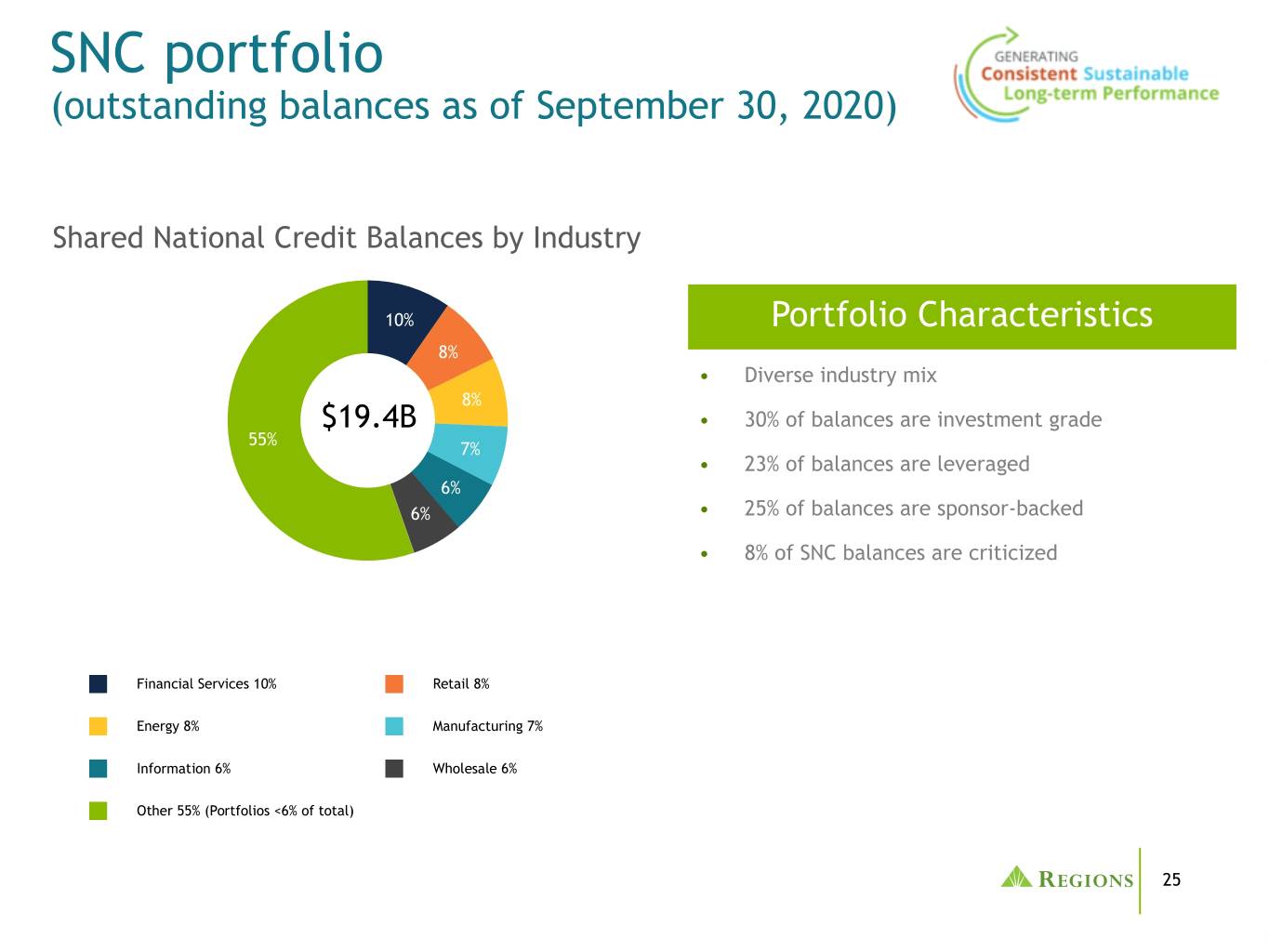
SNC portfolio (outstanding balances as of September 30, 2020) Shared National Credit Balances by Industry 10% • Portfolio Characteristics 8% • Diverse industry mix 8% $19.4B • 30% of balances are investment grade 55% 7% • 23% of balances are leveraged 6% 6% • 25% of balances are sponsor-backed • 8% of SNC balances are criticized Financial Services 10% Retail 8% Energy 8% Manufacturing 7% Information 6% Wholesale 6% Other 55% (Portfolios <6% of total) 25
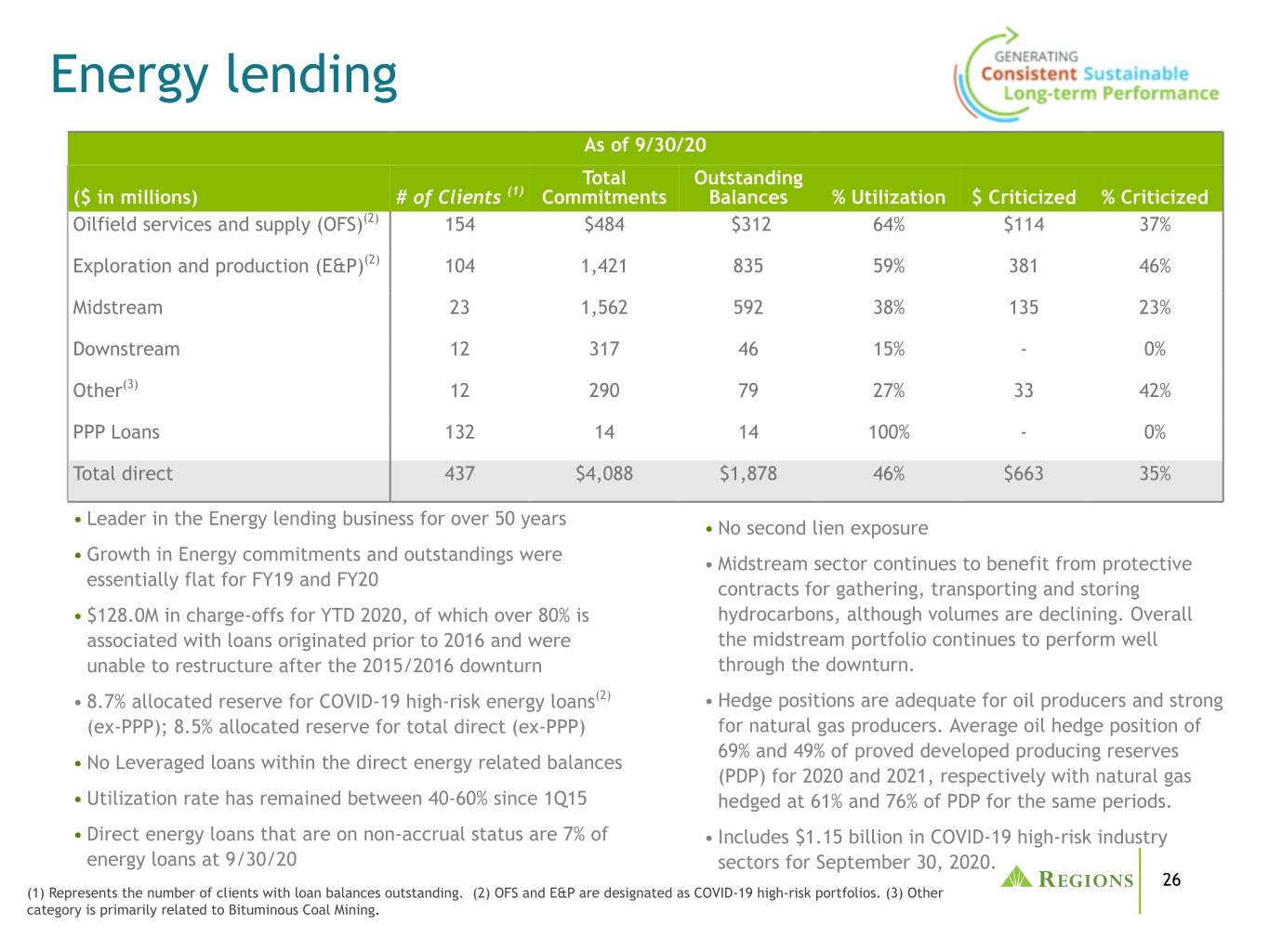
Energy lending As of 9/30/20 Total Outstanding ($ in millions) # of Clients (1) Commitments Balances % Utilization $ Criticized % Criticized Oilfield services and supply (OFS)(2) 154 $484 $312 64% $114 37% Exploration and production (E&P)(2) 104 1,421 835 59% 381 46% Midstream 23 1,562 592 38% 135 23% Downstream 12 317 46 15% - 0% Other(3) 12 290 79 27% 33 42% PPP Loans 132 14 14 100% - 0% Total direct 437 $4,088 $1,878 46% $663 35% • Leader in the Energy lending business for over 50 years • No second lien exposure • Growth in Energy commitments and outstandings were • Midstream sector continues to benefit from protective essentially flat for FY19 and FY20 contracts for gathering, transporting and storing • $128.0M in charge-offs for YTD 2020, of which over 80% is hydrocarbons, although volumes are declining. Overall associated with loans originated prior to 2016 and were the midstream portfolio continues to perform well unable to restructure after the 2015/2016 downturn through the downturn. • 8.7% allocated reserve for COVID-19 high-risk energy loans(2) • Hedge positions are adequate for oil producers and strong (ex-PPP); 8.5% allocated reserve for total direct (ex-PPP) for natural gas producers. Average oil hedge position of 69% and 49% of proved developed producing reserves • No Leveraged loans within the direct energy related balances (PDP) for 2020 and 2021, respectively with natural gas • Utilization rate has remained between 40-60% since 1Q15 hedged at 61% and 76% of PDP for the same periods. • Direct energy loans that are on non-accrual status are 7% of • Includes $1.15 billion in COVID-19 high-risk industry energy loans at 9/30/20 sectors for September 30, 2020. 26 (1) Represents the number of clients with loan balances outstanding. (2) OFS and E&P are designated as COVID-19 high-risk portfolios. (3) Other category is primarily related to Bituminous Coal Mining.
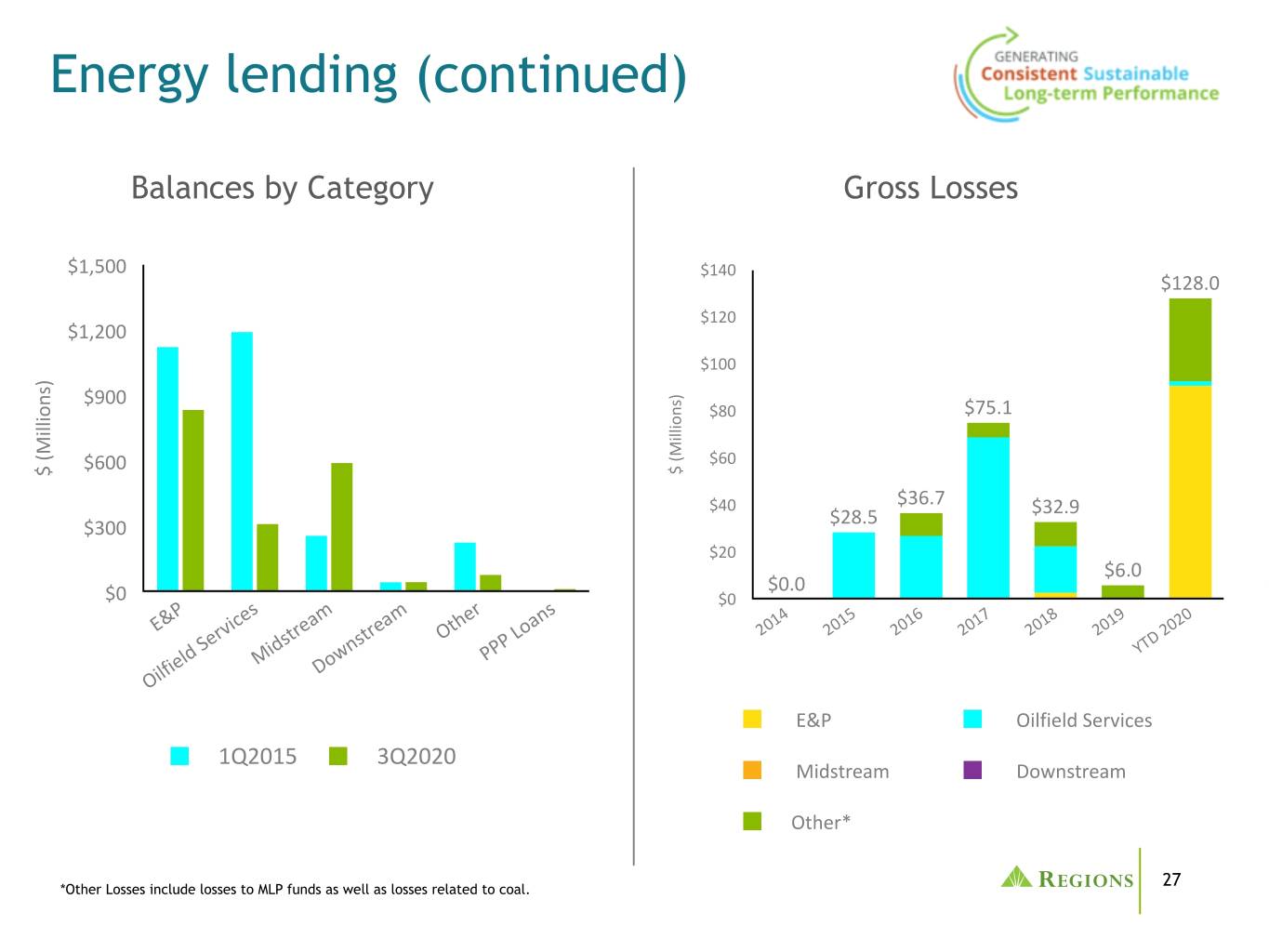
Energy lending (continued) Balances by Category Gross Losses $1,500 $140 $128.0 $120 $1,200 $100 ) s ) n $900 s n o $80 $75.1 i o l i l l i l i M M ( $600 ( $60 $ $ $40 $36.7 $28.5 $32.9 $300 $20 $6.0 $0.0 $0 $0 P es m m er ns 4 5 6 7 8 9 0 E& ic a a th a 01 01 01 01 01 01 02 rv tre tre O Lo 2 2 2 2 2 2 2 Se s s P TD d id wn P Y el M o P lfi D Oi E&P Oilfield Services 1Q2015 3Q2020 Midstream Downstream Other* 27 *Other Losses include losses to MLP funds as well as losses related to coal.
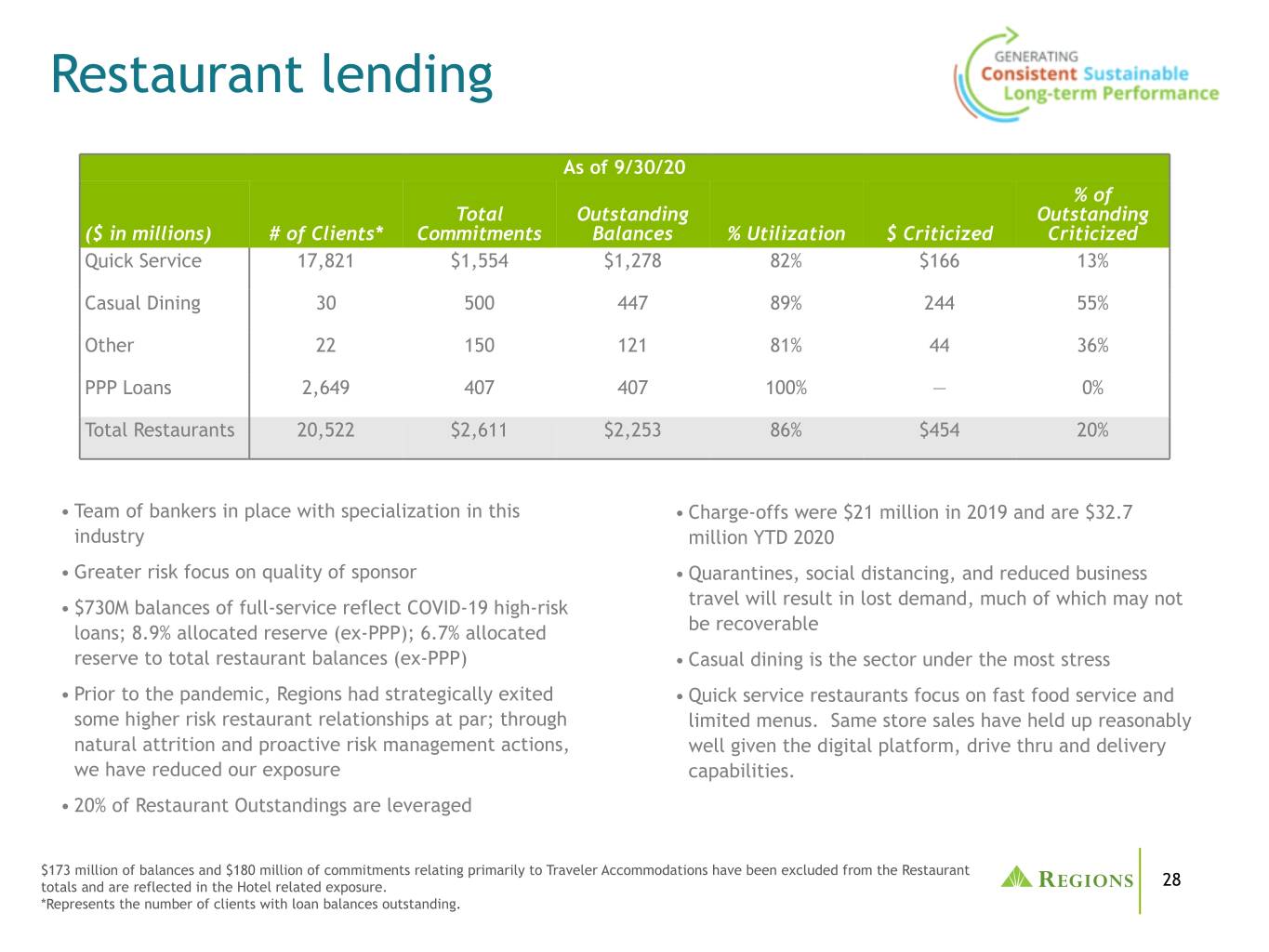
Restaurant lending As of 9/30/20 % of Total Outstanding Outstanding ($ in millions) # of Clients* Commitments Balances % Utilization $ Criticized Criticized Quick Service 17,821 $1,554 $1,278 82% $166 13% Casual Dining 30 500 447 89% 244 55% Other 22 150 121 81% 44 36% PPP Loans 2,649 407 407 100% — 0% Total Restaurants 20,522 $2,611 $2,253 86% $454 20% • Team of bankers in place with specialization in this • Charge-offs were $21 million in 2019 and are $32.7 industry million YTD 2020 • Greater risk focus on quality of sponsor • Quarantines, social distancing, and reduced business • $730M balances of full-service reflect COVID-19 high-risk travel will result in lost demand, much of which may not loans; 8.9% allocated reserve (ex-PPP); 6.7% allocated be recoverable reserve to total restaurant balances (ex-PPP) • Casual dining is the sector under the most stress • Prior to the pandemic, Regions had strategically exited • Quick service restaurants focus on fast food service and some higher risk restaurant relationships at par; through limited menus. Same store sales have held up reasonably natural attrition and proactive risk management actions, well given the digital platform, drive thru and delivery we have reduced our exposure capabilities. • 20% of Restaurant Outstandings are leveraged $173 million of balances and $180 million of commitments relating primarily to Traveler Accommodations have been excluded from the Restaurant totals and are reflected in the Hotel related exposure. 28 *Represents the number of clients with loan balances outstanding.
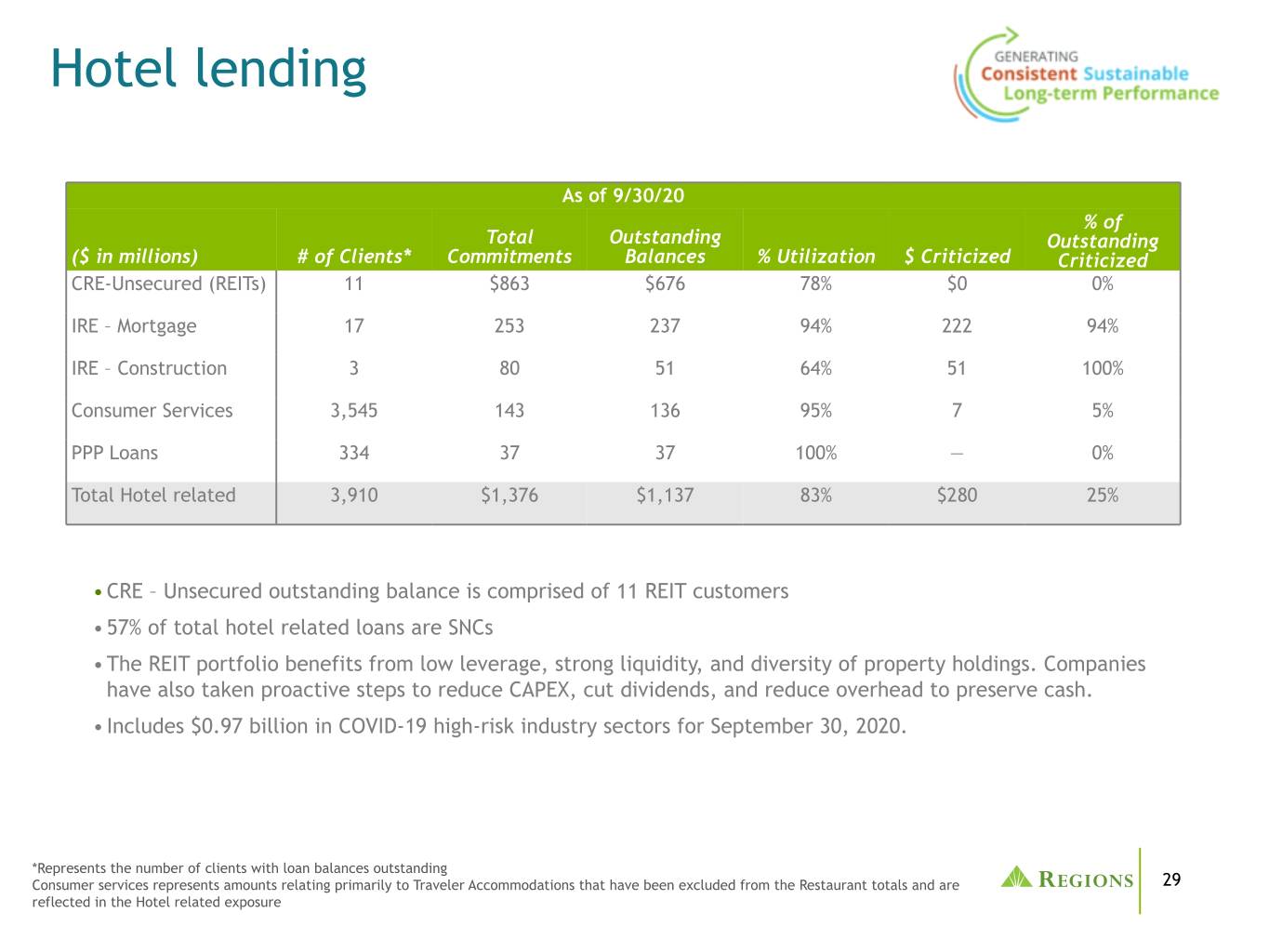
Hotel lending As of 9/30/20 % of Total Outstanding Outstanding ($ in millions) # of Clients* Commitments Balances % Utilization $ Criticized Criticized CRE-Unsecured (REITs) 11 $863 $676 78% $0 0% IRE – Mortgage 17 253 237 94% 222 94% IRE – Construction 3 80 51 64% 51 100% Consumer Services 3,545 143 136 95% 7 5% PPP Loans 334 37 37 100% — 0% Total Hotel related 3,910 $1,376 $1,137 83% $280 25% • CRE – Unsecured outstanding balance is comprised of 11 REIT customers • 57% of total hotel related loans are SNCs • The REIT portfolio benefits from low leverage, strong liquidity, and diversity of property holdings. Companies have also taken proactive steps to reduce CAPEX, cut dividends, and reduce overhead to preserve cash. • Includes $0.97 billion in COVID-19 high-risk industry sectors for September 30, 2020. *Represents the number of clients with loan balances outstanding Consumer services represents amounts relating primarily to Traveler Accommodations that have been excluded from the Restaurant totals and are 29 reflected in the Hotel related exposure
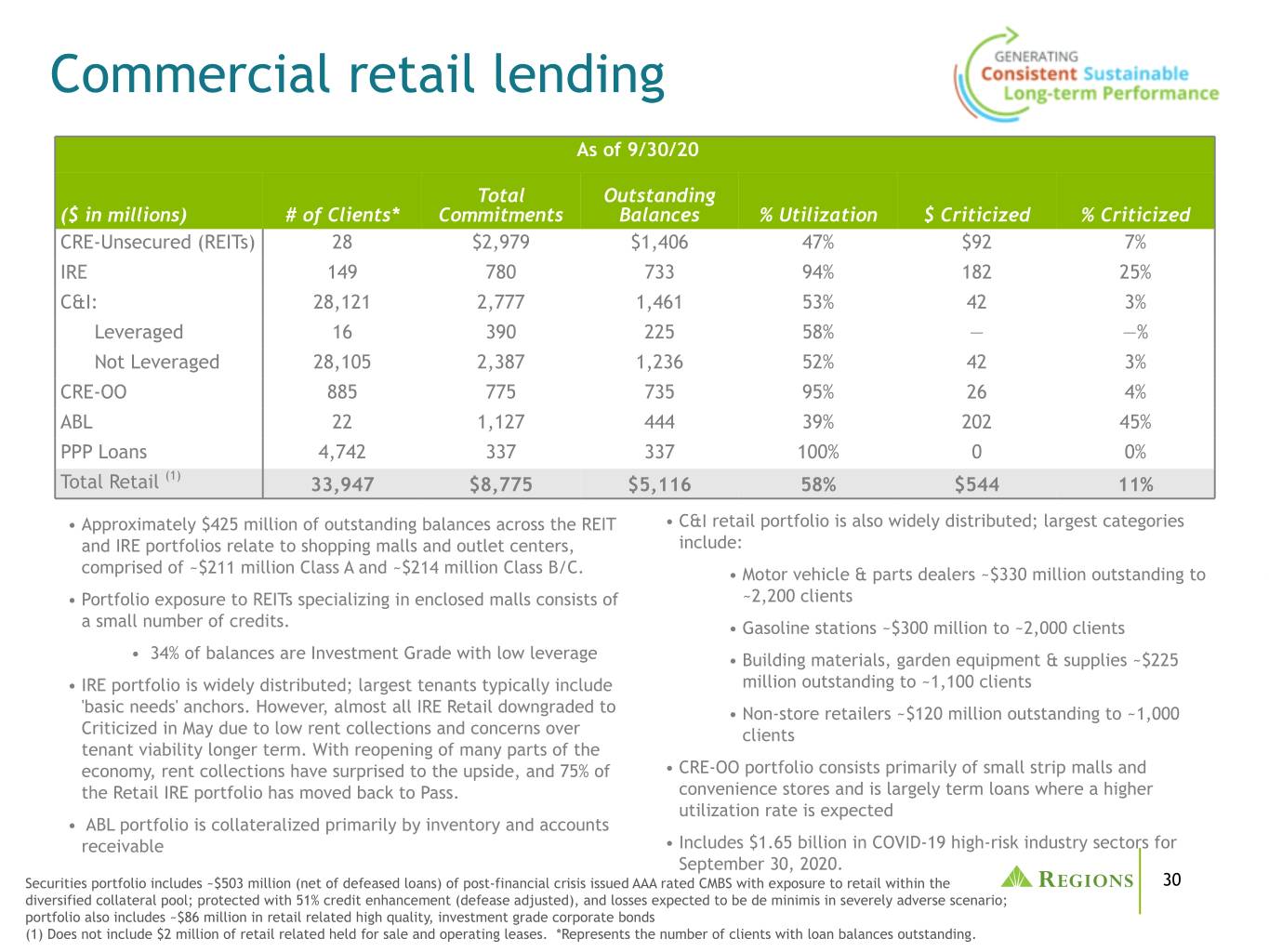
Commercial retail lending As of 9/30/20 Total Outstanding ($ in millions) # of Clients* Commitments Balances % Utilization $ Criticized % Criticized CRE-Unsecured (REITs) 28 $2,979 $1,406 47% $92 7% IRE 149 780 733 94% 182 25% C&I: 28,121 2,777 1,461 53% 42 3% Leveraged 16 390 225 58% — —% Not Leveraged 28,105 2,387 1,236 52% 42 3% CRE-OO 885 775 735 95% 26 4% ABL 22 1,127 444 39% 202 45% PPP Loans 4,742 337 337 100% 0 0% Total Retail (1) 33,947 $8,775 $5,116 58% $544 11% • Approximately $425 million of outstanding balances across the REIT • C&I retail portfolio is also widely distributed; largest categories and IRE portfolios relate to shopping malls and outlet centers, include: comprised of ~$211 million Class A and ~$214 million Class B/C. • Motor vehicle & parts dealers ~$330 million outstanding to • Portfolio exposure to REITs specializing in enclosed malls consists of ~2,200 clients a small number of credits. • Gasoline stations ~$300 million to ~2,000 clients • 34% of balances are Investment Grade with low leverage • Building materials, garden equipment & supplies ~$225 • IRE portfolio is widely distributed; largest tenants typically include million outstanding to ~1,100 clients 'basic needs' anchors. However, almost all IRE Retail downgraded to • Non-store retailers ~$120 million outstanding to ~1,000 Criticized in May due to low rent collections and concerns over clients tenant viability longer term. With reopening of many parts of the economy, rent collections have surprised to the upside, and 75% of • CRE-OO portfolio consists primarily of small strip malls and the Retail IRE portfolio has moved back to Pass. convenience stores and is largely term loans where a higher utilization rate is expected • ABL portfolio is collateralized primarily by inventory and accounts receivable • Includes $1.65 billion in COVID-19 high-risk industry sectors for September 30, 2020. Securities portfolio includes ~$503 million (net of defeased loans) of post-financial crisis issued AAA rated CMBS with exposure to retail within the 30 diversified collateral pool; protected with 51% credit enhancement (defease adjusted), and losses expected to be de minimis in severely adverse scenario; portfolio also includes ~$86 million in retail related high quality, investment grade corporate bonds (1) Does not include $2 million of retail related held for sale and operating leases. *Represents the number of clients with loan balances outstanding.
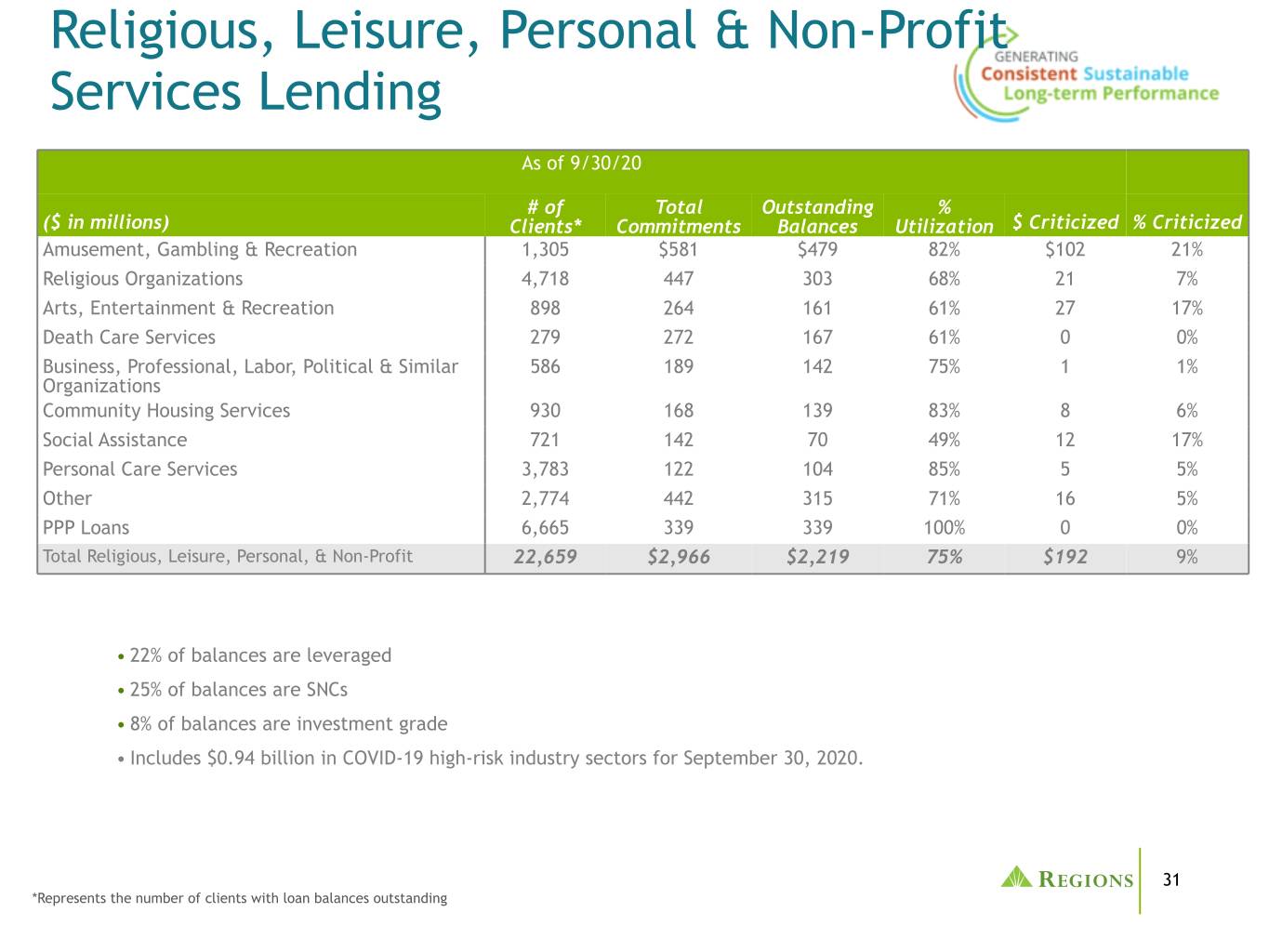
Religious, Leisure, Personal & Non-Profit Services Lending As of 9/30/20 # of Total Outstanding % ($ in millions) Clients* Commitments Balances Utilization $ Criticized % Criticized Amusement, Gambling & Recreation 1,305 $581 $479 82% $102 21% Religious Organizations 4,718 447 303 68% 21 7% Arts, Entertainment & Recreation 898 264 161 61% 27 17% Death Care Services 279 272 167 61% 0 0% Business, Professional, Labor, Political & Similar53 586 189 142 75% 1 1% Organizations Community Housing Services 930 168 139 83% 8 6% Social Assistance 721 142 70 49% 12 17% Personal Care Services 3,783 122 104 85% 5 5% Other 2,774 442 315 71% 16 5% PPP Loans 6,665 339 339 100% 0 0% Total Religious, Leisure, Personal, & Non-Profit 22,659 $2,966 $2,219 75% $192 9% • 22% of balances are leveraged • 25% of balances are SNCs • 8% of balances are investment grade • Includes $0.94 billion in COVID-19 high-risk industry sectors for September 30, 2020. 31 *Represents the number of clients with loan balances outstanding
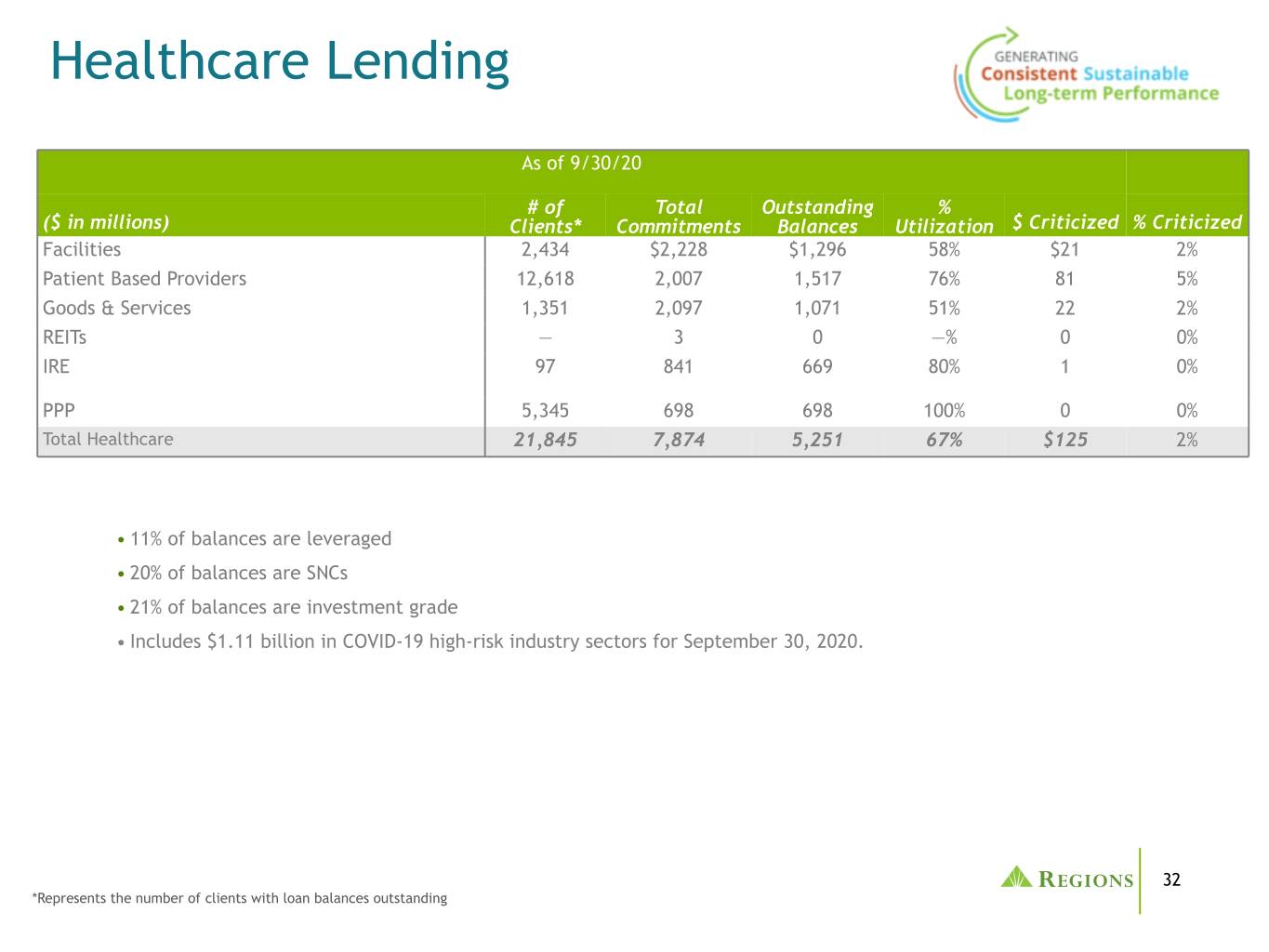
Healthcare Lending As of 9/30/20 # of Total Outstanding % ($ in millions) Clients* Commitments Balances Utilization $ Criticized % Criticized Facilities 2,434 $2,228 $1,296 58% $21 2% Patient Based Providers 12,618 2,007 1,517 76% 81 5% Goods & Services 1,351 2,097 1,071 51% 22 2% REITs — 3 0 —% 0 0% IRE 97 841 669 80% 1 0% PPP 5,345 698 698 100% 0 0% Total Healthcare 21,845 7,874 5,251 67% $125 2% • 11% of balances are leveraged • 20% of balances are SNCs • 21% of balances are investment grade • Includes $1.11 billion in COVID-19 high-risk industry sectors for September 30, 2020. 32 *Represents the number of clients with loan balances outstanding
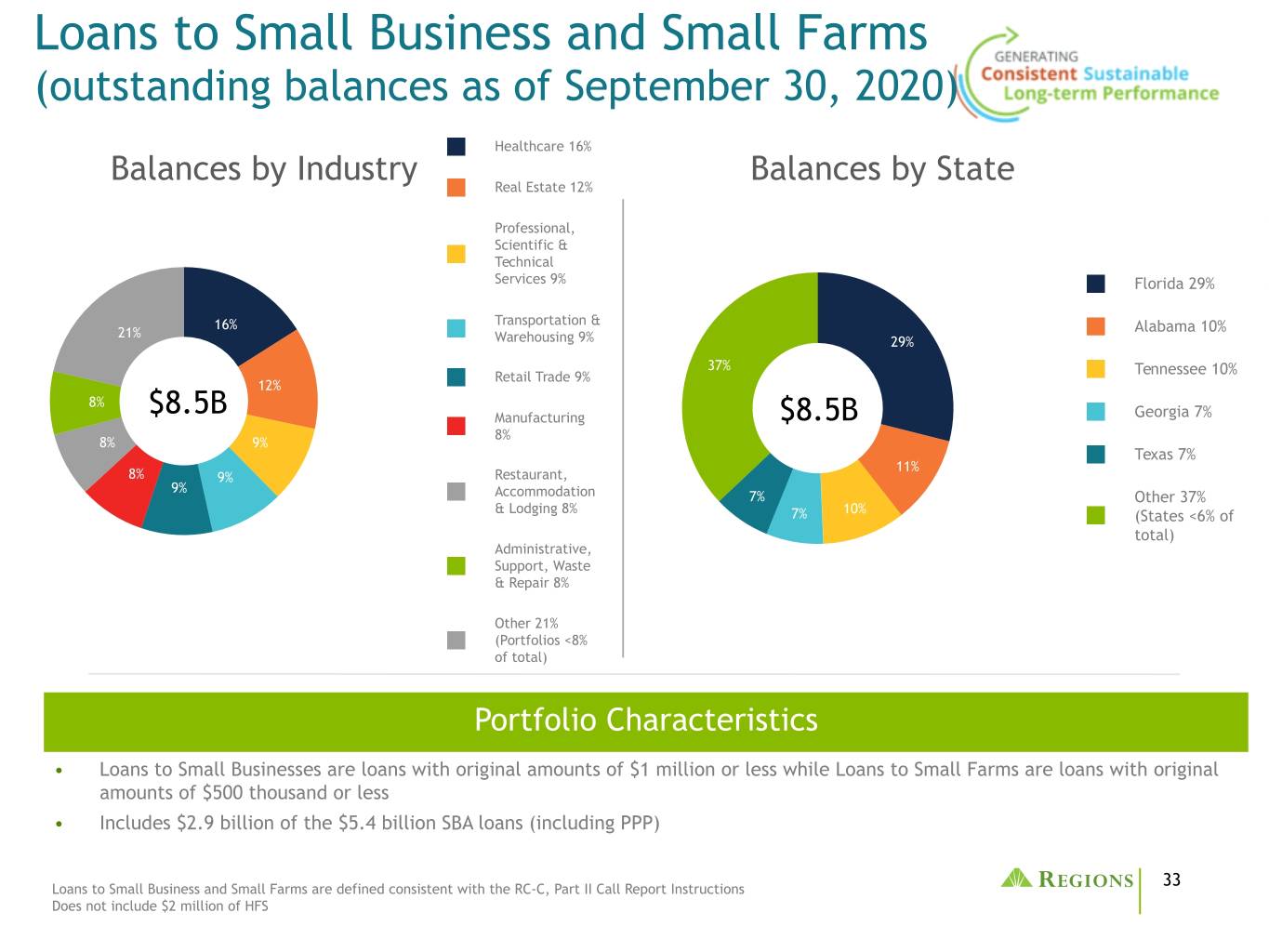
Loans to Small Business and Small Farms (outstanding balances as of September 30, 2020) Healthcare 16% Balances by Industry Balances by State Real Estate 12% Professional, Scientific & Technical Services 9% Florida 29% 16% Transportation & 21% Alabama 10% Warehousing 9% 29% 37% Retail Trade 9% Tennessee 10% 12% 8% $8.5B Manufacturing $8.5B Georgia 7% 8% 8% 9% Texas 7% 11% 8% 9% Restaurant, 9% Accommodation 7% Other 37% & Lodging 8% 7% 10% (States <6% of total) Administrative, Support, Waste & Repair 8% Other 21% (Portfolios <8% of total) Portfolio Characteristics • Loans to Small Businesses are loans with original amounts of $1 million or less while Loans to Small Farms are loans with original amounts of $500 thousand or less • Includes $2.9 billion of the $5.4 billion SBA loans (including PPP) 33 Loans to Small Business and Small Farms are defined consistent with the RC-C, Part II Call Report Instructions Does not include $2 million of HFS
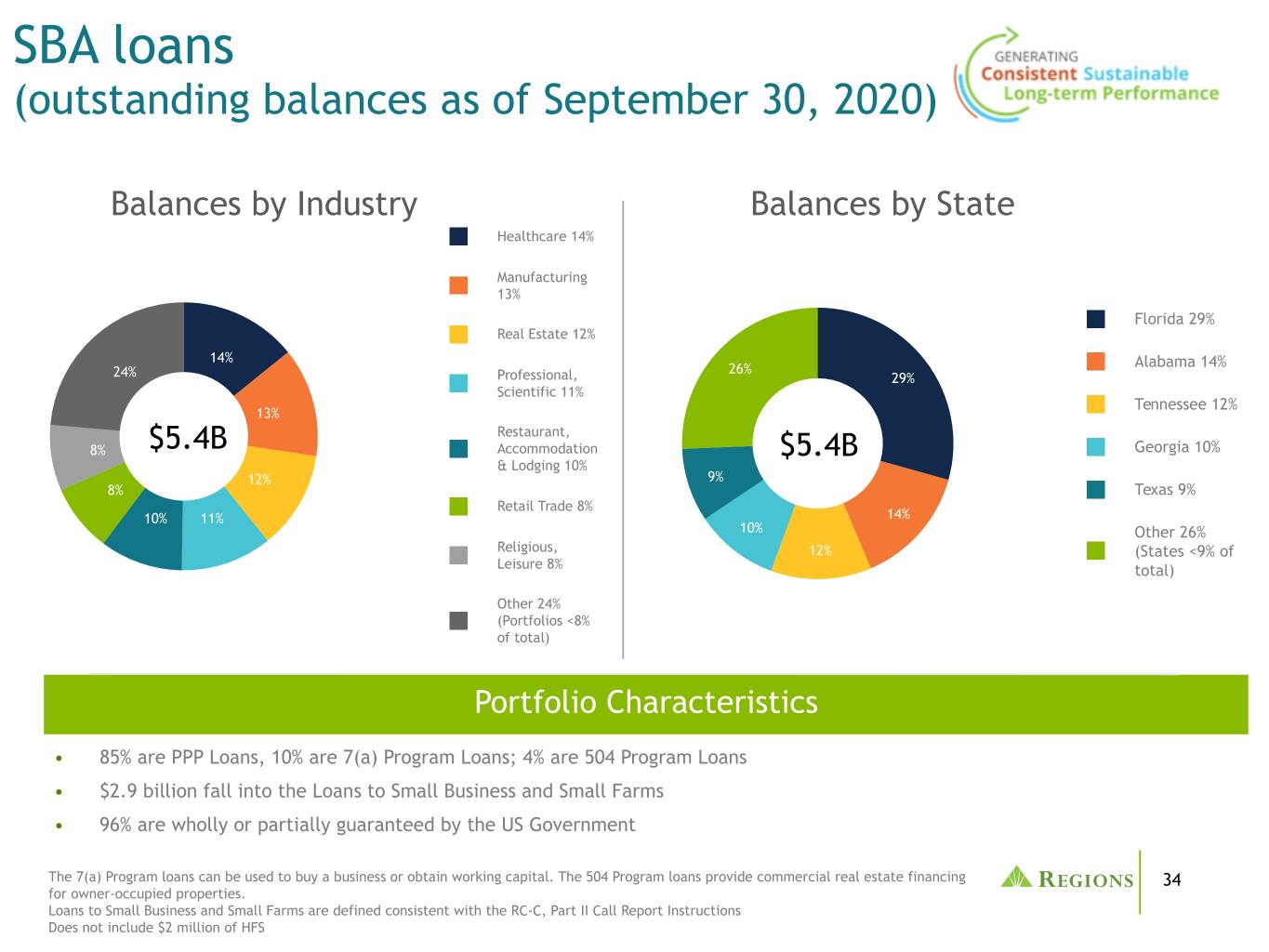
SBA loans (outstanding balances as of September 30, 2020) Balances by Industry Balances by State Healthcare 14% Manufacturing 13% Florida 29% Real Estate 12% 14% 26% Alabama 14% 24% Professional, 29% Scientific 11% Tennessee 12% 13% Restaurant, 8% $5.4B Accommodation $5.4B Georgia 10% & Lodging 10% 12% 9% 8% Texas 9% Retail Trade 8% 10% 11% 14% 10% Other 26% Religious, 12% (States <9% of Leisure 8% total) Other 24% (Portfolios <8% of total) Portfolio Characteristics • 85% are PPP Loans, 10% are 7(a) Program Loans; 4% are 504 Program Loans • $2.9 billion fall into the Loans to Small Business and Small Farms • 96% are wholly or partially guaranteed by the US Government The 7(a) Program loans can be used to buy a business or obtain working capital. The 504 Program loans provide commercial real estate financing 34 for owner-occupied properties. Loans to Small Business and Small Farms are defined consistent with the RC-C, Part II Call Report Instructions Does not include $2 million of HFS
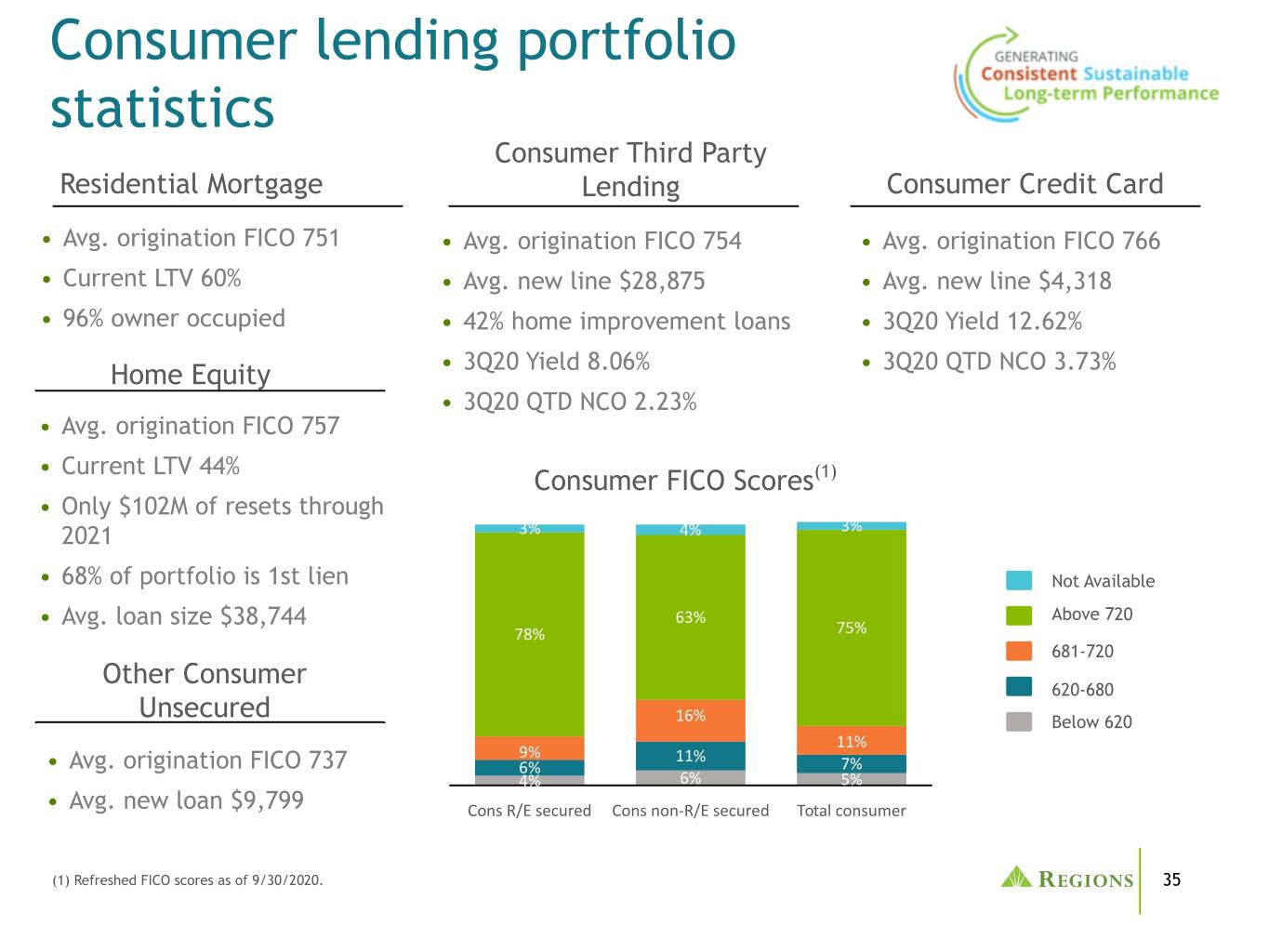
Consumer lending portfolio statistics Consumer Third Party Residential Mortgage Lending Consumer Credit Card • Avg. origination FICO 751 • Avg. origination FICO 754 • Avg. origination FICO 766 • Current LTV 60% • Avg. new line $28,875 • Avg. new line $4,318 • 96% owner occupied • 42% home improvement loans • 3Q20 Yield 12.62% Home Equity • 3Q20 Yield 8.06% • 3Q20 QTD NCO 3.73% • 3Q20 QTD NCO 2.23% • Avg. origination FICO 757 • Current LTV 44% Consumer FICO Scores(1) • Only $102M of resets through 2021 3% 4% 3% • 68% of portfolio is 1st lien Not Available • Avg. loan size $38,744 63% Above 720 78% 75% 681-720 Other Consumer 620-680 Unsecured 16% Below 620 11% 9% 11% • Avg. origination FICO 737 6% 7% 4% 6% 5% • Avg. new loan $9,799 Cons R/E secured Cons non-R/E secured Total consumer (1) Refreshed FICO scores as of 9/30/2020. 35
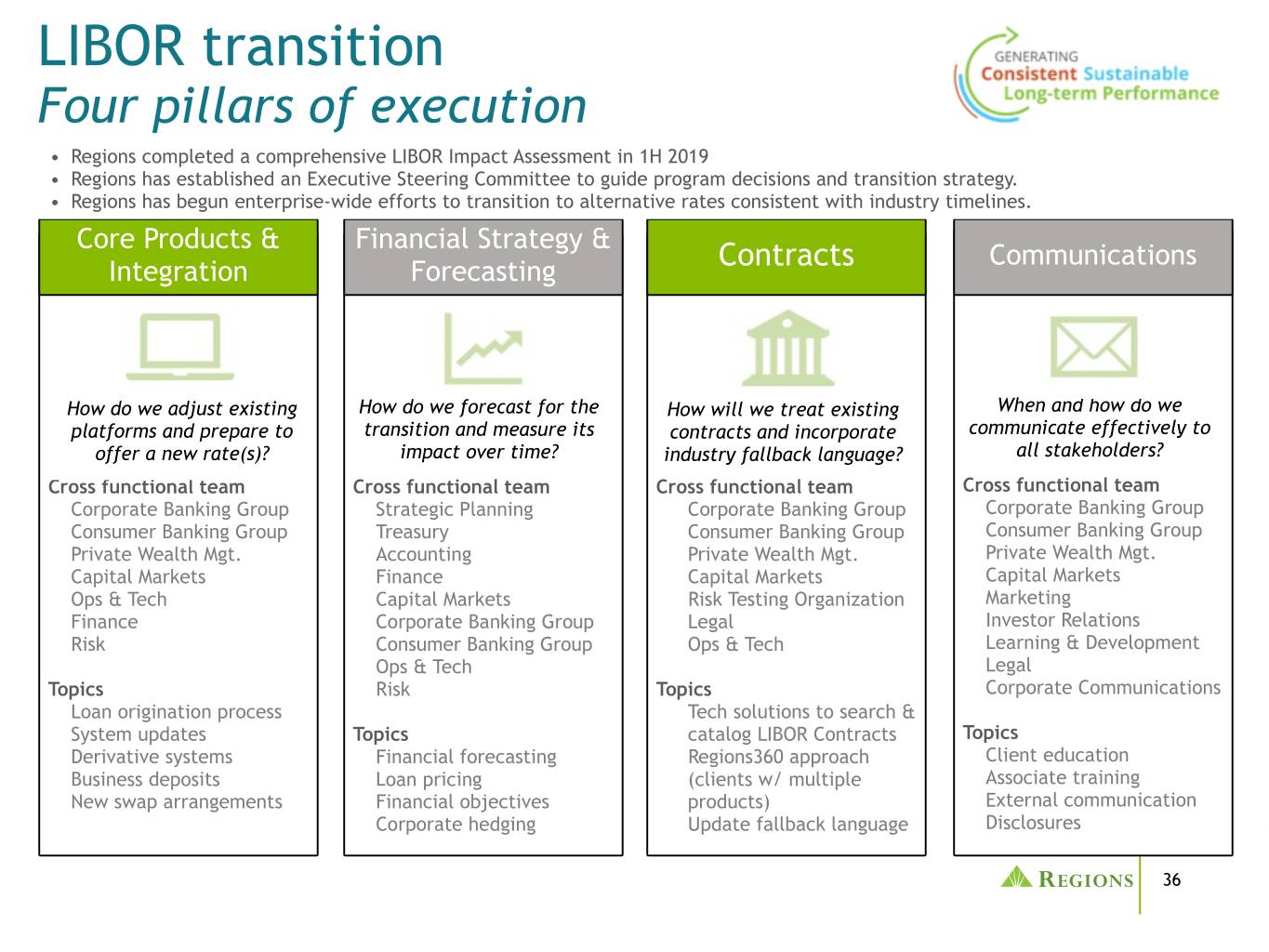
LIBOR transition Four pillars of execution • Regions completed a comprehensive LIBOR Impact Assessment in 1H 2019 • Regions has established an Executive Steering Committee to guide program decisions and transition strategy. • Regions has begun enterprise-wide efforts to transition to alternative rates consistent with industry timelines. Core Products & Financial Strategy & Contracts Communications Integration Forecasting How do we adjust existing How do we forecast for the How will we treat existing When and how do we platforms and prepare to transition and measure its contracts and incorporate communicate effectively to offer a new rate(s)? impact over time? industry fallback language? all stakeholders? Cross functional team Cross functional team Cross functional team Cross functional team Corporate Banking Group Strategic Planning Corporate Banking Group Corporate Banking Group Consumer Banking Group Treasury Consumer Banking Group Consumer Banking Group Private Wealth Mgt. Accounting Private Wealth Mgt. Private Wealth Mgt. Capital Markets Finance Capital Markets Capital Markets Ops & Tech Capital Markets Risk Testing Organization Marketing Finance Corporate Banking Group Legal Investor Relations Risk Consumer Banking Group Ops & Tech Learning & Development Ops & Tech Legal Topics Risk Topics Corporate Communications Loan origination process Tech solutions to search & System updates Topics catalog LIBOR Contracts Topics Derivative systems Financial forecasting Regions360 approach Client education Business deposits Loan pricing (clients w/ multiple Associate training New swap arrangements Financial objectives products) External communication Corporate hedging Update fallback language Disclosures 36
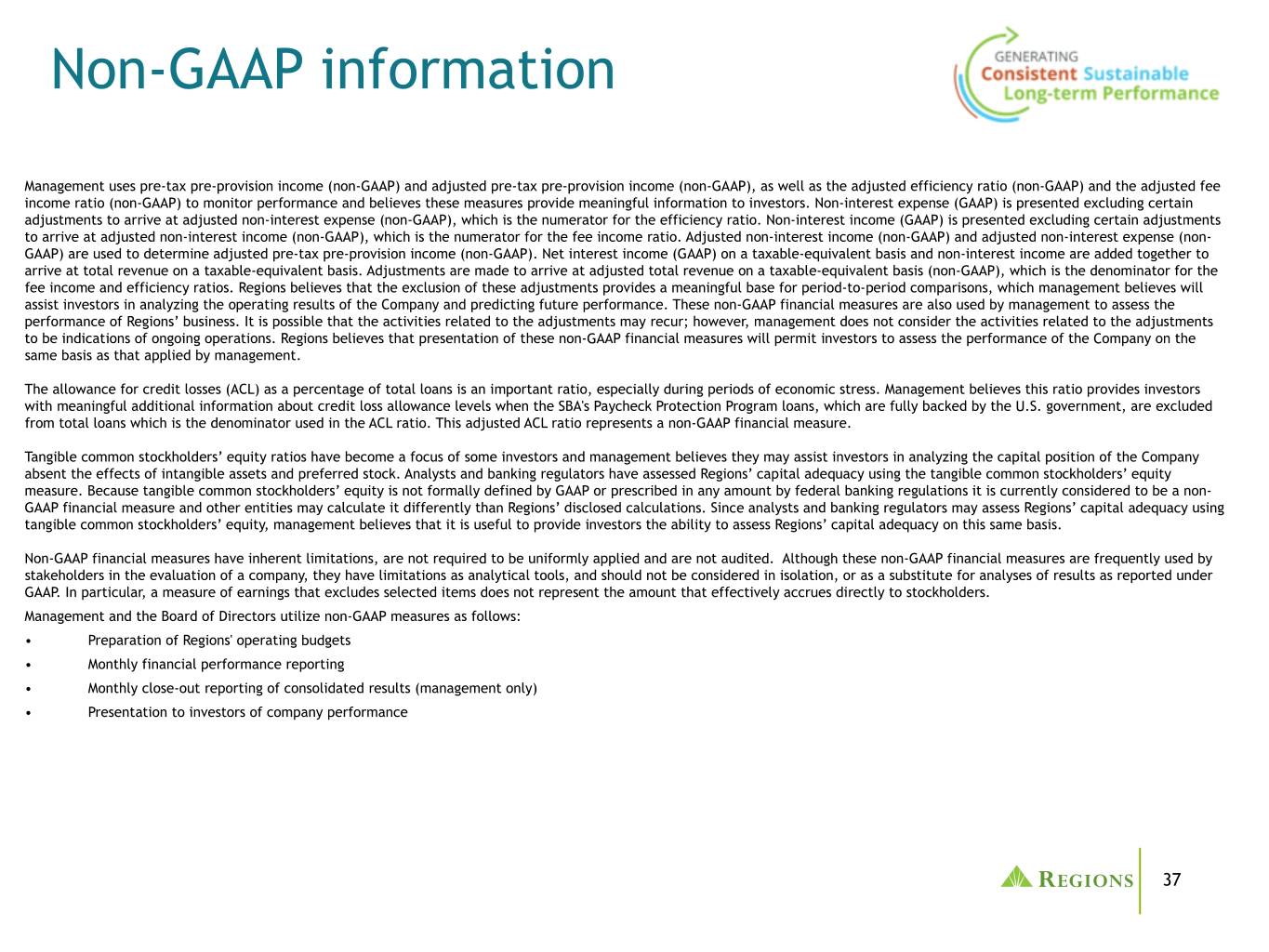
Non-GAAP information Management uses pre-tax pre-provision income (non-GAAP) and adjusted pre-tax pre-provision income (non-GAAP), as well as the adjusted efficiency ratio (non-GAAP) and the adjusted fee income ratio (non-GAAP) to monitor performance and believes these measures provide meaningful information to investors. Non-interest expense (GAAP) is presented excluding certain adjustments to arrive at adjusted non-interest expense (non-GAAP), which is the numerator for the efficiency ratio. Non-interest income (GAAP) is presented excluding certain adjustments to arrive at adjusted non-interest income (non-GAAP), which is the numerator for the fee income ratio. Adjusted non-interest income (non-GAAP) and adjusted non-interest expense (non- GAAP) are used to determine adjusted pre-tax pre-provision income (non-GAAP). Net interest income (GAAP) on a taxable-equivalent basis and non-interest income are added together to arrive at total revenue on a taxable-equivalent basis. Adjustments are made to arrive at adjusted total revenue on a taxable-equivalent basis (non-GAAP), which is the denominator for the fee income and efficiency ratios. Regions believes that the exclusion of these adjustments provides a meaningful base for period-to-period comparisons, which management believes will assist investors in analyzing the operating results of the Company and predicting future performance. These non-GAAP financial measures are also used by management to assess the performance of Regions’ business. It is possible that the activities related to the adjustments may recur; however, management does not consider the activities related to the adjustments to be indications of ongoing operations. Regions believes that presentation of these non-GAAP financial measures will permit investors to assess the performance of the Company on the same basis as that applied by management. The allowance for credit losses (ACL) as a percentage of total loans is an important ratio, especially during periods of economic stress. Management believes this ratio provides investors with meaningful additional information about credit loss allowance levels when the SBA's Paycheck Protection Program loans, which are fully backed by the U.S. government, are excluded from total loans which is the denominator used in the ACL ratio. This adjusted ACL ratio represents a non-GAAP financial measure. Tangible common stockholders’ equity ratios have become a focus of some investors and management believes they may assist investors in analyzing the capital position of the Company absent the effects of intangible assets and preferred stock. Analysts and banking regulators have assessed Regions’ capital adequacy using the tangible common stockholders’ equity measure. Because tangible common stockholders’ equity is not formally defined by GAAP or prescribed in any amount by federal banking regulations it is currently considered to be a non- GAAP financial measure and other entities may calculate it differently than Regions’ disclosed calculations. Since analysts and banking regulators may assess Regions’ capital adequacy using tangible common stockholders’ equity, management believes that it is useful to provide investors the ability to assess Regions’ capital adequacy on this same basis. Non-GAAP financial measures have inherent limitations, are not required to be uniformly applied and are not audited. Although these non-GAAP financial measures are frequently used by stakeholders in the evaluation of a company, they have limitations as analytical tools, and should not be considered in isolation, or as a substitute for analyses of results as reported under GAAP. In particular, a measure of earnings that excludes selected items does not represent the amount that effectively accrues directly to stockholders. Management and the Board of Directors utilize non-GAAP measures as follows: • Preparation of Regions' operating budgets • Monthly financial performance reporting • Monthly close-out reporting of consolidated results (management only) • Presentation to investors of company performance 37
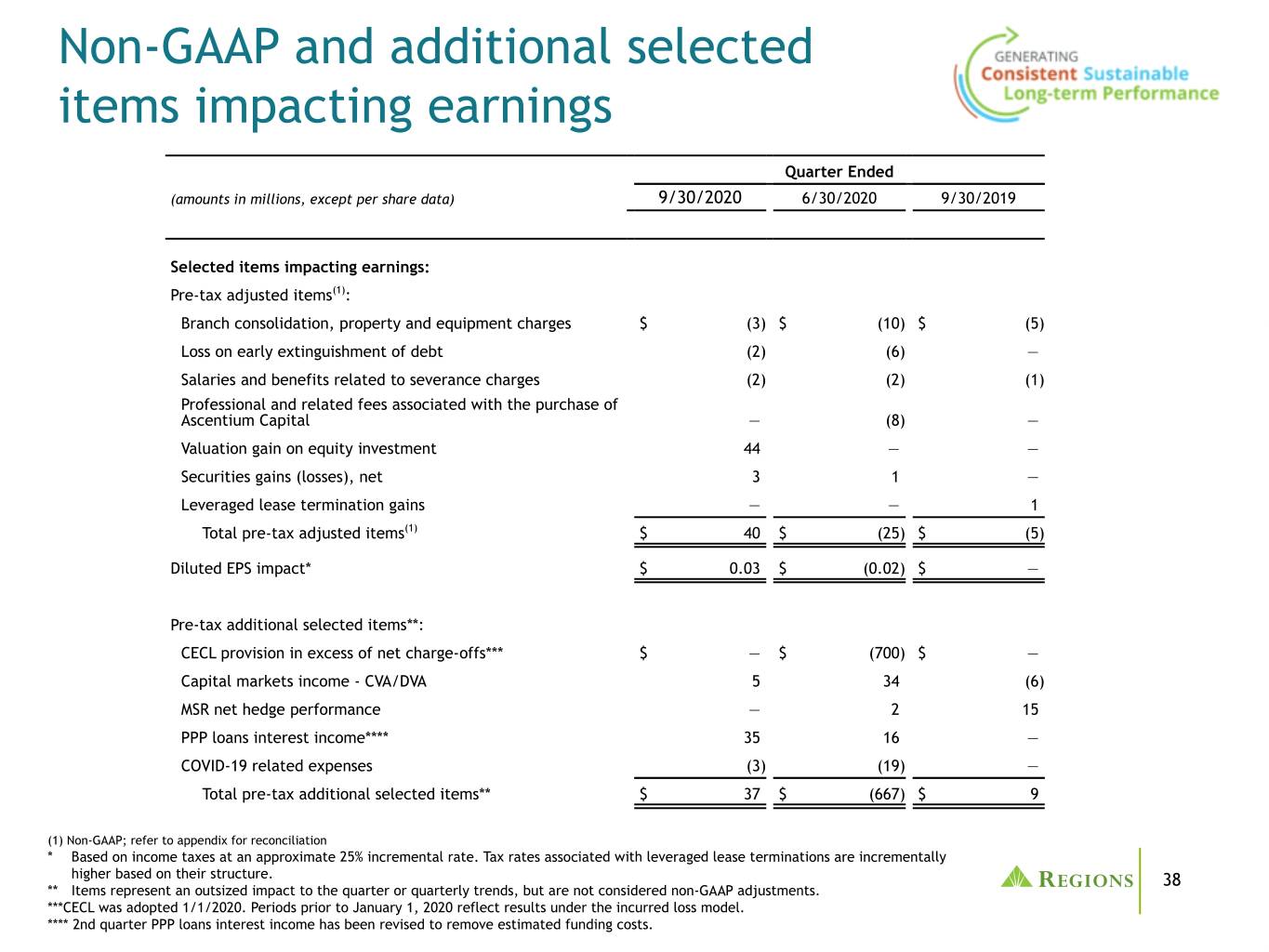
Non-GAAP and additional selected items impacting earnings Quarter Ended (amounts in millions, except per share data) 9/30/2020 6/30/2020 9/30/2019 Selected items impacting earnings: Pre-tax adjusted items(1): Branch consolidation, property and equipment charges $ (3) $ (10) $ (5) Loss on early extinguishment of debt (2) (6) — Salaries and benefits related to severance charges (2) (2) (1) Professional and related fees associated with the purchase of Ascentium Capital — (8) — Valuation gain on equity investment 44 — — Securities gains (losses), net 3 1 — Leveraged lease termination gains — — 1 Total pre-tax adjusted items(1) $ 40 $ (25) $ (5) Diluted EPS impact* $ 0.03 $ (0.02) $ — Pre-tax additional selected items**: CECL provision in excess of net charge-offs*** $ — $ (700) $ — Capital markets income - CVA/DVA 5 34 (6) MSR net hedge performance — 2 15 PPP loans interest income**** 35 16 — COVID-19 related expenses (3) (19) — Total pre-tax additional selected items** $ 37 $ (667) $ 9 (1) Non-GAAP; refer to appendix for reconciliation * Based on income taxes at an approximate 25% incremental rate. Tax rates associated with leveraged lease terminations are incrementally higher based on their structure. 38 ** Items represent an outsized impact to the quarter or quarterly trends, but are not considered non-GAAP adjustments. ***CECL was adopted 1/1/2020. Periods prior to January 1, 2020 reflect results under the incurred loss model. **** 2nd quarter PPP loans interest income has been revised to remove estimated funding costs.
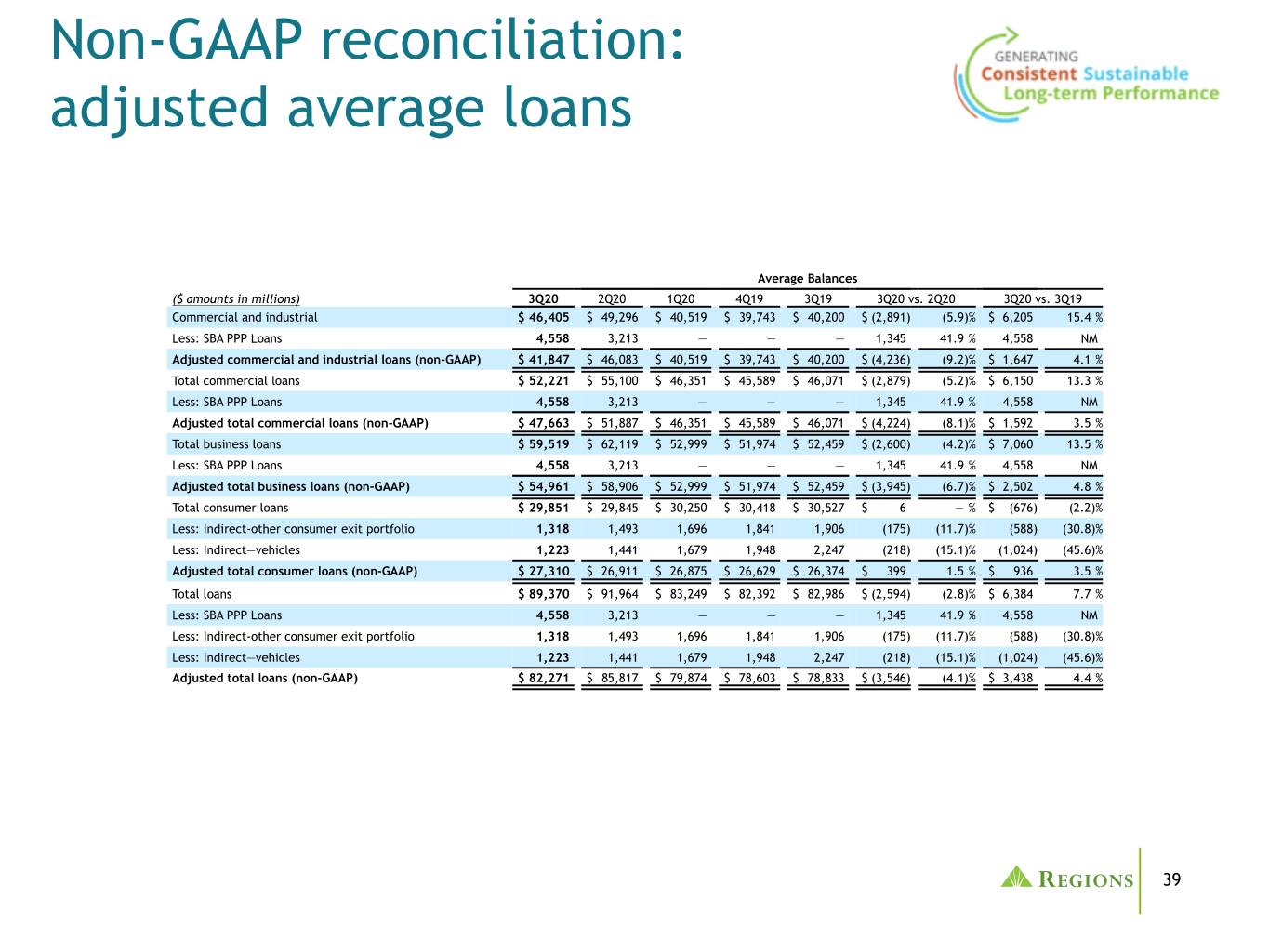
Non-GAAP reconciliation: adjusted average loans Average Balances ($ amounts in millions) 3Q20 2Q20 1Q20 4Q19 3Q19 3Q20 vs. 2Q20 3Q20 vs. 3Q19 Commercial and industrial $ 46,405 $ 49,296 $ 40,519 $ 39,743 $ 40,200 $ (2,891) (5.9)% $ 6,205 15.4 % Less: SBA PPP Loans 4,558 3,213 — — — 1,345 41.9 % 4,558 NM Adjusted commercial and industrial loans (non-GAAP) $ 41,847 $ 46,083 $ 40,519 $ 39,743 $ 40,200 $ (4,236) (9.2)% $ 1,647 4.1 % Total commercial loans $ 52,221 $ 55,100 $ 46,351 $ 45,589 $ 46,071 $ (2,879) (5.2)% $ 6,150 13.3 % Less: SBA PPP Loans 4,558 3,213 — — — 1,345 41.9 % 4,558 NM Adjusted total commercial loans (non-GAAP) $ 47,663 $ 51,887 $ 46,351 $ 45,589 $ 46,071 $ (4,224) (8.1)% $ 1,592 3.5 % Total business loans $ 59,519 $ 62,119 $ 52,999 $ 51,974 $ 52,459 $ (2,600) (4.2)% $ 7,060 13.5 % Less: SBA PPP Loans 4,558 3,213 — — — 1,345 41.9 % 4,558 NM Adjusted total business loans (non-GAAP) $ 54,961 $ 58,906 $ 52,999 $ 51,974 $ 52,459 $ (3,945) (6.7)% $ 2,502 4.8 % Total consumer loans $ 29,851 $ 29,845 $ 30,250 $ 30,418 $ 30,527 $ 6 — % $ (676) (2.2)% Less: Indirect-other consumer exit portfolio 1,318 1,493 1,696 1,841 1,906 (175) (11.7)% (588) (30.8)% Less: Indirect—vehicles 1,223 1,441 1,679 1,948 2,247 (218) (15.1)% (1,024) (45.6)% Adjusted total consumer loans (non-GAAP) $ 27,310 $ 26,911 $ 26,875 $ 26,629 $ 26,374 $ 399 1.5 % $ 936 3.5 % Total loans $ 89,370 $ 91,964 $ 83,249 $ 82,392 $ 82,986 $ (2,594) (2.8)% $ 6,384 7.7 % Less: SBA PPP Loans 4,558 3,213 — — — 1,345 41.9 % 4,558 NM Less: Indirect-other consumer exit portfolio 1,318 1,493 1,696 1,841 1,906 (175) (11.7)% (588) (30.8)% Less: Indirect—vehicles 1,223 1,441 1,679 1,948 2,247 (218) (15.1)% (1,024) (45.6)% Adjusted total loans (non-GAAP) $ 82,271 $ 85,817 $ 79,874 $ 78,603 $ 78,833 $ (3,546) (4.1)% $ 3,438 4.4 % 39
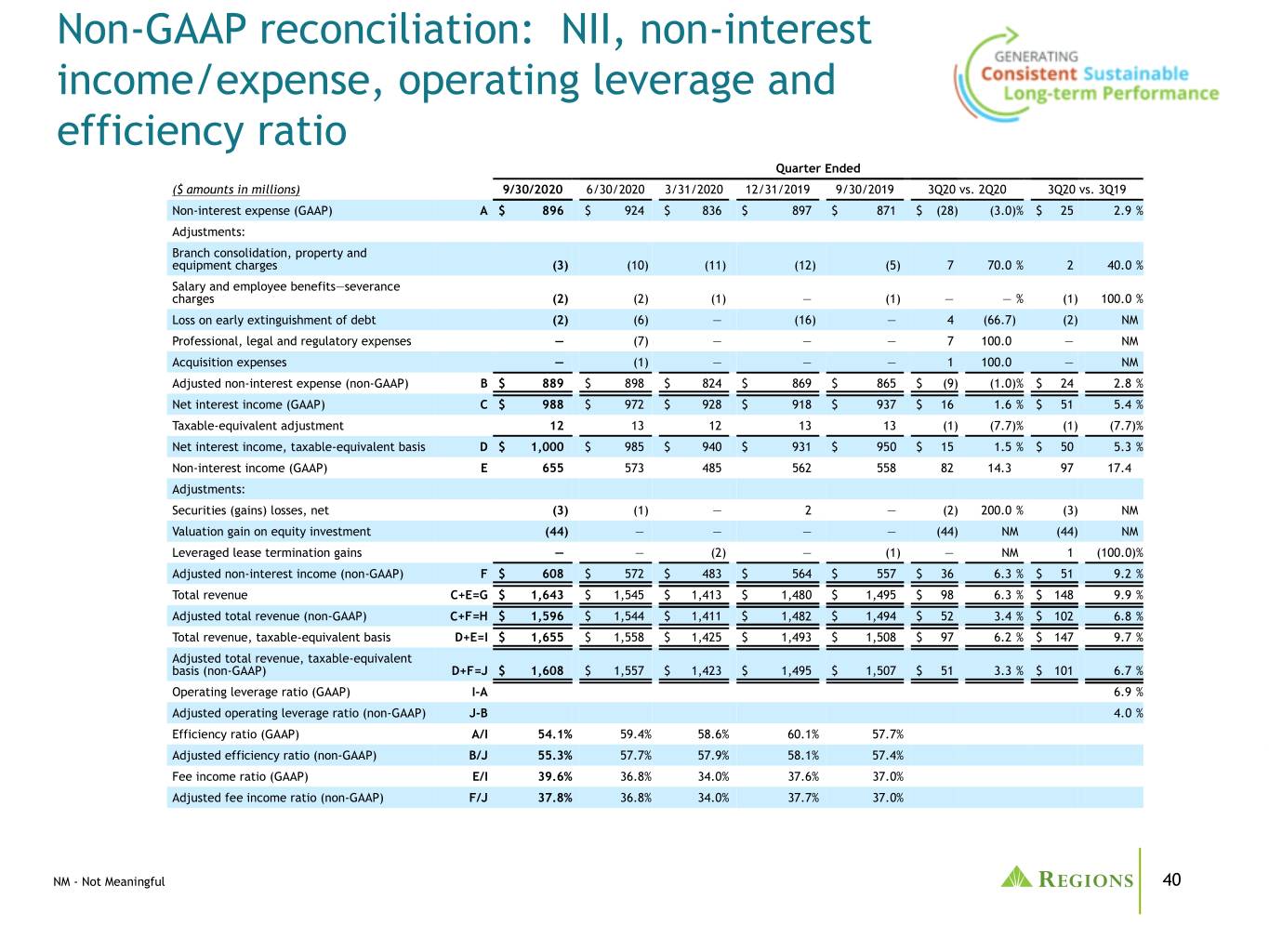
Non-GAAP reconciliation: NII, non-interest income/expense, operating leverage and efficiency ratio Quarter Ended ($ amounts in millions) 9/30/2020 6/30/2020 3/31/2020 12/31/2019 9/30/2019 3Q20 vs. 2Q20 3Q20 vs. 3Q19 Non-interest expense (GAAP) A $ 896 $ 924 $ 836 $ 897 $ 871 $ (28) (3.0)% $ 25 2.9 % Adjustments: Branch consolidation, property and equipment charges (3) (10) (11) (12) (5) 7 70.0 % 2 40.0 % Salary and employee benefits—severance charges (2) (2) (1) — (1) — — % (1) 100.0 % Loss on early extinguishment of debt (2) (6) — (16) — 4 (66.7) (2) NM Professional, legal and regulatory expenses — (7) — — — 7 100.0 — NM Acquisition expenses — (1) — — — 1 100.0 — NM Adjusted non-interest expense (non-GAAP) B $ 889 $ 898 $ 824 $ 869 $ 865 $ (9) (1.0)% $ 24 2.8 % Net interest income (GAAP) C $ 988 $ 972 $ 928 $ 918 $ 937 $ 16 1.6 % $ 51 5.4 % Taxable-equivalent adjustment 12 13 12 13 13 (1) (7.7)% (1) (7.7)% Net interest income, taxable-equivalent basis D $ 1,000 $ 985 $ 940 $ 931 $ 950 $ 15 1.5 % $ 50 5.3 % Non-interest income (GAAP) E 655 573 485 562 558 82 14.3 97 17.4 Adjustments: Securities (gains) losses, net (3) (1) — 2 — (2) 200.0 % (3) NM Valuation gain on equity investment (44) — — — — (44) NM (44) NM Leveraged lease termination gains — — (2) — (1) — NM 1 (100.0)% Adjusted non-interest income (non-GAAP) F $ 608 $ 572 $ 483 $ 564 $ 557 $ 36 6.3 % $ 51 9.2 % Total revenue C+E=G $ 1,643 $ 1,545 $ 1,413 $ 1,480 $ 1,495 $ 98 6.3 % $ 148 9.9 % Adjusted total revenue (non-GAAP) C+F=H $ 1,596 $ 1,544 $ 1,411 $ 1,482 $ 1,494 $ 52 3.4 % $ 102 6.8 % Total revenue, taxable-equivalent basis D+E=I $ 1,655 $ 1,558 $ 1,425 $ 1,493 $ 1,508 $ 97 6.2 % $ 147 9.7 % Adjusted total revenue, taxable-equivalent basis (non-GAAP) D+F=J $ 1,608 $ 1,557 $ 1,423 $ 1,495 $ 1,507 $ 51 3.3 % $ 101 6.7 % Operating leverage ratio (GAAP) I-A 6.9 % Adjusted operating leverage ratio (non-GAAP) J-B 4.0 % Efficiency ratio (GAAP) A/I 54.1% 59.4% 58.6% 60.1% 57.7% Adjusted efficiency ratio (non-GAAP) B/J 55.3% 57.7% 57.9% 58.1% 57.4% Fee income ratio (GAAP) E/I 39.6% 36.8% 34.0% 37.6% 37.0% Adjusted fee income ratio (non-GAAP) F/J 37.8% 36.8% 34.0% 37.7% 37.0% NM - Not Meaningful 40
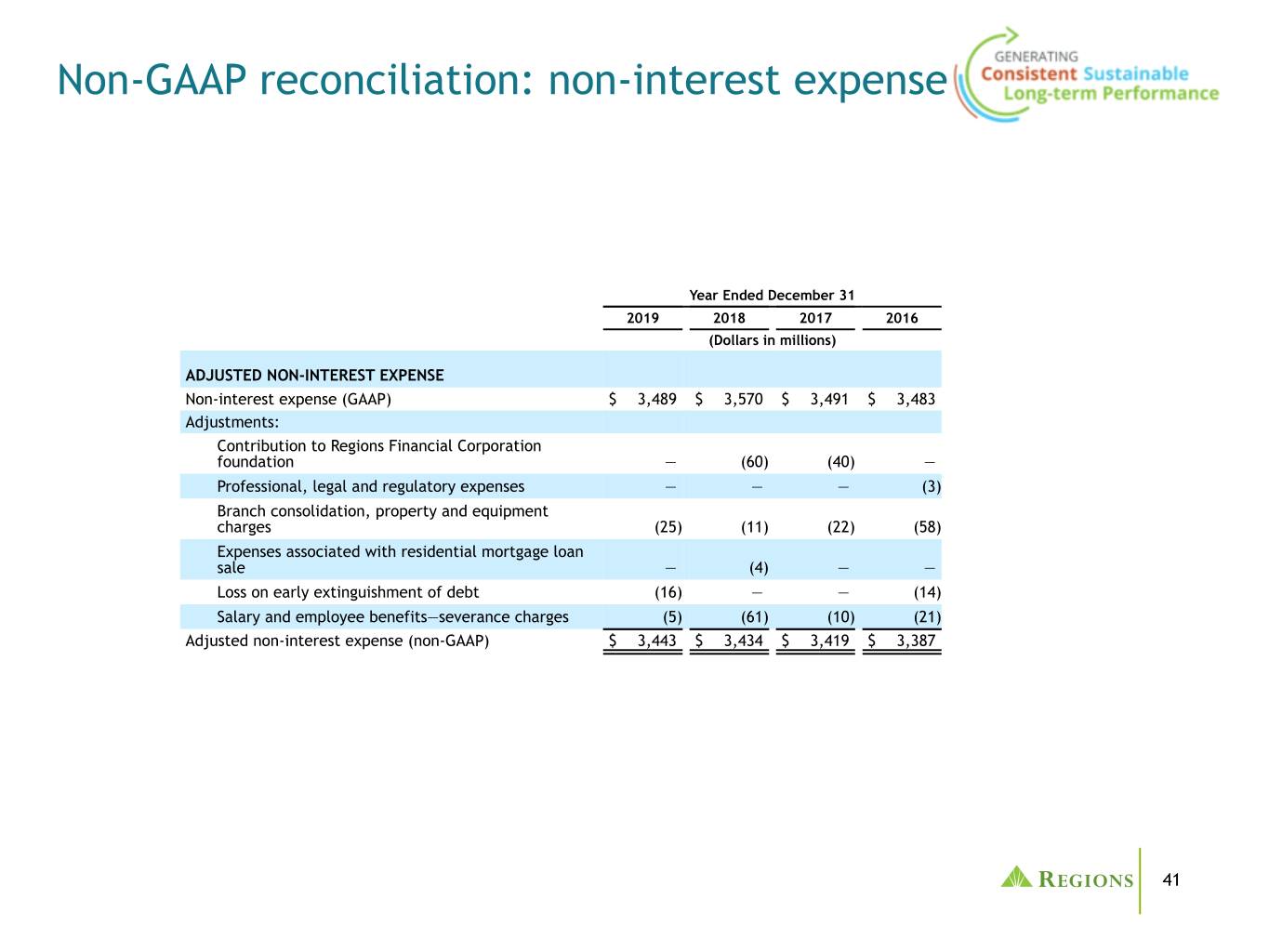
Non-GAAP reconciliation: non-interest expense Year Ended December 31 2019 2018 2017 2016 (Dollars in millions) ADJUSTED NON-INTEREST EXPENSE Non-interest expense (GAAP) $ 3,489 $ 3,570 $ 3,491 $ 3,483 Adjustments: Contribution to Regions Financial Corporation foundation — (60) (40) — Professional, legal and regulatory expenses — — — (3) Branch consolidation, property and equipment charges (25) (11) (22) (58) Expenses associated with residential mortgage loan sale — (4) — — Loss on early extinguishment of debt (16) — — (14) Salary and employee benefits—severance charges (5) (61) (10) (21) Adjusted non-interest expense (non-GAAP) $ 3,443 $ 3,434 $ 3,419 $ 3,387 41
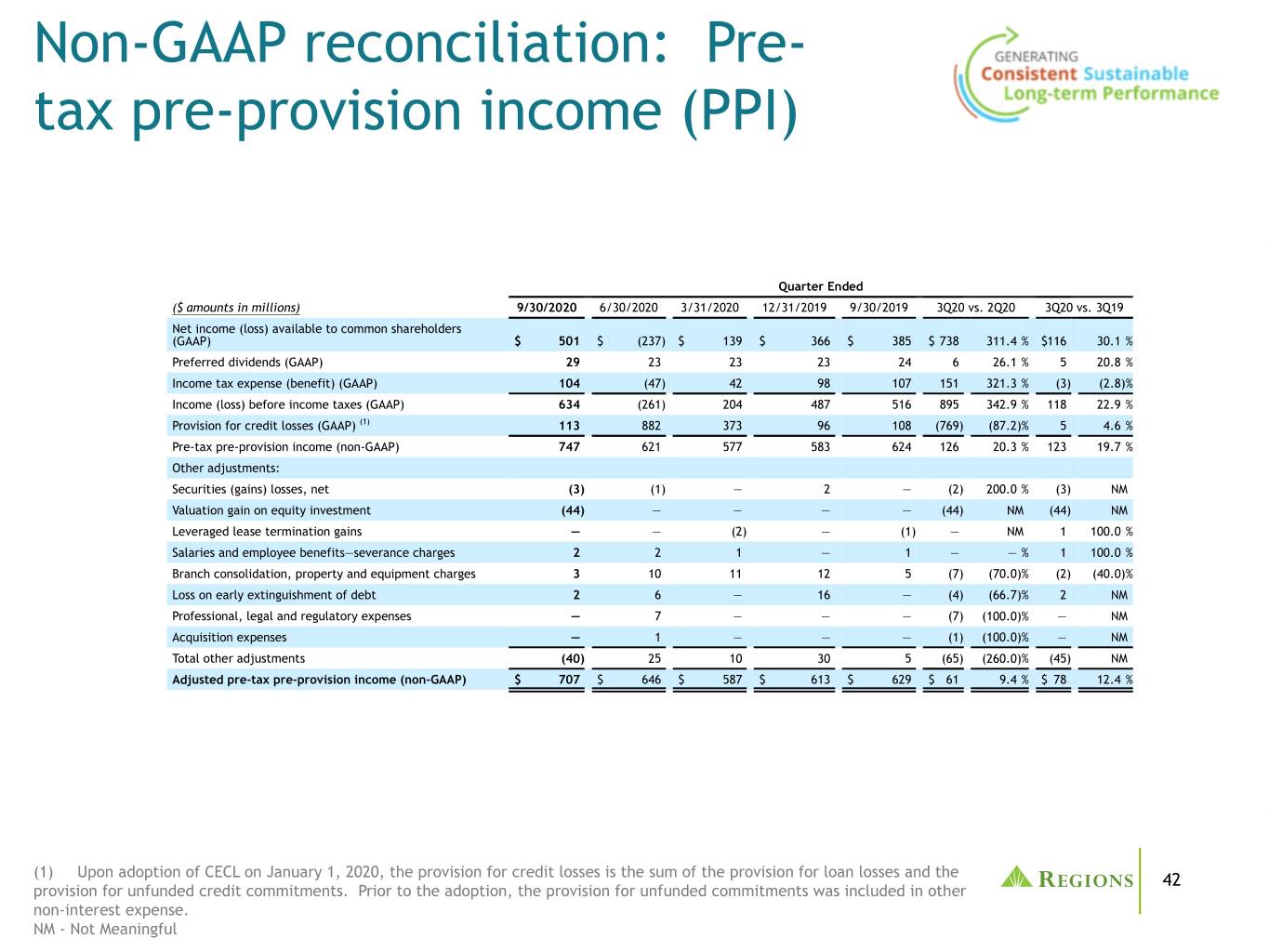
Non-GAAP reconciliation: Pre- tax pre-provision income (PPI) Quarter Ended ($ amounts in millions) 9/30/2020 6/30/2020 3/31/2020 12/31/2019 9/30/2019 3Q20 vs. 2Q20 3Q20 vs. 3Q19 Net income (loss) available to common shareholders (GAAP) $ 501 $ (237) $ 139 $ 366 $ 385 $ 738 311.4 % $116 30.1 % Preferred dividends (GAAP) 29 23 23 23 24 6 26.1 % 5 20.8 % Income tax expense (benefit) (GAAP) 104 (47) 42 98 107 151 321.3 % (3) (2.8)% Income (loss) before income taxes (GAAP) 634 (261) 204 487 516 895 342.9 % 118 22.9 % Provision for credit losses (GAAP) (1) 113 882 373 96 108 (769) (87.2)% 5 4.6 % Pre-tax pre-provision income (non-GAAP) 747 621 577 583 624 126 20.3 % 123 19.7 % Other adjustments: Securities (gains) losses, net (3) (1) — 2 — (2) 200.0 % (3) NM Valuation gain on equity investment (44) — — — — (44) NM (44) NM Leveraged lease termination gains — — (2) — (1) — NM 1 100.0 % Salaries and employee benefits—severance charges 2 2 1 — 1 — — % 1 100.0 % Branch consolidation, property and equipment charges 3 10 11 12 5 (7) (70.0)% (2) (40.0)% Loss on early extinguishment of debt 2 6 — 16 — (4) (66.7)% 2 NM Professional, legal and regulatory expenses — 7 — — — (7) (100.0)% — NM Acquisition expenses — 1 — — — (1) (100.0)% — NM Total other adjustments (40) 25 10 30 5 (65) (260.0)% (45) NM Adjusted pre-tax pre-provision income (non-GAAP) $ 707 $ 646 $ 587 $ 613 $ 629 $ 61 9.4 % $ 78 12.4 % (1) Upon adoption of CECL on January 1, 2020, the provision for credit losses is the sum of the provision for loan losses and the 42 provision for unfunded credit commitments. Prior to the adoption, the provision for unfunded commitments was included in other non-interest expense. NM - Not Meaningful
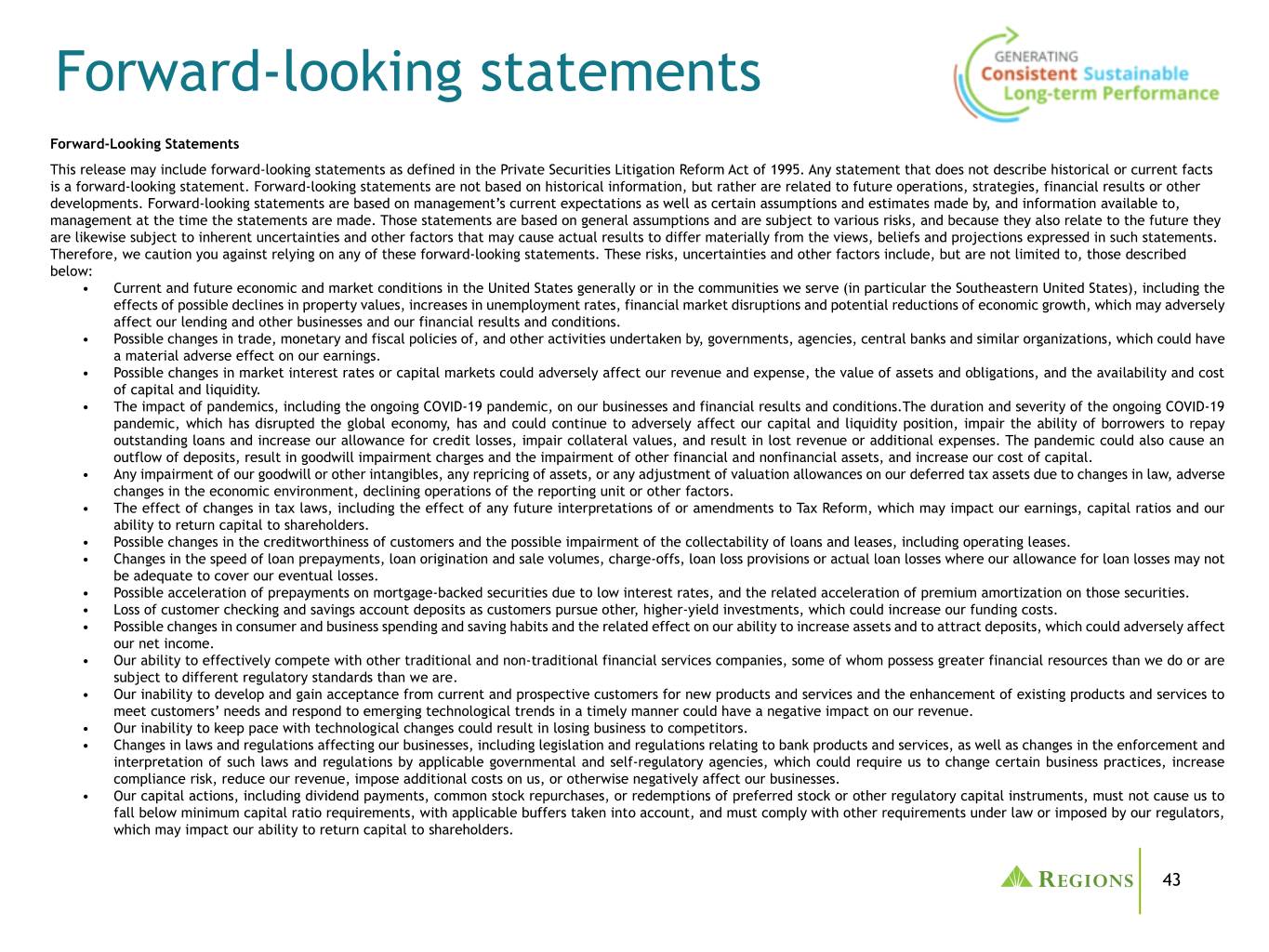
Forward-looking statements Forward-Looking Statements This release may include forward-looking statements as defined in the Private Securities Litigation Reform Act of 1995. Any statement that does not describe historical or current facts is a forward-looking statement. Forward-looking statements are not based on historical information, but rather are related to future operations, strategies, financial results or other developments. Forward-looking statements are based on management’s current expectations as well as certain assumptions and estimates made by, and information available to, management at the time the statements are made. Those statements are based on general assumptions and are subject to various risks, and because they also relate to the future they are likewise subject to inherent uncertainties and other factors that may cause actual results to differ materially from the views, beliefs and projections expressed in such statements. Therefore, we caution you against relying on any of these forward-looking statements. These risks, uncertainties and other factors include, but are not limited to, those described below: • Current and future economic and market conditions in the United States generally or in the communities we serve (in particular the Southeastern United States), including the effects of possible declines in property values, increases in unemployment rates, financial market disruptions and potential reductions of economic growth, which may adversely affect our lending and other businesses and our financial results and conditions. • Possible changes in trade, monetary and fiscal policies of, and other activities undertaken by, governments, agencies, central banks and similar organizations, which could have a material adverse effect on our earnings. • Possible changes in market interest rates or capital markets could adversely affect our revenue and expense, the value of assets and obligations, and the availability and cost of capital and liquidity. • The impact of pandemics, including the ongoing COVID-19 pandemic, on our businesses and financial results and conditions.The duration and severity of the ongoing COVID-19 pandemic, which has disrupted the global economy, has and could continue to adversely affect our capital and liquidity position, impair the ability of borrowers to repay outstanding loans and increase our allowance for credit losses, impair collateral values, and result in lost revenue or additional expenses. The pandemic could also cause an outflow of deposits, result in goodwill impairment charges and the impairment of other financial and nonfinancial assets, and increase our cost of capital. • Any impairment of our goodwill or other intangibles, any repricing of assets, or any adjustment of valuation allowances on our deferred tax assets due to changes in law, adverse changes in the economic environment, declining operations of the reporting unit or other factors. • The effect of changes in tax laws, including the effect of any future interpretations of or amendments to Tax Reform, which may impact our earnings, capital ratios and our ability to return capital to shareholders. • Possible changes in the creditworthiness of customers and the possible impairment of the collectability of loans and leases, including operating leases. • Changes in the speed of loan prepayments, loan origination and sale volumes, charge-offs, loan loss provisions or actual loan losses where our allowance for loan losses may not be adequate to cover our eventual losses. • Possible acceleration of prepayments on mortgage-backed securities due to low interest rates, and the related acceleration of premium amortization on those securities. • Loss of customer checking and savings account deposits as customers pursue other, higher-yield investments, which could increase our funding costs. • Possible changes in consumer and business spending and saving habits and the related effect on our ability to increase assets and to attract deposits, which could adversely affect our net income. • Our ability to effectively compete with other traditional and non-traditional financial services companies, some of whom possess greater financial resources than we do or are subject to different regulatory standards than we are. • Our inability to develop and gain acceptance from current and prospective customers for new products and services and the enhancement of existing products and services to meet customers’ needs and respond to emerging technological trends in a timely manner could have a negative impact on our revenue. • Our inability to keep pace with technological changes could result in losing business to competitors. • Changes in laws and regulations affecting our businesses, including legislation and regulations relating to bank products and services, as well as changes in the enforcement and interpretation of such laws and regulations by applicable governmental and self-regulatory agencies, which could require us to change certain business practices, increase compliance risk, reduce our revenue, impose additional costs on us, or otherwise negatively affect our businesses. • Our capital actions, including dividend payments, common stock repurchases, or redemptions of preferred stock or other regulatory capital instruments, must not cause us to fall below minimum capital ratio requirements, with applicable buffers taken into account, and must comply with other requirements under law or imposed by our regulators, which may impact our ability to return capital to shareholders. 43
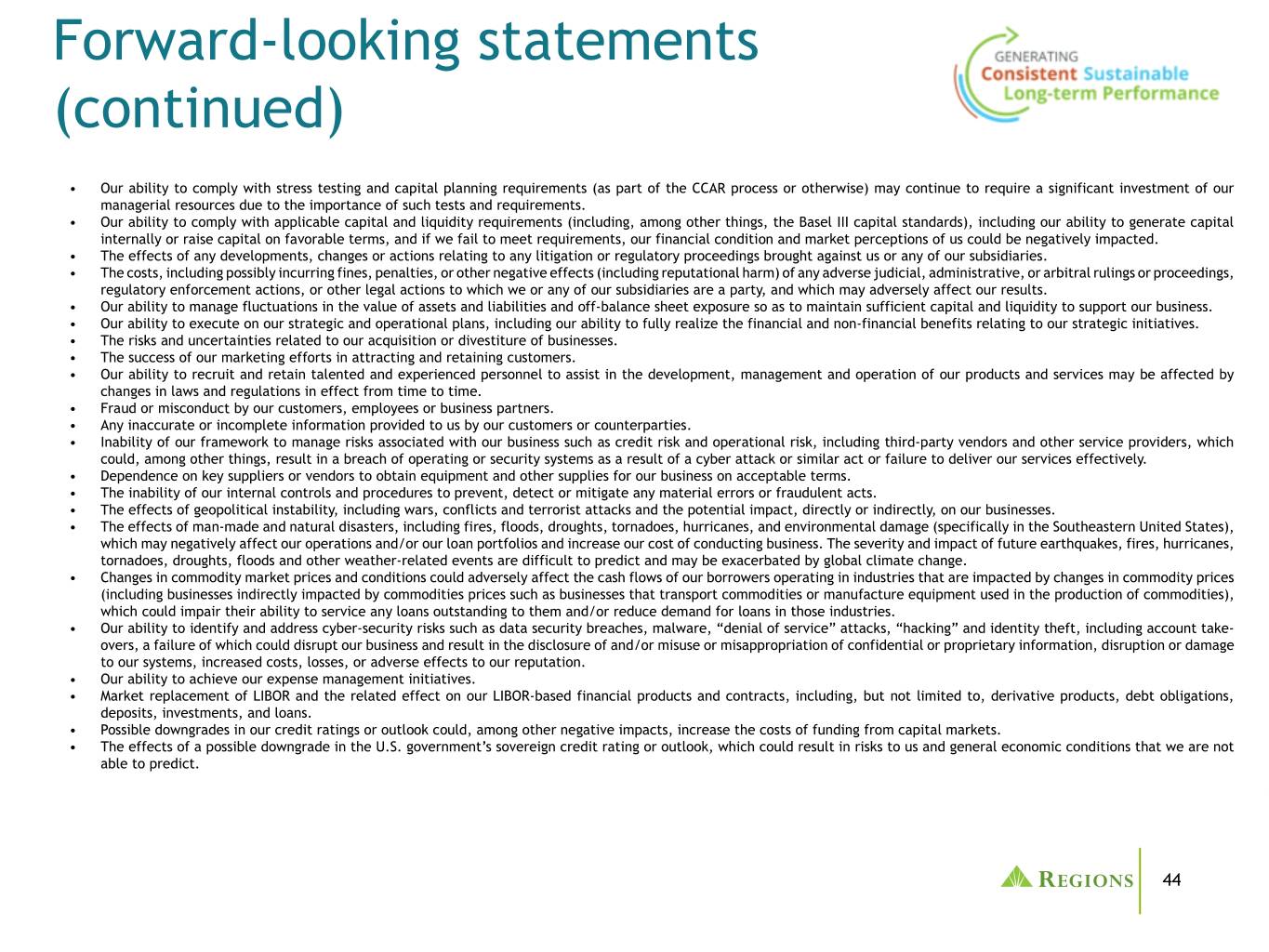
Forward-looking statements (continued) • Our ability to comply with stress testing and capital planning requirements (as part of the CCAR process or otherwise) may continue to require a significant investment of our managerial resources due to the importance of such tests and requirements. • Our ability to comply with applicable capital and liquidity requirements (including, among other things, the Basel III capital standards), including our ability to generate capital internally or raise capital on favorable terms, and if we fail to meet requirements, our financial condition and market perceptions of us could be negatively impacted. • The effects of any developments, changes or actions relating to any litigation or regulatory proceedings brought against us or any of our subsidiaries. • The costs, including possibly incurring fines, penalties, or other negative effects (including reputational harm) of any adverse judicial, administrative, or arbitral rulings or proceedings, regulatory enforcement actions, or other legal actions to which we or any of our subsidiaries are a party, and which may adversely affect our results. • Our ability to manage fluctuations in the value of assets and liabilities and off-balance sheet exposure so as to maintain sufficient capital and liquidity to support our business. • Our ability to execute on our strategic and operational plans, including our ability to fully realize the financial and non-financial benefits relating to our strategic initiatives. • The risks and uncertainties related to our acquisition or divestiture of businesses. • The success of our marketing efforts in attracting and retaining customers. • Our ability to recruit and retain talented and experienced personnel to assist in the development, management and operation of our products and services may be affected by changes in laws and regulations in effect from time to time. • Fraud or misconduct by our customers, employees or business partners. • Any inaccurate or incomplete information provided to us by our customers or counterparties. • Inability of our framework to manage risks associated with our business such as credit risk and operational risk, including third-party vendors and other service providers, which could, among other things, result in a breach of operating or security systems as a result of a cyber attack or similar act or failure to deliver our services effectively. • Dependence on key suppliers or vendors to obtain equipment and other supplies for our business on acceptable terms. • The inability of our internal controls and procedures to prevent, detect or mitigate any material errors or fraudulent acts. • The effects of geopolitical instability, including wars, conflicts and terrorist attacks and the potential impact, directly or indirectly, on our businesses. • The effects of man-made and natural disasters, including fires, floods, droughts, tornadoes, hurricanes, and environmental damage (specifically in the Southeastern United States), which may negatively affect our operations and/or our loan portfolios and increase our cost of conducting business. The severity and impact of future earthquakes, fires, hurricanes, tornadoes, droughts, floods and other weather-related events are difficult to predict and may be exacerbated by global climate change. • Changes in commodity market prices and conditions could adversely affect the cash flows of our borrowers operating in industries that are impacted by changes in commodity prices (including businesses indirectly impacted by commodities prices such as businesses that transport commodities or manufacture equipment used in the production of commodities), which could impair their ability to service any loans outstanding to them and/or reduce demand for loans in those industries. • Our ability to identify and address cyber-security risks such as data security breaches, malware, “denial of service” attacks, “hacking” and identity theft, including account take- overs, a failure of which could disrupt our business and result in the disclosure of and/or misuse or misappropriation of confidential or proprietary information, disruption or damage to our systems, increased costs, losses, or adverse effects to our reputation. • Our ability to achieve our expense management initiatives. • Market replacement of LIBOR and the related effect on our LIBOR-based financial products and contracts, including, but not limited to, derivative products, debt obligations, deposits, investments, and loans. • Possible downgrades in our credit ratings or outlook could, among other negative impacts, increase the costs of funding from capital markets. • The effects of a possible downgrade in the U.S. government’s sovereign credit rating or outlook, which could result in risks to us and general economic conditions that we are not able to predict. 44
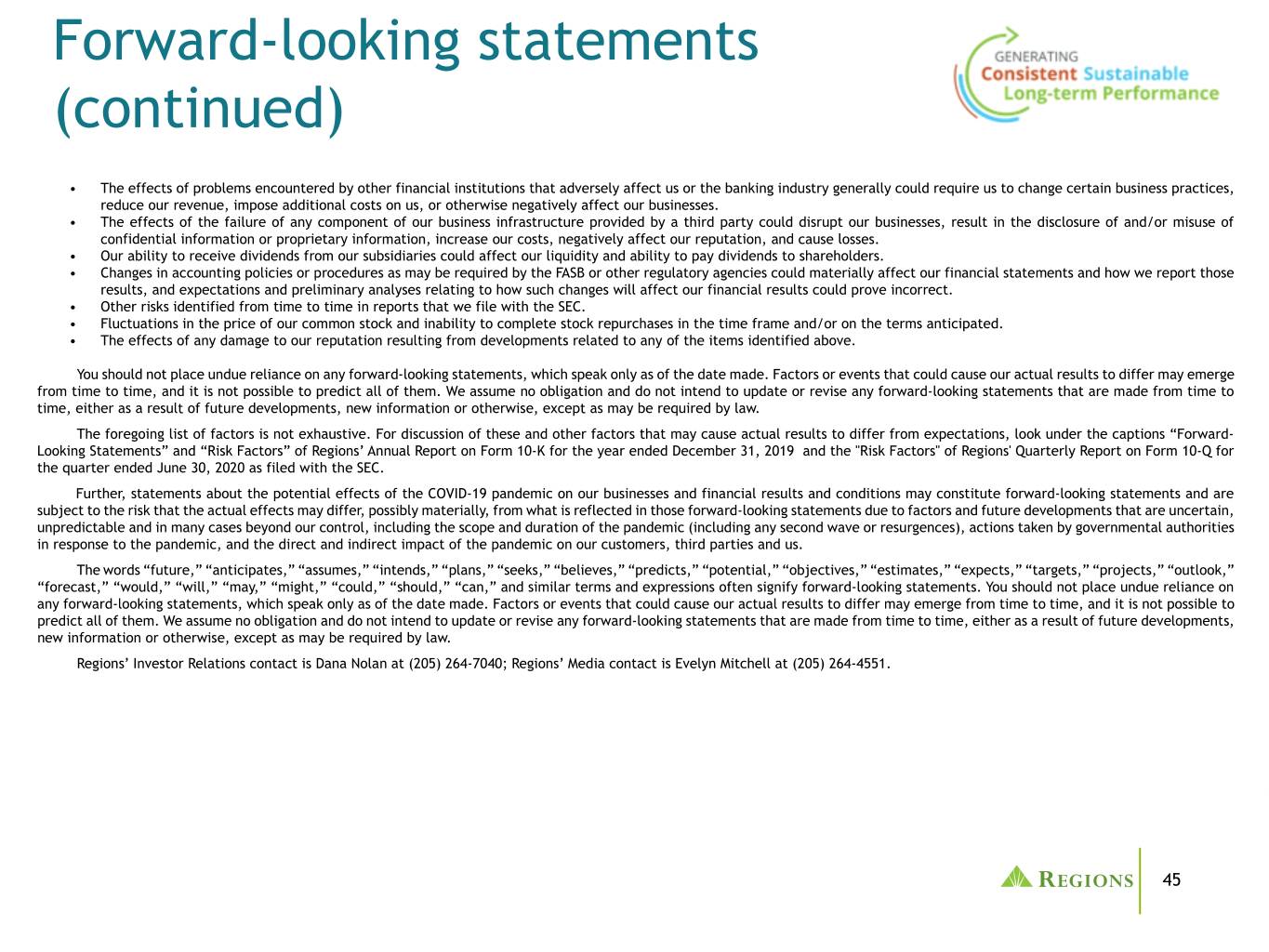
Forward-looking statements (continued) • The effects of problems encountered by other financial institutions that adversely affect us or the banking industry generally could require us to change certain business practices, reduce our revenue, impose additional costs on us, or otherwise negatively affect our businesses. • The effects of the failure of any component of our business infrastructure provided by a third party could disrupt our businesses, result in the disclosure of and/or misuse of confidential information or proprietary information, increase our costs, negatively affect our reputation, and cause losses. • Our ability to receive dividends from our subsidiaries could affect our liquidity and ability to pay dividends to shareholders. • Changes in accounting policies or procedures as may be required by the FASB or other regulatory agencies could materially affect our financial statements and how we report those results, and expectations and preliminary analyses relating to how such changes will affect our financial results could prove incorrect. • Other risks identified from time to time in reports that we file with the SEC. • Fluctuations in the price of our common stock and inability to complete stock repurchases in the time frame and/or on the terms anticipated. • The effects of any damage to our reputation resulting from developments related to any of the items identified above. You should not place undue reliance on any forward-looking statements, which speak only as of the date made. Factors or events that could cause our actual results to differ may emerge from time to time, and it is not possible to predict all of them. We assume no obligation and do not intend to update or revise any forward-looking statements that are made from time to time, either as a result of future developments, new information or otherwise, except as may be required by law. The foregoing list of factors is not exhaustive. For discussion of these and other factors that may cause actual results to differ from expectations, look under the captions “Forward- Looking Statements” and “Risk Factors” of Regions’ Annual Report on Form 10-K for the year ended December 31, 2019 and the "Risk Factors" of Regions' Quarterly Report on Form 10-Q for the quarter ended June 30, 2020 as filed with the SEC. Further, statements about the potential effects of the COVID-19 pandemic on our businesses and financial results and conditions may constitute forward-looking statements and are subject to the risk that the actual effects may differ, possibly materially, from what is reflected in those forward-looking statements due to factors and future developments that are uncertain, unpredictable and in many cases beyond our control, including the scope and duration of the pandemic (including any second wave or resurgences), actions taken by governmental authorities in response to the pandemic, and the direct and indirect impact of the pandemic on our customers, third parties and us. The words “future,” “anticipates,” “assumes,” “intends,” “plans,” “seeks,” “believes,” “predicts,” “potential,” “objectives,” “estimates,” “expects,” “targets,” “projects,” “outlook,” “forecast,” “would,” “will,” “may,” “might,” “could,” “should,” “can,” and similar terms and expressions often signify forward-looking statements. You should not place undue reliance on any forward-looking statements, which speak only as of the date made. Factors or events that could cause our actual results to differ may emerge from time to time, and it is not possible to predict all of them. We assume no obligation and do not intend to update or revise any forward-looking statements that are made from time to time, either as a result of future developments, new information or otherwise, except as may be required by law. Regions’ Investor Relations contact is Dana Nolan at (205) 264-7040; Regions’ Media contact is Evelyn Mitchell at (205) 264-4551. 45
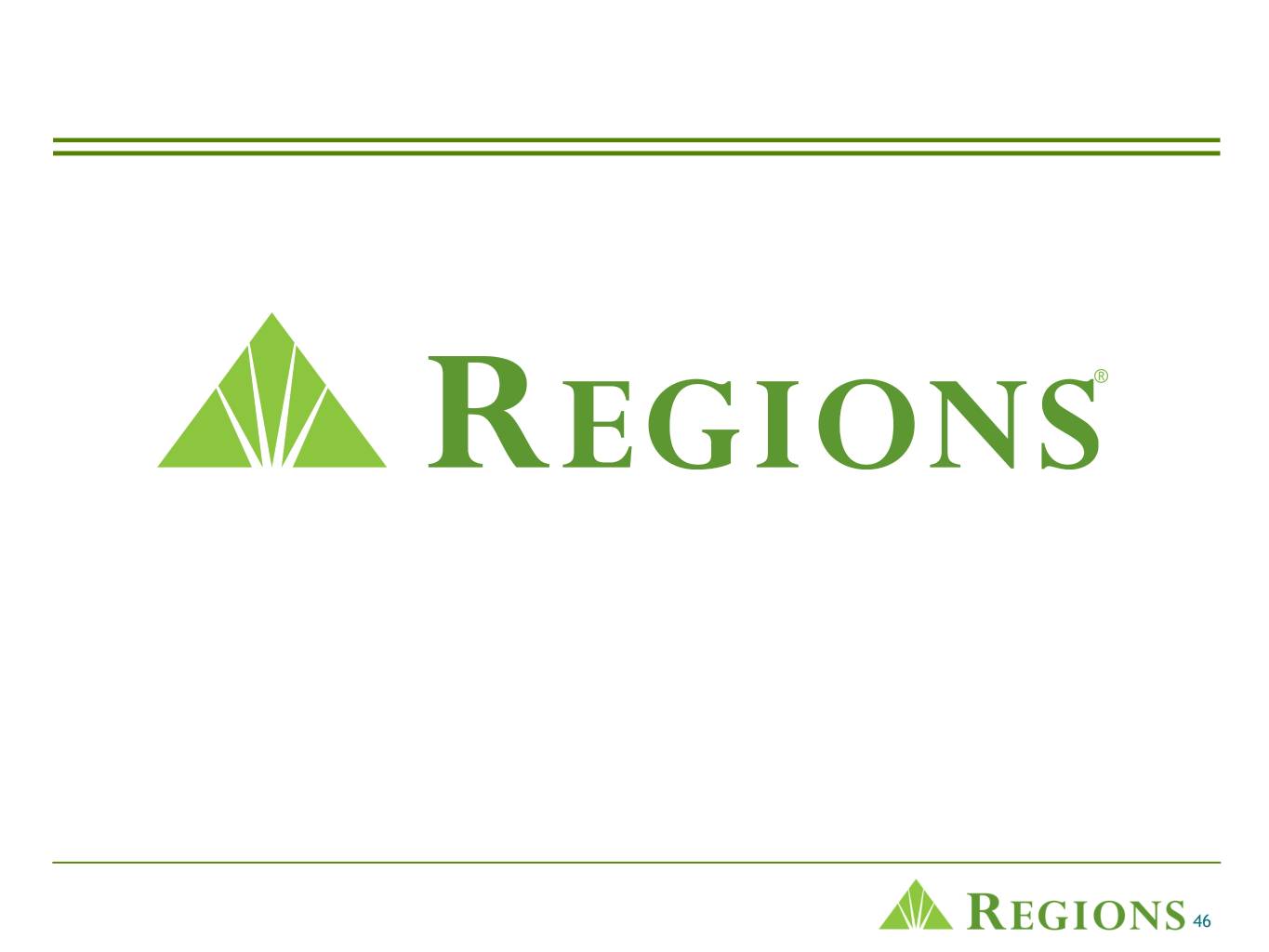
® 46













































